TWO
BUILDING A NATION OF CITIES
3
The Engine of Private Enterprise
New York 1820-70: commerce, canals, and sweatshops
The Typical American City Dweller is a commuter. He lives in one place, and from there he drives or takes a bus or subway to another place, where he works. For him there are two cities: a city of homes, a city of jobs. In daily alternations he delineates two of the essential elements of city growth, for it is the interaction between jobs and homes that shapes the city. The jobs pay for the houses and in part determine their location, but in part the location of jobs is governed by proximity to the houses. The interdependence speaks of much of the growth and development of our cities. This unity between commonplace experience and basic urban structure holds out great potentialities for the democratic control of our metropolitan world, but they have remained largely unrealized. The difficulty is that most citizens see themselves as men and women coping with the city and not as participants in its building.
The sheer size and extent of our cities overwhelms us. The interminable streets of houses, stores, offices, and factories, the incongruity between slums and suburbs, the intimidation of giant office towers, the flood of traffic, the infinity of government offices engender a sense of powerlessness. Such a sense has nurtured a depressed and defensive civic consciousness. We vote, but not so often as our ancestors; we turn out, a few of us at least, to defend our neighborhoods or our children in public hearings and school meetings; we join organizations, if it is required or if it is the custom of the place. But neither the politicians nor
the officers of our organizations seem able to do much to assist the family budget or to combat the dearth of good jobs, the decay of the neighborhood, the danger on the streets, the needs of a difficult child, the disaffection of young people, or the isolation of aged relatives. We do have a strong sense of home, even though many of us move from block to block or from subdivision to subdivision, and that sense can be touched by personal tragedy or by organized appeals for church and charity. It is nevertheless a circumscribed feeling and only a partial public manifestation of an essentially private life. For the most part we learn to take the job as it comes and the city as we find it.
A deep pessimism underlies this sort of adaptation to modern city life. We comfort ourselves in our helplessness by repeating the bromide that the system is at fault, that it somehow seems to work against people, not for them. On the job no one cares for good work, no one looks out for the other guy, no one wishes to take responsibility. And for all the years at school, the raises and fringe benefits, and the household gadgets, a comfortable home and a decent neighborhood are becoming harder and harder to find and to manage.
This commonplace reasoning from everyday experience is sound enough; it is the wisdom of people trying to cope with a hostile world. But it is self-regarding and self-defeating, and precludes any possibility of understanding the meaning and consequences of the catchall we use to express the generality of our experience the system. We speak often of "the system," by which we mean a set of nearly all-powerful outside forces that control our jobs, our homes, and our lives. Neither we nor our politicians are apt to speak of the system in terms that suggest what we might do to change it.
The very fact that an urban system exists, that we do not all suffer at random but are harassed by predictable, repeated, and identifiable interactions, creates the possibility for intelligent action and points to the hope for change. Since the thrust of our urban history has been toward ever more inclusive organization of our cities and ever greater integration of our national economy, it is clear that we now live in a period—as opposed to earlier, more loosely structured times—when problems connected with homes and jobs can be effectively politicized. We can reasonably expect that out of the conflicts that arise over the goals and means for the creation of new forms of city life, more humane urban environments will emerge. Our urban world is now so much a "system" that it could be managed by democratic planning if we wished to turn
our private complaints outward into political channels. The first step in turning outward is to understand the system we confront.
The interactions between the national economy and the urban business institutions largely determine the nature of both workplaces and residences. The detailed analysis and reordering of these interactions is an enormously complex subject requiring great expertise, but in general outline—in the broad terms in which goals and policy must be debated it can be made clear enough for anyone who wishes to study and understand it. Moreover, a historical review is one of the best ways to begin. The different modes of business and the varying forms of cities that have existed in the past reveal the elements of our urban system like a skeleton.
To understand why American cities are as they are, we must learn to look for two sorts of activities. First, we must seek repeated relationships in the fragments of our everyday experience. Ours is a highly structured society and these repetitions are its framework. Second, we must peer out from the city itself watch the license plates on the trucks moving along the freeway, if you will—to recognize the city as a part of a national economy. The repeated interactions between the national economy and the local business organizations create the jobs and fund the housing of the city.
First, structure. Our urban history is the history of the conflicts and possibilities wrought by the growth of the nation and the growth of the units of its organization. It is also a history of the increasing interconnectedness of these units, which stems from the development of the economy and its cities. The organization of these connections into repeated interactions is the structure of the economy and the structure of its cities. For example, one can speak of the structure of a city in terms of its land-use patterns or of its transportation networks, for both of these produce regular, repeated connections in an ordered way. In this brief history the general categories of urban structure will be two: the national network of cities and the patterns of land use within the cities themselves. The category of economic structure will be the urban business institutions—the proprietors, partnerships, and corporations.
The general trend of the past hundred and fifty years has been toward an expansion of the national urban network, both as a whole and in its parts. The number of cities in the nation has multiplied, almost all cities became larger, and the interaction among them has steadily increased. In a parallel fashion the size of business units and the inter-
actions among them increased; small shops became giant factories, partnerships grew to corporations and then to conglomerate corporations of corporations, while the volume of business transactions, bank loans, sales, and shipments proliferated. Finally, the size of the units of land use in cities and the interactions among them increased. Mixed blocks of shops and houses gave way to specialized districts, business or residential, and whole suburbs and satellites of one class or one group of businesses emerged. Simultaneously the number of trips, messages, and exchanges within and among these enlarged areas rose in volume.
Our urban history, however, is not a simple tale of expansion. The general trend toward greater size and greater interconnectedness always contained the opposing characteristics of centralization and decentralization. Centralization looked toward the efficiencies to be realized from such expediencies as the gathering of all the steel producers into one city, such as Pittsburgh, or the unifying of many steel firms into one corporation, such as United States Steel. Decentralization looked toward the advantages of specialization obtainable from such practices as the locating of steel mills near different cities, as at Buffalo, Chicago, or Detroit, or the multiplication of the number of steel companies by having some specialize in bridges, some in rails, others in wire or structural members. In various periods of our history entirely different combinations of cities, businesses, and urban land use have appeared in response to the advantages of centralization and decentralization. In our own time we have highly centralized business organizations, highly decentralized business activities, and highly decentralized cities, and thus enjoy a wider range of possibilities for organizing both urban and economic structure than ever before.
To comprehend the boundaries of our current freedom we must look to the historical interactions among the national economy, business organization, local jobs, and local housing. The urban system that governs this set of relationships revolves around the interactions among the national economy, urban markets, and business organization.[1] For
[1] . I have taken this hypothesis of the relationship between city size, functional specialization, and the role of a city in the national network of cities from the modern empirical investigations of Beverly Duncan and Stanley Lieberson, Metropolis and Region in Transition , Beverly Hills, 1970, pp. 29-116; and Otis D. Duncan et al., Metropolis and Region , Baltimore, 1960, pp. 209-11, 248-75. I am also indebted to the more theoretical work of Eric E. Lampard, "The Evolving System of Cities in the United States: Urbanization and Economic Development," in Harvey S. Perloff and Lowdon Wingo, Jr., eds., Issues in Urban Economics , Baltimore, 1968, pp. 81-139; and Wilbur R. Thompson, A Preface to Urban Economics , Baltimore, 1965, pp. 37-60. The use of the hypothesis for the 1820-70 period finds support in the New York data of Allan R. Pred, The Spatial Dynamics of U.S. Urban-Industrial Growth, 1800-1914 , Cambridge, 1966, pp. 163-85; Robert Ernst, Immigrant Life in New York City , New York, 1949; and Robert G. Albion, The Rise of New York Port: 1815-1860 , New York, 1939.
example, a change from small firms to large corporations affects the urban markets used by them. A few corporations may encompass the trade formerly handled by hundreds of independent salesmen or dozens of small firms. At the same time, the financial and sales power of the corporations may make it possible for them to sell bread or beer over whole regions like the Midwest or even throughout the entire nation. Similarly, the concentration of a specialty in a single city (like flour milling in Minneapolis) draws related firms to that city, creating a local enclave for wheat and flour, with attendant shipping offices, railroad yards, bag companies, and the like. If the specialty of the city is far-reaching, as is the case in flour milling, local business will be reorganized to reflect the national scale, and a few big companies will dominate the local urban economic life. Finally, changes in the national economy, signaled by a transportation change like a new railroad or natural-gas pipeline or by a new banking system such as that brought into being by the National Banking Act of 1864, may restructure both urban markets and business organization by favoring some cities over others, by aiding some firms in their search for capital or their reach for sales to the disadvantage of others. Out of these countless interactions came the jobs of the nation's cities, and the differential rates of growth of individual cities and their jobs governed the local markets for housing.
Long ago the circle of national economic conditions, urban markets, and business organizations was remarkably stable, changing only slowly over time. Consequently, prior to the nineteenth century the multiplication of cities and their growth was a comparatively slow process. But beginning in the late eighteenth and early nineteenth centuries a rapid and accelerating succession of changes in transportation and technology disrupted the stability of the past and brought about several almost total reorganizations within the urban system. New national economies, new markets, new businesses, new cities, and new urban structures have been spawned from these innovations. The angry citizens who today demand, for reasons of ecology or peace, that they be given control over science, space exploration, supersonic transport, or automobile emissions are attacking the vital sources of change in our society.
Transportation and technological change have influenced the urban system principally by creating opportunities for specialization and diversification. A new digger enables some farmer to specialize in the raising of potatoes, and a new road can also enable him to specialize by opening his farm to a wider market. In the same way a stitching machine for shoes, accompanied by good freight service to distant cities, may make a giant shoe factory thrive where none could have survived before. The same spectrum of changes in technology and transportation supports diversification of a city's economic activities, for if a city can reach new suppliers and new customers its merchants will be able to handle a greater variety of goods as well as a larger volume of them. The introduction of Rural Free Delivery postal service led directly to the rise of the great Chicago mail-order houses of Sears, Roebuck and Montgomery Ward—an outstanding example of a simple link between transportation and diversification. The introduction of the stationary steam engine in the 1850s made it possible for cities that had been commercially oriented to branch out into mechanized production and thus to compete along certain lines with older waterpower mill towns.
To trace the patterns made by the impact of transportation and of technological innovation upon the system of American cities, it is convenient to divide our modern history into three periods, 1820-70, 1870-1920, 1920-, and then to describe the special characteristics of each period.[2] In each we shall examine the state of technology and transportation, because it is from a particular technological climate and a particular configuration of transportation that the form of our cities and our business institutions inevitably takes shape. From these two determinants flow the national network of cities, the condition of the urban markets, and the kind of business structure that flourishes. Finally, we shall look at the end products of the entire system—the jobs and the residential structure within the cities.
The decades from 1820 to 1870 were the years of the perfection of hand tools and horse-powered machines, the use of waterpower and steam engines, and the invention of myriad tools to perform tasks
[2] . This periodization is copied from the one used so successfully by Lewis Mumford in his The Culture of Cities , New York, 1938, pp. 495-96. In this work and its predecessor, Technics and Civilization , New York, 1934, Mumford elaborated a scheme first proposed by the Scottish biologist Patrick Geddes, Cities in Evolution , London, 1915. The geographer John R. Borchert has proposed a similar ordering of American urban history in his summary article, "American Metropolitan Evolution," Geographical Review , 57 (July 1967), 301-32.
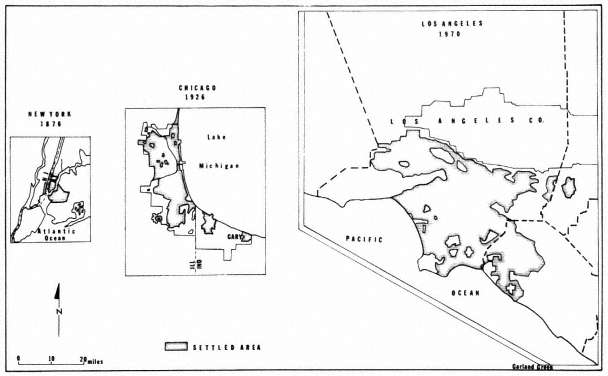
Figure III.
Expanding Size of the American Metropolis
SOURCE: O. W. Gray and Sons, The National Atlas, Philadelphia,
1876; Homer Hoyt, One Hundred Years of Land Values in Chicago,
Chicago, 1933; and U.S. Geological Survey maps.
formerly dependent on hand skills. But for all the new machinery, there was little mechanized production except in textiles and in some lines of ironworking. Most important, these were the years of the building of two new transportation networks, the water system of canals and steamboats, and the overland rail system. The new transportation gave rise to the big regional city and to the consequent organization of the economy around regional marketing and financial centers. Within business offices proprietorship and partnership prevailed, and in many cases the artisan competed with the sweatshop factory. Only a primitive specialization in respect to urban land existed, and the neighborhoods and districts of the big cities were highly mixed in their activities, ethnicity, and class.
In the second period, from 1870 to 1920, science and engineering reached a sufficient degree of inclusiveness to be systematically applied to all aspects of manufacture. Fully mechanized in-line factory production became the hallmark of the era. Electricity, the new energy source, replaced waterpower and surpassed steam in the flexibility of its use. The national rail network reached its ultimate limit and was supplemented locally by the electric street railway, the motor truck, and the automobile. These were the modes of production and transportation that created the giant industrial metropolis and the related multicity manufacturing belts of the Northeast and Midwest. These sprawling urban regions, organized about New York and Chicago, both produced for and marketed for the nation. Within the cities themselves everything tended toward giantism. The corporation controlled American economic life. Armies of workers, gathered into factories, attempted to unionize so that they might redress the balance of power between labor and corporate management. Urban land, responding to the pressures of intense economic organization, itself became highly specialized. The central hive of the downtown district, with its department stores, office skyscrapers, hotels, railroad stations, loft manufacturing, and warehouses, was the most dramatic outcropping of specialized land use. Other uniformities also emerged. The industrial sector and satellite, the strips that sheltered the factories and suburban mill clusters, radiated from the central city. Simultaneously, the daily movement of passengers by the electric street railway encouraged commuters to cluster by class, ethnicity, and race. Colossal scale, centralization, and segregation were the telling signs of the industrial metropolis.
In our own time, that is in the years since 1920, more far-reaching science and more sophisticated technology have multiplied products for
common consumption and raised standards of living so much that more and more of the economy has turned away from farming, mining, and manufacturing into the provision of services, the seeking of international business, and the prosecution of foreign wars. New modes of transportation by express highway, airplane, and pipeline have made possible a rapid multidirectional movement of goods and people in tremendous volume. Production has accordingly been freed from a limited number of products and single locations to attune itself more finely to its markets. In the contemporary adaptation, business both builds multiple plants to capitalize on particular regional opportunities and expands the range of its products to meet specific demands of various kinds of customers. Atomic power has arrived to supplement the conventional generation of electricity, and the terror implicit in its military uses has provided an important rationalization for the undertaking of the disgraceful task of world domination.
The new high-production, high-service economy gave rise to a characteristic urban structure—the megalopolis. Three megalopolises are so far identifiable, the Northeastern, Midwestern, and Californian. These are multicity, multicentered urban regions, distinguished from the former manufacturing belts by the huge volume of exchange within them, the almost continuous low-density settlement, and the sharing of business activities among the many urban nuclei. Here layers upon layers of economic specialties facilitate the production and marketing of highly complicated products and services. Within the megalopolises, as within the nation as a whole, private and public corporate enterprise has continued to elaborate. The corporation's concentration of political and economic power, with its use of telephonic communication, cost accounting, and computers, makes for giant scale and extreme centralization. The corporation's multiple activities, its search for good marketing locations, and its allocation of responsibility to branches and divisions, however, exhibit a tendency to decentralization that resembles the proliferation of centers, government agencies, and branches in the megalopolis itself. These contradictory impulses toward centralization and decentralization suggest a potential for flexible economic planning that can satisfy many publics and diverse demands. At the same time, the vast increase in bureaucratic work in both private and public corporations has moved the white-collar worker, his employers, and his suburbs into the forefront of urban development
In land use, the clusters of the megalopolis have become more and
more specialized and segregated. Shopping strips, one-class suburbs, black ghettos, and industrial parks dot the urbanized region. Even the old industrial metropolis's downtown, so formidable a monument fifty years ago, has turned into an office and financial center, while its retailing, wholesaling, and manufacturing have been scattered all over the megalopolis. Residentially, various kinds of segregation have replaced the single-centered geographical organization of races and classes of the former era. Like the opposing tendencies within the corporation, the intensity of the social forces of specialization and segregation are countered by the vast extent of the megalopolis. The conflicts between prejudice and parochialism on the one hand and between low density and large open areas for rebuilding on the other suggest tensions that could offer a much broader range of urban choices than ever before.
To serve as examples of each period, we will focus on typical large cities in each era; New York 1820-70; Pittsburgh and Chicago 1870-1920; and Los Angeles 1920-. Although each one will be dealt with as an archetype of its day, it should be realized that, despite remains of old neighborhoods and the persistence of past business specialties and urban styles, the power of the urban system is such that today metropolitan New York and Chicago resemble Los Angeles more than their former selves. Small cities could have served as well to reveal the skeleton of our urban system, but since we are now a nation in a state of panic over the conditions within our large cities it seemed most useful to concentrate on metropolitan history. Finally, since the history of the American urban system is a long one, it will be divided into three parts: first, the rest of this chapter, on the era of the big city; second, a chapter on the industrial metropolis; and third, a chapter on the megalopolis and the boundaries and potentialities of our urban world.
The Big City: 1820-70
No period of our history has surpassed the first half century of industrialization in its rate of change. Never again did the rate of urbanization climb so sharply. Not only did Americans conquer and settle the continent in these five decades, but their way of living on the land underwent a complete metamorphosis in which a national system of cities mobilized scattered villages and farms into a network of regional commercial and manufacturing centers. This sudden reorganization of American life, the forcing of a rural society into an urban mold, exacted a terrible toll
in everyday life. Nineteenth-century urbanization and industrialization inflicted punishment and suffering on city dwellers and tore at the fabric of society in the same ways that today's neglected cities do. Never were conditions more exploitative and dangerous to human life, but they were experienced in such a scattering of small factories, stores, and houses that no sustained labor movement could be organized to cope effectively with the new discipline. Yet cities of every size boomed with the possibilities that flowed from new resources, new methods of transportation, new ways of doing business, and new ways of making things.
Technological innovations, simple machines and inventions, were directed toward the products most basic to an agricultural society. The essence of industrial design in these years lay in perfecting simple, cheap products that could be sold in quantity to farmers: clocks, food mills, stoves, oil lamps, wagons, buggies, sewing machines, and the like. Such was the proliferation of devices and techniques turned out by trained engineers and scientists, as well as by gifted mechanics and tinkerers, that the foundations for the fully mechanized economy of the future were securely laid down.[3]
Inventions of the first era, then, attacked the basic concerns of food, clothing, housing, and transportation. In agriculture, tools like axes, scythes, and shovels reached a high level of perfection, taking on the enduring forms in which we use them today.[4] Similarly our alarm clocks, as well as the coffee mill and food grinder, eggbeater, metal spoon, and ice-cream freezer of our own kitchens, replicate designs of these inventive years. By harnessing horsepower to farm tasks formerly executed by hand, a great breakthrough was achieved in extending the scope of agriculture. Plows, mowing machines, hay rakes, reapers, and threshers broke the confines of the past which had tied armies of farm workers to the seasonal preparation of the land and to the harvesting of staple crops. Continuous, almost automated flour milling and an assembly-line process of butchering and meat packing slashed labor costs and permitted the large-scale production of these key farm items. The formerly ubiquitous icebox was also an invention of these years, and at the same time the technique of cooling chests and whole rooms by ice
[3] . This description of the process of early technological change rests on a brilliant article of Dorothy S. Brady, "Relative Prices in the Nineteenth Century," Journal of Economic History , 26 (June 1964), 145-203.
[4] . Sigfried Giedion, Mechanization Takes Command , New York, 1948, pp. 141-49.
was mastered.[5] Methods providing for the safe canning of meats, fruits, and vegetables were introduced. By 1870 the United States possessed the basic components for a range of modern food products. Farm and city dwellers were alike freed from the limitations imposed by the short list of cheap all-year staples formerly available to them; to cornmeal, wheat flour, salt fish and salt meat, dried fruit and vegetables, and whiskey and beer were now added much more than merely local and seasonal supplements. One historian has underlined the change by noting that toward the end of this era the workingman could expect to find on his table such delicacies as fresh fish chowder and apple pie with some regularity.[6]
The textile and clothing industries were revolutionized by the importation of British techniques and by further advances in American inventions, and the cost of these necessities was drastically cut for farmer and city dweller alike. During the first decades of the nineteenth century, fully integrated cotton mills, performing every operation from spinning and weaving to finishing and printing, came into production in New England and elsewhere in the Northeast. They were soon followed by woolen mills and by a parallel improvement in water turbines to drive the mills.[7] In the same years the manufacturers of rifles—the most expensive tools purchased by the early nineteenth-century farmer—perfected what was then termed the "American system" of using interchangeable parts. In time the same methods enabled the machine shops of the East to invent and build milling machines and other metalworking tools which could turn out boxes of identical parts. Accordingly, when the practicable sewing machine was invented in 1846 these new techniques were at hand for its mass production and for its distribution for home and factory use. By the time the Civil War broke out, cloth and clothing were thoroughly modern machine-made products.[8]
In construction, a succession of inventions for the manufacture of hardware, windows, doors, stair parts, flooring, and uniformly sized
[5] . Oscar E. Anderson, Jr., Refrigeration in America , Princeton, 1953, pp. 14-70.
[6] . Brady, "Relative Prices," 192.
[7] . Robert B. Zevin, "The Growth of Cotton Textile Production after 1815," and Peter Temin, "Steam and Waterpower in the Early Nineteenth Century," in Robert W. Fogel and Stanley L. Engerman, The Reinterpretation of American Economic History , New York, 1971, pp. 122-47, 228-37.
[8] . Carroll W. Pursell, Jr., "Machines and Machine Tools, 1830-1880," in Melvin Kranzberg and Carroll W. Pursell, Jr., Technology in Western Civilization , I, New York, 1967, pp. 392-405.
lumber united with the balloon-frame pattern of nailed beams and boards to cut the costs of building.[9]
The inventions that appeared between 1820 and 1870 saved an incalculable number of man-hours, skilled and unskilled, but by today's standards the cumbersome use of the tools still required a great deal of supporting labor. A farmer had to drive the team that pulled the new reaper; each machine tool needed an operator to feed and guide it; textile mills still depended on armies of women and children to tend the looms and spinning frames. Customarily the machine at this time performed only a single step in the total process; it stitched the seam but not the buttonholes, it sewed the soles but could not form the last, it cut door parts that had to be glued, assembled, and sanded by man. Flour milling was almost fully automated, but the frequently cited meat-packing assembly line was nothing more than a way to move the work past a row of skilled men. The partial introduction of machines and the partial redesign of products, together with the small and often seasonal scale of many markets, meant that in every shop from iron foundries to shoe factories there was a considerable volume of discontinuous handwork. There was much carrying of things from one machine to the next, of setting them up for one batch and then turning to the next, and short runs of products went back and forth from machine to hand to machine.
Innovations in transport resulted in the creation of two new networks that gave the inventions a revolutionary impact, and the networks had the effect of making each invention reverberate throughout the urban system. All the elements of the urban system were themselves transformed by the new transportation, and the changes were felt in urban markets, the structure of business, and the national economy. It was transportation that made the building of a national network of cities possible even while it revolutionized the social conditions within them by vastly enlarging the economic opportunities for thousands of small businessmen.
America built its canal system in two spurts, from 1815 to 1834 and from 1836 to 1854. In the first period more than two thousand miles of canals were built to connect the Atlantic port cities with each other and with the cities and towns of what was then the West. The river steam-
[9] . Dorothy S. Brady, "The Effect of Mechanization on Product Design in the Course of Industrial Development," Third International Conference of Economic History , Munich, 1965, pp. 7-15.
boat and the canal were complementary; the steamboat made upstream travel swift and reliable, cutting the time of the journey from weeks to days and hours, and canals flowed through land formerly accessible only by difficult overland pathways. By substituting an easygoing hitch of one to three horses or mules for the straining teams of the past, freight costs were cut by 90 percent. On the Erie Canal in New York, the most successful of them all, average rates for a ton-mile of goods moving from Buffalo to New York City fell from nineteen cents in 1817 to two cents and finally to one cent after some years of operation.[10]
As the second canal boom went forward, extending existing lines and adding new Western ones, the railroad and its companion the telegraph stepped up the possibilities for high-speed travel and communications. The first railroads of the 1830s radiated from the old port cities like Baltimore and Boston to garner nearby trade. In the 1840s small cities like Albany and Binghamton in New York State made local efforts of the same sort, and big cities turned to the financing and promotion of long Western rail lines that added all-weather intercity routes to the canal connections. The railroads, unlike the state-financed canal routes, were very much the products of the cities themselves. Whether one thinks of giant projects like the Eastern Division of the Union Pacific and the Pennsylvania Railroad or of little local runs like the Albany and West Stockbridge, we find behind them Kansas City, St. Louis, Pittsburgh, Philadelphia, and Albany as prime movers as well as beneficiaries.[11]
Compared to anything that had gone before, the railroad was a wonderfully versatile transportation invention. It could cheaply join a series of small coal valleys in Pennsylvania to a canal or a larger rail complex, or it could tie together the mill towns and cities of New England. It could as readily fan out over the prairies, as it did in Illinois, opening an entire state to market agriculture. In 1840 there were three thousand miles of rails and three thousand miles of canals; by 1854 one could travel by rail all the way from New York to Chicago and St. Louis. Fifteen years later the Union Pacific and the Central Pacific
[10] . Carter Goodrich, ed., Canals and American Economic Development , New York, 1961, pp. 172, 184-85, 227-29.
[11] . Harry H. Pierce, Railroads of New York, A Study of Government Aid 1826-1875 , Cambridge, 1953, pp. 115-16; Charles N. Glaab, Kansas City and the Railroads: Community Policy in the Growth of a Regional Metropolis , Madison, 1962, pp. 103-23.
joined to complete a transcontinental line; in a mere half century the country had undergone a thoroughgoing revolution in transportation.[12]
The powerful effect of emerging transportation upon society and its economy stemmed precisely from its ability to widen the market opportunities of everyone it served. By widening the market, that is by increasing the number of potential customers, specialization was always encouraged. Why specialization? Because in almost all cases profits may be augmented by a concentration on those crops which grow best on a given piece of land, on those products which can be made most cheaply, or on those goods most easily bought or handled in volume. For example, New York merchants trading in general metal products turned to the importation of copper or tin or railroad iron, or they became dealers in blacksmith supplies or in simple hardware for country stores.[13] The expanded grasp of the city in turn fostered rural specialization. Upstate farmers responded to the faster and cheaper transportation by switching from the few limited cash grain crops of the past to orchards, dairies, stock farms, and wool. In the process their prosperity swelled the market for manufactured goods and city services.[14]
By myriad interactions a process of development stimulated by transportation had begun. Ease of transport led to more specialized and more efficient methods of agriculture which in turn extended the markets for farm products, and the increased prosperity of the farmers gave rise to cities to supply them with a rapidly lengthening list of comforts and necessities, such as loans, hand tools, farm machinery, pots and pans, food mills, furniture, pumps, clothing, and so on and on. In this interaction lay the workings of the urban system, the truth behind the bombast of railroad Congressmen, state canal promoters, and town and city merchants, all of whom habitually hailed every road, canal, rail, or telegraph line as an "improvement."
Indeed, transportation did transform the national network of cities, changing it from a string of small commercial Atlantic coast cities into a
[12] . George R. Taylor, The Transportation Revolution, 1815-1860 , New York, 1951, pp. 32-103.
[13] . The interaction between firm specialization and sales area is neatly documented in Elva Tooker, Nathan Trotter, Philadelphia Merchant, 1787-1853 , Cambridge, 1955, pp. 108-31; for Trotter's competition, see Albion, The Rise of New York Port: 1815-1860 , pp. 248-49.
[14] . Clarence H. Danhof, Change in Agriculture: The Northern United States, 1820-1870 , Cambridge, 1969, pp. 4-23.
continental complex of trading centers to which were added a scattering of wholly new specialized manufacturing cities. In 1820 the nation possessed but five cities (New York, population of the present five boroughs 152,000; Philadelphia, 65,000; Baltimore, 63,000; Boston, 43,000; New Orleans, 27,000). Half a century later the leading commercial centers had grown into cities of more than a quarter of a million inhabitants. The placement of these cities reflected their functions as import-export centers joining Europe to the United States via the ocean and railroads, and as assemblers and distributors of goods through the continental United States (1870 population figures: New York, 1,478,000; Philadelphia, 674,000; St. Louis, 311,000; Chicago, 299,000; Baltimore, 267,000; Boston, 251,000). To support these six big cities, forty-five cities having populations ranging from twenty-five thousand to a quarter of a million had grown up along with them (Table 1 ).
The national network of six big cities and forty-five lesser ones reflected the extent of the organization of the national economy achieved
TABLE 1 | |||||||||||
Towns | Cities | Metropolises | Total Urban | ||||||||
% U.S. | % U.S. | % U.S. | % U.S. | ||||||||
No. | Pop. | No. | Pop. | No. | Pop. | No. | Pop. | ||||
1820 | 56 | 3.58 | 5 | 3.63 | - | - | 61 | 7.21 | |||
1870 | 612 | 9.86 | 45 | 6.74 | 6 | 8.21 | 663 | 24.81 | |||
1920 | 2,434 | 15.23 | 263 | 16.00 | 25 | 19.64 | 2,722 | 50.87 | |||
1970 | 5,520 | 28.34 | 859 | 24.03 | 56 | 20.75 | 6,435 | 73.12 | |||
Population by Size Groupings | Total Population | ||||||||||
Towns | Cities | Metropolises | Urban | U.S. | |||||||
1820 | 344,000 | 349,000 | - | 693,000 | 9,618,000 | ||||||
1870 | 3,933,000 | 2,689,000 | 3,280,000 | 9,902,000 | 39,905,000 | ||||||
1920 | 16,218,000 | 17,030,000 | 20,910,000 | 54,158,000 | 106,466,000 | ||||||
1970 | 57,577,000 | 48,829,000 | 42,151,000 | 148,557,000 | 203,166,000 | ||||||
Note : All cities are assigned population according to their changing political boundaries except New York, which is listed as one city of five boroughs in all periods. The Towns category in 1970 includes unincorporated urban fringe areas of 2,500 or greater numbers of inhabitants. Calculations were made from US. Bureau of the Census, Historical Statistics of the United States, Colonial Times to 1957 , Washington, 1960, p. 14; Fourteenth Census of the U.S. 1920 , 1, Population , Washington, 1921, pp. 62-75; Statistical Abstract of the U.S.: 1971 , Washington, 1971, p. 17. Some disagreement in detail exists among these sources, and in such cases the Fourteenth Census has been followed because it gave specific listings of city populations by name of city. | |||||||||||
during the years 1820-70.[15] All fifty-one cities constituted an integrated commercial interdependency, a hierarchy of trade governed by New York and supervised by the regional centers of Philadelphia, St. Louis, Chicago, Baltimore, and Boston. Banking and wholesale trade in farm staples and some manufactured goods were controlled by the market rates and prices in these national and international trading centers.[16] Wheat, cotton, corn, banknotes, bonds, cloth, iron, books, and all manner of goods for which there were large markets were traded in the regional centers, but with an eye to New York and ultimately to Atlantic demand and prices. Regional bankers and merchant houses maintained correspondents and agents in New York to keep them posted and to negotiate for purchases and sales. In view of these financial and commercial linkages, the United States in 1870 could be said to be an integrated national economy organized around its major city markets.
The entire economy, however, was as yet only partially organized on a national basis because manufacturing had not yet settled into the pattern whereby each specialty located in its best site, and from such a single base or cluster of bases sold its products throughout the nation. In 1870 such common items as stoves, hardware, kitchenwares, farm machinery, steam engines and locomotives, carriages, wagons, clothing, and shoes were being manufactured in cities and towns all over the United States. The network of cities reflected this fragmented and overlapping placement. The six largest of them had added a wide range of manufactures to their commercial base and were producing an extraordinary variety of goods from fur muffs and gas lights to ships and steam engines. In the duplication of effort, Philadelphia's furniture mills made the same Windsor chairs as their Boston, New York, and Chicago counterparts, while the Philadelphia weavers made a line of goods from mosquito netting to muslins, repeating the line of the textile towns in New York and New England. Such repetitiousness reflected the mixed
[15] . The forty-five cities in rank order were: Cincinnati, New Orleans, San Francisco, Buffalo, Washington, Newark, Louisville, Cleveland, Pittsburgh, Jersey City, Detroit, Milwaukee, Albany, Providence, Rochester, Allegheny (now part of Pittsburgh), Richmond, New Haven, Charleston (South Carolina), Indianapolis, Troy, Syracuse, Worcester, Lowell, Memphis, Cambridge, Hartford, Scranton, Reading, Paterson, Kansas City (Missouri), Mobile, Toledo, Portland (Maine), Columbus (Ohio), Wilmington (Delaware), Dayton, Lawrence, Utica, Charles-town (Massachusetts), Savannah, Lynn, Fall River, Springfield (Massachusetts), and Nashville. U.S. Bureau of the Census, Fourteenth Census of the U.S.: 1920, Population , Washington, 1921, p. 81.
[16] . Duncan and Lieberson, Metropolis and Region in Transition , pp. 43-58, 116.
tendencies of the times, for each big city was in part a market unto itself and produced for its own region, even while it was also a dealer in outside goods now beginning to be produced for national markets. It took perfection of the rail network and the organization of the large corporation to put an end to these anomalies.
The lesser cities reflected the same lack of national specialization in manufacturing. In the list of forty-five stood commercial cities whose principal activity lay in trading with their rural hinterlands, as had Baltimore and Boston in previous years. Such cities as New Orleans, Memphis, Indianapolis, Kansas City, Portland (Maine), and Rochester served their local regions with imported goods and traded as well in the local specialties of sugar, cotton, corn, cattle, grain, and lumber in the traditional manner of commercial cities. Their rapid growth over a half century reflected the settlement of the continent and the impact of river, canal, and rail transportation on growth and diversification. Other cities on the list represented the new industrial specializations for large-scale production: Lowell, textiles; Reading and Scranton, anthracite; Providence, machine tools; Hartford, guns; Utica and Troy, textiles and machinery. In some cases an industrial specialty contributed to a commercial city's growth, as did ironworking in Pittsburgh, meat packing in Cincinnati and Chicago, and oil refining in Cleveland. To appreciate fully the contribution of early manufacturing to the urbanization of the United States, one has only to consider the case of the still largely rural South, which had only eight cities on the national list of 1870. Although scholars disagree concerning the reasons for the retarded urbanization and industrialization in the region south of the Ohio and east of the Mississippi River, its agricultural economy in 1870 resembled an underdeveloped eighteenth-century colony and had little in common with the boom conditions of the Northeast and Midwest.[17] One can perceive the lineaments of the future growth of the two great manufacturing belts in the 1870 mixture of cities, factory towns, and commercial centers which had already grown up there.
Just as the national network of cities had transformed the lives of American farmers, so the sheer magnitude of these new cities radically affected the lives of city dwellers. The metropolises were after all five to ten times as large as the leading cities of half a century before, and it is not an exaggeration to maintain that in the years from 1820 to 1870 no
[17] . Douglass C. North, The Economic Growth of the United States, 1790-1860 , Englewood Cliffs, New Jersey, 1961, pp. 4-7, 189-203.
important facet of urban life was left untouched by the rapid change in scale. Yet the setting for these changes would now appear strange to us because the cities of the 1820-70 era were so different from our own. They were cities of storekeepers and small sweatshop factories, of businesses run by one boss or a few partners, of the scattering of shops and workrooms among residences, of mixed neighborhoods of rich and poor, native and immigrant, and of strong smells and slovenly habits coexisting with stiff and polished propriety.
The enlarged markets for the sale of goods within the cities worked in two ways to change the organization of business and the nature of urban jobs. First, as the city grew so did its needs, and residentiary industries such as little local bakeries spread through the neighborhoods of the city.[18] Second, export industries were bound to multiply and expand when a city could sell to a broader region around it. For example, New York's cracker industry grew lustily to sell barrels of hard crackers far and wide to country stores and to ships' captains. In many cases local and distant markets overlapped. New York sold steam engines to shipbuilders and factories in the immediate environs even as it exported them to distant mills; it made the same line of clothing for local workingmen that it made for country stores or Southern plantations.
The new markets relentlessly favored a different kind of businessman, called in those years a contractor or capitalist, whom today we could perhaps best describe as a hustler. Inventions were important in the reorganization of business by small proprietors and partnerships, but since early machinery served at most as a substitute for a few hand tasks, the principal gains in production accrued to bosses who could organize their shopworkers for a steady production of uniform output. These emerging businessmen recruited labor from the old independent artisan shops where a complete product had been made by one man, or by a couple of men assisted by a boy or a family. They moved artisans, unskilled immigrants, women, and children into their own shops, where they could watch over them. Or they carried unfinished garments and products from shop to shop and tenement to tenement, issuing the strictest instructions for their completion. Instead of waiting for orders from individual customers to come in the door, these capitalists solicited
[18] . Sam Bass Warner, Jr., "The Feeding of Large Cities in the United States, 1860-1960," Third International Conference of Economic History , Munich, 1965, pp. 83-87.
business from wholesale merchants and produced for the expanding anonymous urban market. By a combination of hard driving, strict supervision, and a certain amount of machinery, they transformed such cities as New York, Philadelphia, and Boston from artisan towns into hives of small factories and wholesale outlets (Table 2, page 93).
The transformation went forward even in the most ordinary and unmechanized activities. Often the old and the new existed side by side. In New York there was still work in 1870 for the carpenter who followed the ancient custom of bidding on a house or two each year and doing most of the work himself, for the tailor who measured and fitted each suit individually, or for the wood carver who carried his tools from shop to shop, following his own preferences in employers. But higher rewards than a commonplace living wage awaited the man who determined to expand. A carpenter could become an entrepreneur by transforming himself into a contractor and hiring a mixed crew of men—some skilled but many unskilled—to install the new factory-produced windows, doors, moldings, and stairs. By rushing from job to job he could manage to erect whole groups of houses by his own energy and by driving his workers, and so enjoy the patronage of speculators in the city's periodic real-estate booms. He could grow wealthy while his old crew of skilled artisans and day workers would be left behind. Similarly a tailor might break down the skills of his craft into its components of cutting, basting, buttonhole making, and the like and place his unskilled or semiskilled tasks in the homes of poor women, children, and immigrants. He could prosper in the urban market for workers' ready-made clothing and could sell as well to the country stores whose merchants came regularly to the big cities to buy stock.
Well before sewing machines were invented, before tin ceilings or cast-iron store fronts were used, even before balloon-frame house construction had been popularized, the merchant capitalist and contractor came forward in the American city to reorganize its labor. These were the drivers of men who lengthened the workers' hours, abolished the holidays and self-determined comings and goings of independent artisans, broke down the craft traditions, and oriented the business of the city toward ever spiraling production and sales.[19]
[19] . John R. Commons, et al., History of Labour in the United States . I, New York, 1918, pp. 338-50; for the garment manufacture case, Oscar Handlin, Boston's Immigrants: A Study in Acculturation , Cambridge, rev. ed., 1959, pp. 75-77; for building trades, Brady, "Effect of Mechanization on Project Design," p. 12.
The cities of course had their inventors too, men who saw opportunity in the expansion of the day and made their fortunes by adding personal mechanisms and techniques to existing methods. In New York City, Peter Cooper (1791-1883), former wood carver, manufacturer of shears for the napping of wool cloth, and grocer, made the decision to compete with imported glue and gelatin. By careful attention to the details of manufacture and with the aid of a few inventions bearing on the processes, he was able to offer a cheaper and more uniform product than had been in use before. As New York and its markets grew, his glue boiling prospered magnificently.[20] There were many inventor-manufacturers like Cooper in the big cities of this period, such as the shipbuilding Stevens family in Hoboken in the port of New York and the machine-making Sellers brothers in Philadelphia, but invention also flourished in mill towns over the whole East and Midwest. In this era of tinkering, wherever there were machines there were inventors.
The big cities, however, did tend to have a particularly encouraging effect on inventions and in time more or less concentrated the innovators within their bounds. This encouragement was compounded of the complementary suppliers and marketing firms that surrounded them in the urban districts. Cooper, for example, had set his glueworks near the slaughterhouse of Henry Astor, where hooves were abundant and cheap. In these days before dressed meat could be shipped in refrigerator cars and indeed before there were cattle cars on the railroads for the shipment of livestock, cattle were driven to the city to be killed, and New York City was the slaughtering capital of the nation. Furthermore, the city's users of glue—shoemakers, bookbinders, furniture manufacturers, and so on—were located near at hand as ready consumers of his product, and he was thus dealing with America's largest wholesale and retail market. Although the city of this period was made up of a multiplicity of small firms—smaller in most instances than Cooper's glueworks—the clustering of complementary businesses made expansion easy.
The swelling of urban markets into a partially integrated national economy and the consequent transformation of business into a swarm of small aggressive production and marketing firms had drastic and enduring consequences for urban workers. The explosive growth of cities created something like a labor vacuum into which were sucked thou-
[20] . Allan Nevins, Abram S. Hewitt, With Some Account of Peter Cooper , New York, 1935, pp. 45-62.
sands upon thousands of rural migrants. A profound cultural shock ensued. Native workers had to face up to the reality of competing and coexisting with waves of foreign immigrants. To add to the difficulty of their adjustment, depressions and periodic mass unemployment now threatened their jobs for the first time in our history. The closer linkages of urban work to national and international sales made each city economy a captive of worldwide business cycles. Finally, the new stricter discipline and the growing size of shops and factories reversed the egalitarian trends of the early merchant-artisan city and instituted the deep class cleavages between hand workers and paper workers, between working class and middle class.
The nineteenth-century American city was a magnet for immigrants. From the 1820s onward, young men flocked to the city from American farms and towns as well as from European villages, towns, and cities. In the years before 1870, Great Britain, Ireland, and Germany supplied most of the immigrants (Table 3, page 168). Over and over, the story was repeated of the eager youth who, in seeking his fortune, accepted the heightened pace of work and the endless hours of labor as a challenge. He tried to work ever harder than his competitors, contributing his youth to the energy of the city. A tale of that period that speaks of boys from the New England countryside makes clear the standards of morality and behavior by which such newcomers were judged:
With a few dollars and a mother's prayer, the young hero goes forth to seek his fortune in the great mart of commerce. He needs but a foothold. He asks no more, and he is as sure to keep it as the light will dispell darkness. He gets a place somewhere in a "store." It is all store to him. He hardly comprehends the difference between the business of the great South street house, that sends ships over the world, and the Bowery dry goods shop with three or four spruce clerks. He rather thinks the Bowery or Canal street store the biggest, as they make more show. But wherever this boy strikes, he fastens. He is honest, determined, and intelligent. From the word "go" he begins to learn, to compare, and no matter what the commercial business he is engaged in, he will not rest until he knows all about it, its details—in fact, as much as his principals.
Another characteristic of the future merchant is this—no sooner has he got a foothold, than the New England boy begins to look for standing room for others. Perhaps he is the son of a small farmer who has several other children. The pioneer boy, if true blue, does not rest until one by one he has procured situations for all of his brothers. If he has
Illustrations
The Big City
Urbanscape
15. New York, 1849. Half a million people crammed into a jumble of small buildings, with single-family houses, boardinghouses, warehouses, factories, slaughterhouses, and churches—a typical early industrial hive. Eno Collection, New York Public Library, Astor, Lenox and Tilden Foundations
16. Boston, 1855. Four- and four-and-a-half-story shops and houses of the West End, masts of ships in the harbor behind Brattle Square church. Metropolitan Museum of Art, Gift of I. N. Phelps Stokes, Edward S. Hawes, Alice Mary Hawes, Marion Augusta Hawes, 1937
17. San Francisco, 1850-51. A regional trading city begins as a country town. Metropolitan Museum of Art, Gift of I. N. Phelps Stokes, Edward S. Hawes, Alice Mary Hawes, Marion Augusta Hawes, 1937
18. Broadway, New York, 1834. Unpaved street, with horse-drawn omnibusses, wagons, and carriages which passed busy sidewalks edged with storefronts, awning poles, and frames of streetside peddlers. Eno Collection, New York Public Library, Astor, Lenox and Tilden Foundations
19. Broadway, New York, 1870s. Public amenities of cobblestone pavement and gas lights have been added, and buildings have grown to five and six stories since 1834, but the traditional urban framework of full sun-lit streets with horse-drawn traffic and busy pedestrian sidewalks still contain the intense clustering of commerce and manufactures. New-York Historical Society
20. Hudson Square, New York, 1866-67. Relentless moneymaking left few open spaces in big cities of the early industrial era. Here, St. John's Church and houses for the wealthy of the Federal days provide a rare interval of urbane relief. New-York Historical Society
21. Fifth Avenue from 28th Street, New York, 1865. Ultimate amenities of big-city residential life: clean, paved streets and sidewalks, cabs at the curb, gas lights, cast-iron fences, basement kitchens, servants in the attic, modern plumbing, and an unbroken strip of brick and brownstone row house propriety, with a few young trees. New-York Historical Society
22. Working-Class New York, Canal and Mott Streets, ca. 1870. The workingman's big city, with factories, craftsmen's rooms, cheap retail stores, slum housing, in varied buildings—from old wooden houses and well-propor-
tioned Federal blocks to the new tall, narrow, heavy-corniced tenements of contemporary fashion. New-York Historical Society
23. West Washington Market, New York, 1880s. As the city's population grew, markets expanded from old neighborhood stalls, where housewives shopped daily, to specialized farmers' and grocers' wholesale distributing centers. Here, a market built in 1858. New-York Historical Society
24. West 133rd Street, New York, ca. 1877. Like today's suburban fringes, speculators' housing took up broken parcels of land at the city's growing outer edge. New-York Historical Society
25. Fifth Avenue, 116th and 117th Streets, New York, 1893. The fringe shanties of the poor. New-York Historical Society
Business
26. 168-172 Fulton Street, New York, ca. 1820. The shop and warehouse of the famous furniture maker Duncan Phyfe. Typical small-scale enterprise of the first era of industrialization. Metropolitan Museum of Art, Rogers Fund, 1922
27. 512-514 Broome Street, New York, 1935. The photographer Berenice Abbott in her Changing New York recorded extremes of the big-city era; two old houses towered over by a six-story warehouse, the limit of construction before the steel-frame skyscraper of the industrial metropolis. Museum of the City of New York
28. Coenties Slip, New York, ca. 1879. Three-to-four-story merchant warehouses and docks overshadowed by new elevated railway, whose high volume of traffic raised downtown land values until the traditional urban framework could no longer accommodate the enlarged scale of business enterprise. New-York Historical Society
29. Hudson Street, New York, ca. 1865. The big-city hive of small shops. New-York Historical Society
30. 480 Water Street, New York, ca. 1863. In the preindustrial era, barns and churches were the commonplace large structures. Here, a typical barnlike building serves as factory for a ship joiner making deckhouses. New-York Historical Society
31. Wall Street, New York, ca. 1878. A Sunday, presumably, at the heart of American finance, the small scale of early capitalist concentration. New-York Historical Society
Transportation
32. Coffee-House Slip, New York, 1830. Packet Lines offering abundant regulary scheduled sailings from New York to European and East Coast ports were a key to the city's mercantile supremacy. Eno Collection, New York Public Library, Astor, Lenox, and Tilden Foundations
33. Canal Boats, New York, 1852. Before the organization of wholesale lumber districts and grain elevators, shippers and canal boats carried small lots of farm and forest products to regional trading centers for manufacture and processing. New-York Historical Society
34. Highlands of the Hudson River, 1874. River artery of early industrial economy: sloops, schooners, canal boats under tow, the Albany-New York dayliner Mary Powell on the first New York thruway. New-York Historical Society
35. South Street, New York, 1880s. Square-riggers and small merchant warehouses, Atlantic links of the nation's first big city. New-York Historical Society
36. Grand Central Station at 42nd Street, New York, 1875. A deceptively small and elegant Paris-style hotel façade conceals the overarching power of the intercity railroad network. This new transportation system remade New York's economy into a national industrial metropolis, adding manufacturing to its established functions of finance and commerce. New-York Historical Society
37. Interior of Grand Central Station, New York, 1885. Such passenger train sheds were seen by contemporaries as symbols of the force of a new era. "What forces, what fates, slept in these bulks (great night trains lying on the tracks) which would soon be hurling themselves . . . through the night!" William Dean Howells, A Hazard of New Fortunes (1890). The French Impressionist Claude Monet painted seven scenes in and around Gare Saint-Lazare (1876-77), manifesting the same spirit. New-York Historical Society
38. General Motors Plant, Linden, New Jersey, 1967. Early nineteenth-century canal and railroad alignments permanently laid down the basic industrial skeleton of today's Northeastern megalopolis. Here, an auto assembly plant, fifteen miles from Manhattan along the old New York-Philadelphia transportation axis, U.S. Highway No. 1 (left) and Penn Central Railroad tracks (right). Regional Plan Association, Louis B. Schlivek
39. Grand Street Livery Stables, New York, 1865. The livery stable was the back-up transportation equivalent of today's truck and auto rental chains.
Their flies, manure, and smell were the bane of every neighborhood. New-York Historical Society
40. Greenwich Street Elevated, New York, 1867. Inventor of a cable-drawn engine, Charles T. Harvey, tries it out on the city's first el. New-York Historical Society
41. Greenwich Street Elevated at Ninth Avenue, New York, 1876. Typical American failure to adapt transportation innovations to the city's inherited framework. Here, old West Side working-class and industrial quarter is attacked by the new transit system. New-York Historical Society
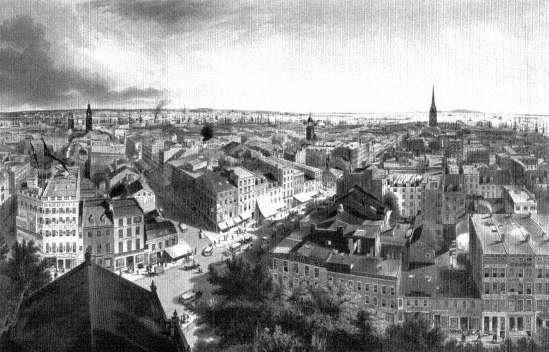
15.
New York, 1849
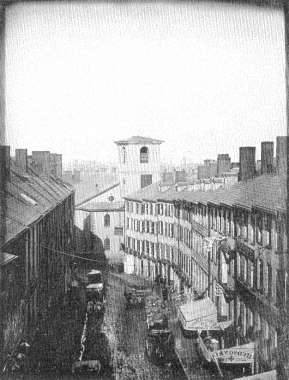
16.
Boston, 1855
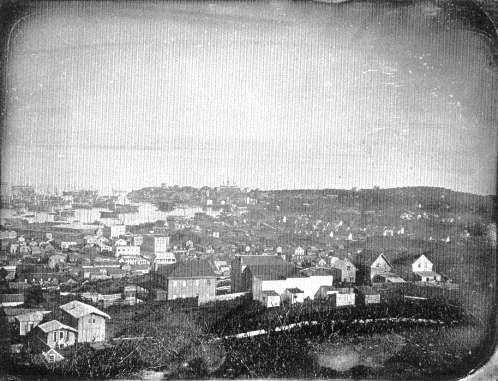
17.
San Francisco, 1850-51
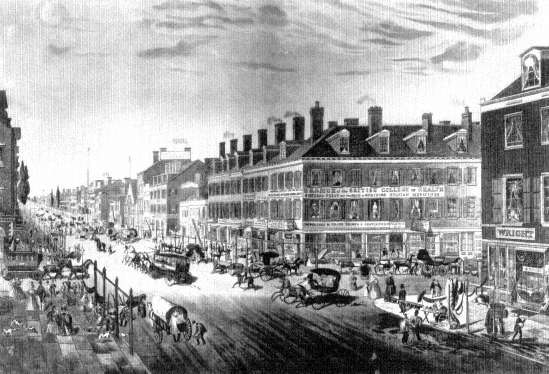
18.
Broadway, New York, 1834
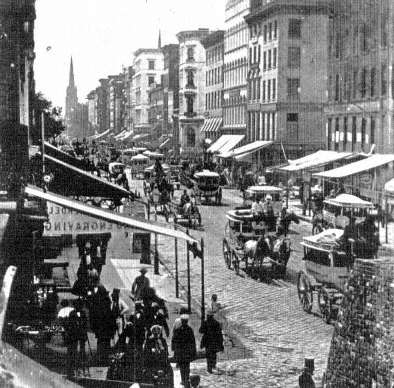
19.
Broadway, New York, 1870s
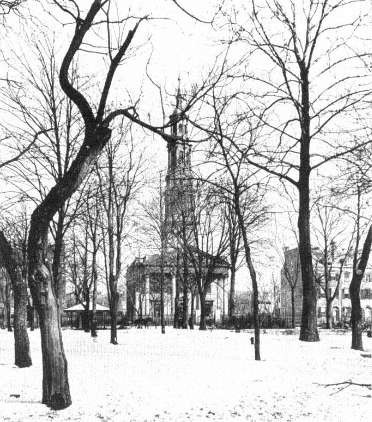
20.
Hudson Square, New York, 1866-67
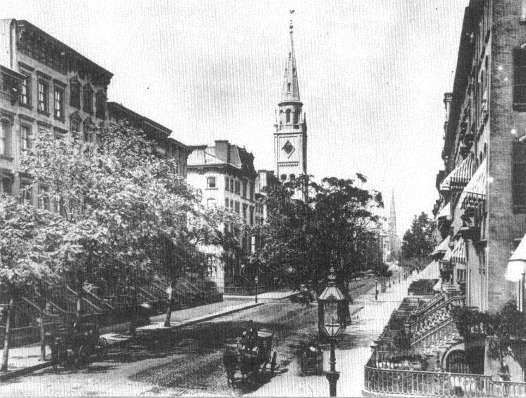
21.
Fifth Avenue from 28th Street, New York, 1865
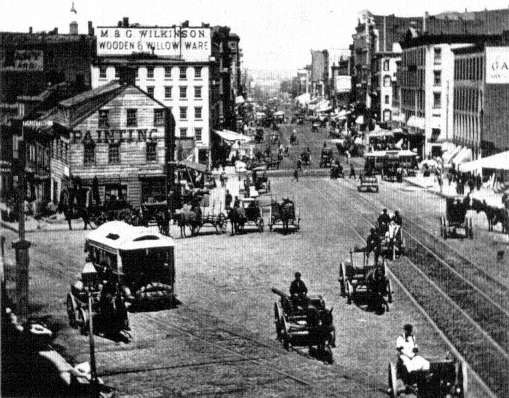
22.
Working-Class New York, Canal and Mott Streets, ca. 1870
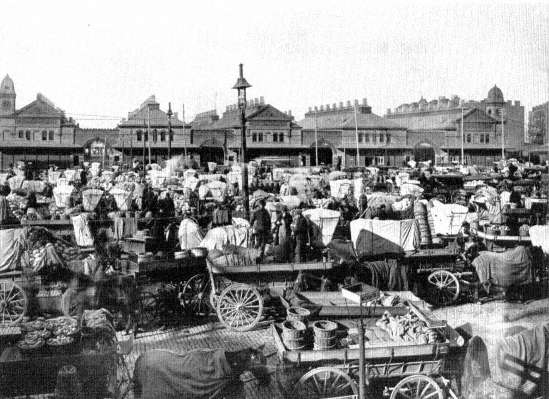
23.
West Washington Market, New York, 1880s
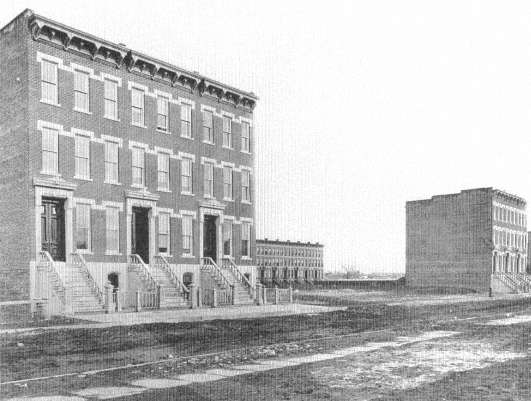
24.
West 133rd Street, New York, ca. 1877
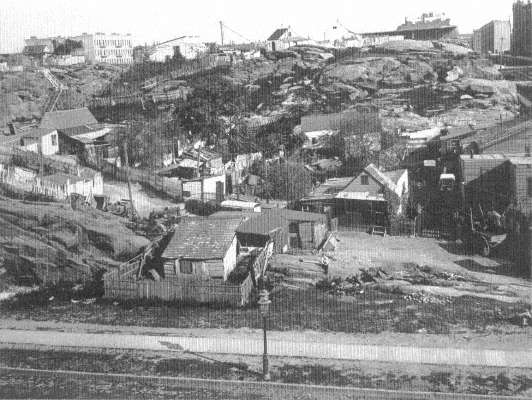
25.
Fifth Avenue, 116th and 117th Streets, New York, 1893
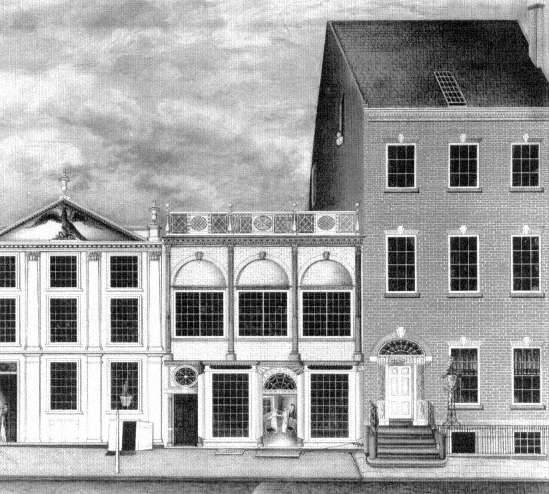
26.
168-172 Fulton Street, New York, ca. 1820
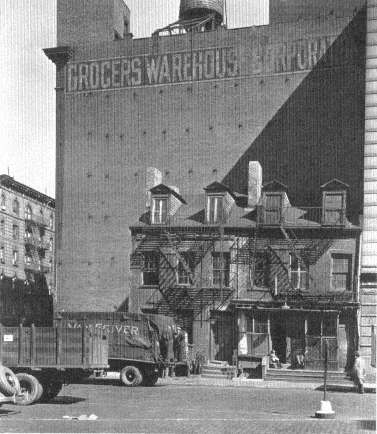
27.
512-514 Broome Street, New York, 1935
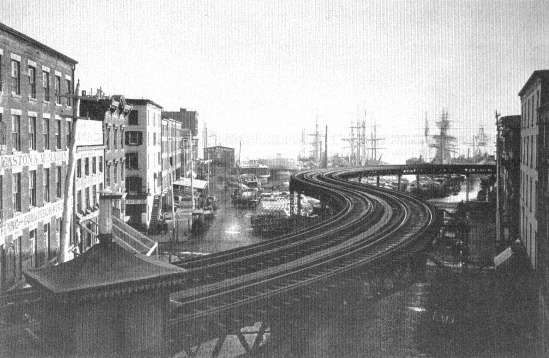
28.
Coenties Slip, New York, ca. 1879
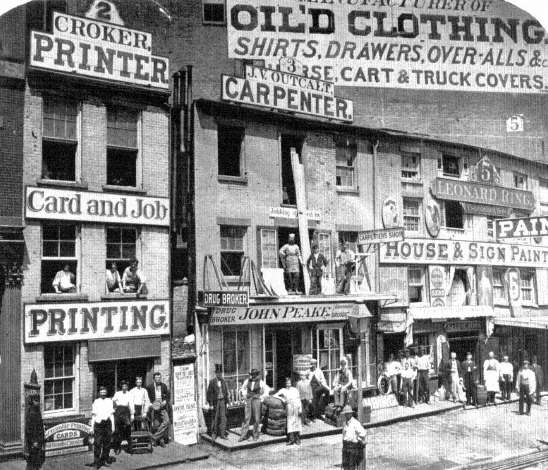
29.
Hudson Street, New York, ca. 1865
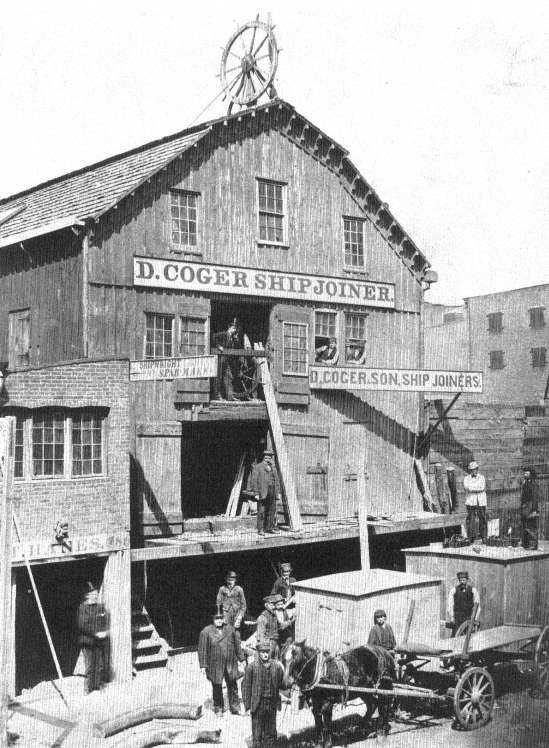
30.
480 Water Street, New York, ca. 1863
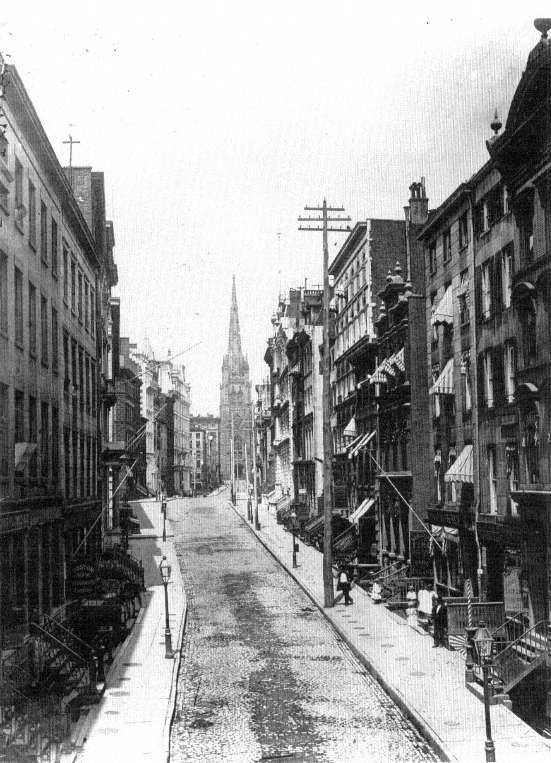
31.
Wall Street, New York, ca. 1878
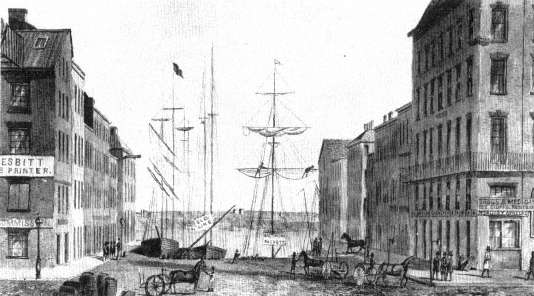
32.
Coffee-House Slip, New York, 1830
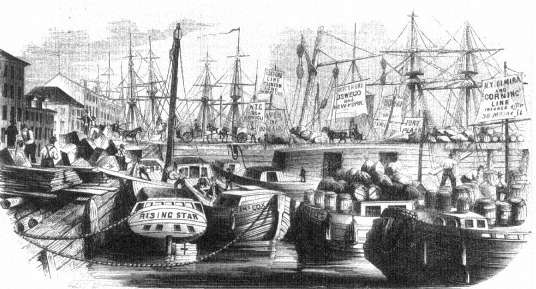
33.
Canal Boats, New York, 1852
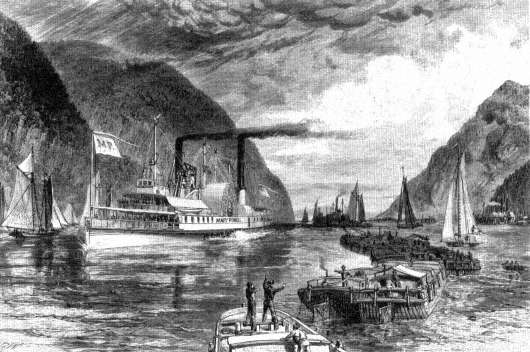
34.
Highlands of the Hudson River, 1874
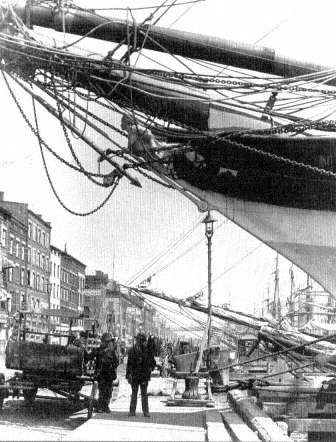
35.
South Street, New York, 1880s
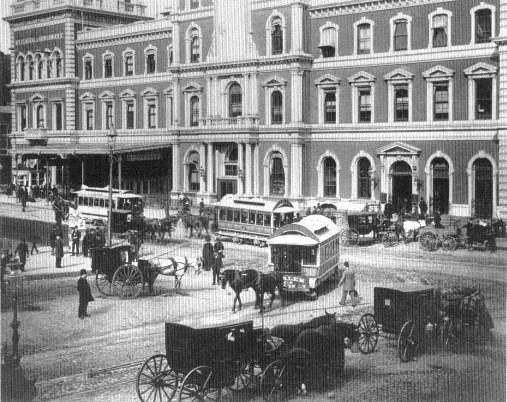
36.
Grand Central Station, New York, 1875
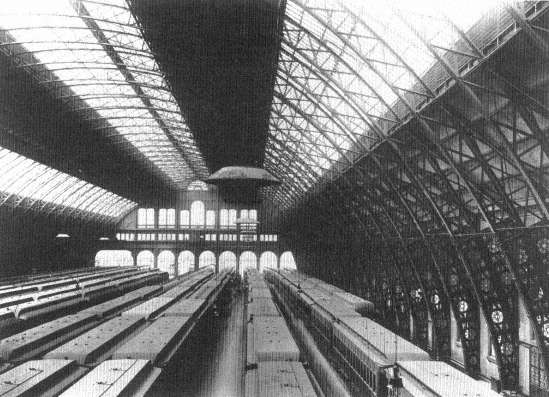
37.
Interior of Grand Central Station, New York, 1885
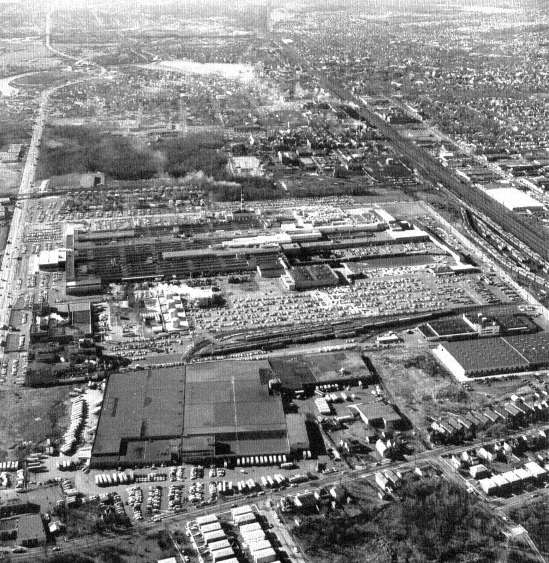
38.
General Motors Plant, Linden, New Jersey, 1967
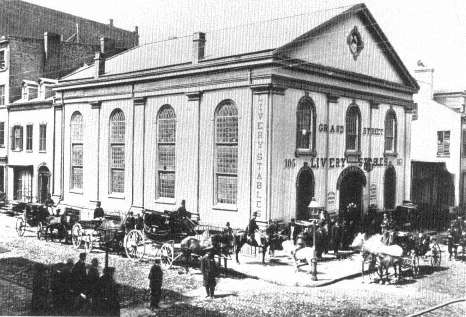
39.
Grand Street Livery Stables, New York. 1865
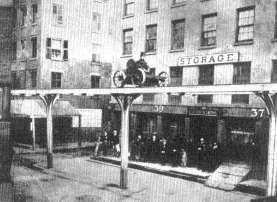
40.
Greenwich Street Elevated, New York, 1867
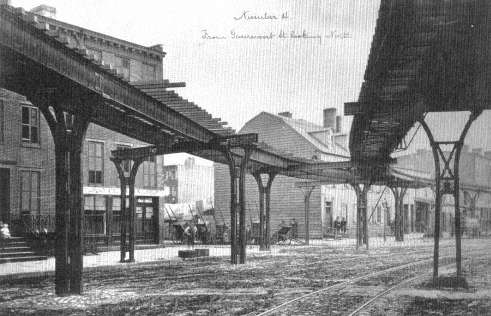
41.
Greenwich Street Elevated at Ninth Avenue, New York, 1876
none, he has friends in the village, and ere a year, Bill, Jo and Jim have been seduced off to New York.[21]
Unlike European countries of the time, the United States was an undeveloped land of bounteous resources which sustained a severe shortage of skilled labor. It offered high rewards to men who practiced a craft, and foreign-born artisans became leaders in many of the crafts in America. German immigrants predominated in New York in such diverse trades as sugar refining, the making of pianos and guns, and in lithography. Watchcase makers came from France and Switzerland, glass cutters from Ireland; ship riggers were Swedish, machinists British.
Urban production for a widening market also implied dependence upon a national and an international economy in a way that earlier artisans had never known. There were boom times, but there were also busts, panics, and depressions that caught all America and its London bankers short of orders, money, and credit. At such times wages might plummet 30 and 40 percent in a year's time. It has been estimated that a third of New York City's work force became unemployed in the panic of 1837. The depression in the winter of 1854-55 caused such widespread misery that a relief group claimed 195,000 men, women, and children were in want.[22] With every decade the cities burgeoned and intertwined more tightly with the rest of the United States and the world, so that each swing of depression meant longer breadlines, more evictions, more pervasive suffering.
The increase in the scale of production and the reach of markets started a long process of division into two classes within the urban labor force. The new discipline of urban work harassed and enticed Americans into a permanent acceptance of a social division between hand workers and pen wielders, operatives and clerks, the blue collar and the white. The pace of market growth was so fantastic that it impelled the enlargement of family shops and those with four or five employees to establishments with a dozen, fifty, even hundreds of workers. A number of results could be seen at once: the introduction of strict discipline and the systematic exploitation of women and children, the breakdown of
[21] . Walter Barrett (pseud. Joseph A. Scoville), The Old Merchants of New York City , New York, 1865, pp. 57-58. Note that this same spirit of youthful energy for moneymaking and success also characterizes the Lithuanian immigrant Jurgis Rudkus in Upton Sinclair's anticapitalist novel The Jungle (New York, 1906).
[22] . Ernst, Immigrant Life , pp. 73-83.
complex craft skills into simple repetitive tasks, the drive for quantity by cutting piecework rates and by the introduction of machinery. Simultaneously a whole new class appeared—the well-to-do class of owners and partners who always enjoyed prosperity far beyond their employees and sometimes attained the undreamed-of wealth of a John Jacob Astor, a Peter Cooper, or a Cornelius Vanderbilt.
The widening gulf between classes by no means went unnoticed by contemporaries. From the first, workingmen of the largest cities protested the loss of control over their working lives, and to combat it they formed unions. In the 1820s and 1830s, early in the process of differentiation between boss and worker, some unions included masters and shopowners who sympathized with the men or were themselves oppressed by wholesale competition. The great Ten-Hour movement of the thirties appeared as a wave of enthusiastic strikes and parades and swept the Eastern coast cities. It sought relief from the unbroken sun-rise-to-sunset hours that had once been only seasonal or rush practices and asked for reduction in hours without reduction in pay.
It was the depression of 1837-39 that broke the power of the workingman and his new organizations. Subsequent hard times and panics, as well as the counterorganization of employers, attacked later revivals of unionism. Only a few highly skilled unions seemed able to establish themselves permanently, groups like the printers, cigar makers, iron molders, and the members of some of the building trades. Though the union movement as a countervailing force to business reorganization remained endemic throughout the nineteenth century, everything worked against it: the steady erosion of craft skills and the consequent weakening of the bargaining power of the men, the growing influx of foreign labor and the ceaseless coming and going of all working groups in a restless search for decent wages and better conditions, the competitive and exploitative use of women and children and untrained immigrants, and the expansion of business that put more and more wealth and political influence into the hands of employers in labor disputes. The same factors worked against the men's attempts to set up producers' cooperatives and other social experiments, while the working-class political parties were destroyed by competition with another social outgrowth of this era, the urban political machine. The machine could successfully undercut the labor parties by delivering jobs and opportunities to its faithful party workers at the same time that it was giving
verbal support to workers' platforms.[23] Indeed, it has long been one of the major functions of American politics to blur class conflicts in order to appeal to the broadest possible coalition of voters.[24]
The very fact that the early nineteenth-century trend toward widening social distinctions between working class and middle class was a reversal of former preindustrial tendencies made the process all the more painful. During and after the Revolution, the urban artisan had gained a growing measure of political participation and power. Jacksonian democracy rose on the momentum of these years, only to collapse as social conditions in factories, cities, and farms undermined its dependence on a vanishing social reality of independent artisans, shopkeepers, and farmers.
In the period between 1776 and 1820, America seemed to be moving toward a growing egalitarianism. In the old commercial cities of the time, cities of small shopkeepers and merchants, the lines between worker and owner were blurred despite an obvious coexistence of rich and poor and the prominence of families of long-standing privilege and influence. Then beginning in the 1820s, as business quickened and harsh methods spread, the benign trends reversed themselves and the inexorable advance of blue-collar-white-collar distinctions commenced. Despite the unions, parades, strikes, and political parties that centered on the workingman, the hand worker lost ground. He lost status, he lost assurance of employment, and he lost personal control over his work. Ensuing waves of frustration and anger broke over the city. All the big cities suffered epidemics of violence; there were labor riots, race riots, native-foreign riots, Catholic-Protestant riots, rich-poor riots.[25] New York City alone underwent a succession of riots, eight major and at least ten minor, between 1834 and 1871. The climax came in 1863 as a mixed class and race riot, begun in protest against the draft, exploded among the city's workingmen and poor Irish.
[23] . Commons, History of Labour , I, pp. 169-84; Norman Ware, The Industrial Worker 1840-1860 , Boston, 1924, pp. 18-70.
[24] . For example, the industrialist Peter Cooper, like many Americans of his time, mixed Jacksonian antibanker, popular democratic ideas with strong anti-foreign, anti-Catholic and staunch probusiness politics. See Robert P. Sharkey, Money. Class and Power, An Economic Study of Civil War and Reconstruction , Baltimore, 1959, pp. 276-84; and Edward C. Mack, Peter Cooper , New York, 1949, pp. 357-72.
[25] . Hugh B. Graham and Ted R. Gurr, Violence in America: Historical and Comparative Perspectives , New York, 1969, pp. 53-55.
Early in the morning men began to assemble here [on the West Side] m separate groups, as if in accordance with a previous arrangement, and at last moved quietly north along the various avenues. Women, also, like camp followers, took the same direction in crowds. . . . The factories and workshops were visited, and the men compelled to knock off work and join them, while the proprietors were threatened with the destruction of their property, if they made any opposition.
A ragged, coatless, heterogeneously weaponed army, it heaved tumultuously along Third Avenue. Tearing down the telegraph poles as it crossed the Harlem & New Haven Railroad track, it surged angrily up around the building where the drafting was going on. The small squad of police stationed there to repress disorder looked on bewildered, feeling they were powerless in the presence of such a host. Soon a stone went crashing through the window, which was a signal for a general assault on the doors. These giving way before the immense pressure, the foremost rushed in, followed by shouts and yells from those behind, and began to break up the furniture. The drafting officers, in an adjoining room, alarmed, fled precipitously through the rear of the building. The mob seized the wheel in which were the names, and what books, papers, and lists were left, and tore them up, and scattered them in every direction. A safe stood on one side, which was supposed to contain important papers, and on this they fell with clubs and stones, but in vain. Enraged at being thwarted, they set fire to the building, and hurried out of it. As the smoke began to ascend, the onlooking multitude without sent up a loud cheer.
The scene in Third Avenue at this time was fearful and appalling. It was now noon, but the hot July sun was obscured by heavy clouds, that hung in ominous shadows over the city, while from near Cooper Institute to Forty-sixth Street, or about thirty blocks, the avenue was black with human beings,—sidewalks, house-tops, windows, and stoops all filled with rioters or spectators. Dividing it like a stream, horse-cars arrested in their course lay strung along as far as the eye could reach. As the glance ran along this mighty mass of men and women north, it rested at length on huge columns of smoke rolling heavenward from burning buildings, giving a still more fearful aspect to the scene. Many estimated the number at this time in the street at fifty thousand.[26]
For four days mobs of workingmen and lower-class citizens broke into the stores and homes of the rich, beat and killed policemen, and fought pitched battles against the companies of police and militia. They broke into the armories, felled telegraph poles, and closed off streets by means of cobblestone barricades. The city police and the troops who were rushed back from Gettysburg quelled the riot but only after the city
[26] . Joel T. Headley, The Great Riots of New York: 1712-1873 , New York, 1873, reprint, Indianapolis, 1970, pp. 160-61, 164.
had suffered casualties estimated as high as two thousand killed and eight thousand injured. If the estimates are accurate, they would make the casualties of the New York Draft Riots equivalent to the losses at Shiloh or Bull Run.[27]
Unquestionably these riots, likened by contemporaries to the uprising in Europe in 1848 and later to the Paris Commune of 1871, frightened generations of wealthy Americans. The idea of a class war between worker and capitalist, though never widely adopted despite energetic Marxist indoctrination, became an indelible part of the thinking of the wealthy at least until the Second World War. But there was a more immediate and progressive consequence of the riots: the undertaking of a systematic investigation into urban living conditions.
What were these early big cities of America like?
They were a crowded jumble of small buildings organized as yet by only the most primitive specialization of land use. Imagine a city of half a million or even a million inhabitants in which church steeples stood out on the skyline and the masts and spars of ships at the wharves could be seen above the roofs of warehouses and factories. As yet there were no giant manufacturing lofts or skyscrapers to house offices and stores, partly because the techniques for erecting such structures had not been perfected but also because there was as yet no pressing need for them. The downtown office of the mid-nineteenth century consisted of one to three partners and a few clerks. The unique downtown institutions of this era were not skyscraper banks or corporate office towers but the Merchants' Exchange and the Stock Exchange, the settings for periodic gatherings of businessmen who met each day to transact their business together. A big daily newspaper office and plant, like Horace Greeley's Tribune , fitted on a downtown street in a modest five-story building, one of several in a row that made up the block. The factories in which the new discipline and new machines were being introduced were for the most part small affairs. They might be housed in a floor or two of an ancient narrow building belonging to a merchant, in a basement, in a rear-yard structure of one or two stories that resembled a barn, or perhaps, in some trades like the making of cigars or clothing, in the tenement room of the worker himself.
Capacious factories and shipyards did stand at the edge of the city, but the modest spatial demand of most business enterprises meant that
[27] . Herbert Asbury, The Gangs of New York, An Informal History of the Underworld , London, 1928, pp. 169-70.
they could be served by one or a few building lots. Accordingly, every part of the city contained shops and small factories. Let us look at New York's fashionable Washington Square as examined in detail after the Draft Riots. Doctor F. A. Burrell of 22 West Eleventh Street, who conducted the inspection, reported a population of 27,587 in the area (the Fifteenth Ward), occupying almost three thousand buildings: "The style of living of the population presents every variety from luxury to poverty, and almost every branch of industry is represented." There were in fact forty-eight factories, which turned out such products as pianos, cabinet furniture, trunks, sewing machines, chocolate, carriages, photographic materials, and hoopskirts, and there was one slaughterhouse and one soap and candle factory. The survey also identified 542 "stores" of all kinds and 234 "dram shops" (which we would now call bars), 23 "lager bier saloons," 17 gambling saloons, 7 concert saloons, 76 brothels, and 22 policy shops.[28] Hardly the modern bourgeois residential style.
For all its conglomeration of little buildings, the early big city was not a disorganized hodgepodge. It had an internal structure that held within the limitations of its day the potential for future elaboration. Those businesses which handled a considerable volume of goods, whether of trade or manufacture, huddled together next to the wharves because intracity freight transport was so arduous and expensive. Once the railroads, lake and coastwise schooners, river steamers, or canalboats had been loaded, they could take their freight cheaply from one city to the next, but within the city their cargoes had to move from warehouse to warehouse by handcarts or horse-drawn wagons. A special flavor pervaded the mixed downtown areas of the period. They were districts densely settled by unprepossessing offices and stores and factories of all kinds, and even by sugar refineries and slaughterhouses, side by side with the more genteel firms that dealt in banking, law, insurance, or cloth. In St. Louis, Philadelphia, or New York, commerce encircled the port and stood on the banks of the Mississippi, the Delaware, or the East and Hudson rivers.[29]
Surrounding this characteristically mixed downtown section were two types of neighborhood, the slums and the streets of fashion. As
[28] . Citizens' Association of New York, Report of the Council of Hygiene and Public Health upon the Sanitary Condition of the City , New York, 1865, pp. 132-45.
[29] . Leon Moses and Harold F. Williamson, "The Location of Economic Activities in Cities," American Economic Review , 57 (May 1967), 211-22.
housing aged and commercial uses made living in old core sections unpleasant, landlords converted private homes into rookeries for the poor, who crowded into the tiny new rooms or into attics and cellars to be near downtown jobs. In some cases a local neighborhood served as an industrial quarter on its own, given over to shoemaking or the garment trade. These were not the huge slums of later times; they were accommodations of a lower sort than ever existed again, but they were limited in extent. Most of the poor mingled instead with middle-class families by renting rooms and apartments all over the city. Even by 1870 the characteristic residential form of the American city was not yet that of a core of poverty and an outer rim of affluence.[30]
Just beyond downtown, a street or two would be filled with the homes of the wealthy. These were the merchants, manufacturers, doctors, and lawyers who could afford valuable land and who wished to enjoy the prominence and convenience of a central address. Beacon Hill in Boston, Chestnut Street in Philadelphia, and Washington Square in New York remain as reminders of the housing habits of the rich. These early sections also marked the axes of fashion for their cities, so that when later growth and a movement to the suburbs drove the wealthy and their followers uptown and beyond the city, their new homes advanced in the same general direction that had been plotted by their inner-city streets.[31]
Outside the slum streets and fashionable blocks stretched acre upon acre sheltering mingled commercial, industrial, and residential neighborhoods that have no counterpart in our own day. Boardinghouses stood beside prosperous homes, mill workers crowded around a suburban establishment like Peter Cooper's glueworks, while the owner's home stood alone across a field from the group. Another row of houses for downtown workers might stand a block away, and back lots were universally crammed with stables and blacksmith shops and lumber yards.
[30] . The mixed character of the city in this era is confirmed by the journey-to-work estimates of Pred, Spatial Dynamics , pp. 197-213, and by comparison of activities in a slum like the Sixth Ward to an upper East Side new district like Sanitary District 22, in Citizens' Association, Report of the Council of Hygiene , pp. 77-80, 275-77.
[31] . For a systematic confirmation of earlier studies of the clustering and migration of upper-income city dwellers, see Peter G. Goheen, Victorian Toronto, 1850-1900: Pattern and Process of Growth , Chicago, 1970, pp. 123, 146-47; also Walter Firey, Land Use in Central Boston , Cambridge, 1947, pp. 74-86; and E. Digby Baltzell, Philadelphia Gentlemen, The Making of a National Upper Class , Glencoe, 1958, pp. 174-77.
Baldwin's locomotive works in Philadelphia, a leading enterprise of the city, was a definition point for a fine mixed white-collar and blue-collar residential section.
If the criterion of urbanity is the mixture of classes and ethnic groups, in some cases including a mixture of blacks and whites, along with dense living and crowded streets and the omnipresence of all manner of business near the homes in every quarter, then the cities of the United States in the years between 1820 and 1870 marked the zenith of our national urbanity.
4
The Segregated City
Chicago 1870-1920: factories, railroads, and skyscrapers
Motorists Speeding Along the New York Thruway, their glance drawn for a moment by a fragment of stonework from an old Erie Canal lock, may find it hard to see in such small constructions the fateful determination of their own lives, but the artifacts of the second period of industrialization present no such problems of self-recognition. We live among the objects of that age—its railroad stations and yards still stand near the center of town, its rows of warehouses and factories line many of the main streets of any city old enough to have grown up in those years. Its luxury apartments, when still maintained, are widely sought after for their old-fashioned charm and spaciousness, its houses of the well-to-do are the objects of neighborhood defense against destruction by urban renewal, while its parks, boulevards, office towers, and public buildings are often the only monuments to civic pride and luxury in our cities. These structures among which we live are but symbols of our more meaningful ties to this former time. Its manufacturing belts have coalesced into our megalopolises, and many of its business institutions are today's largest corporations. The archetypal city of this era was the industrial metropolis—the city of the mechanized factory, the business corporation, the downtown office, and the segregated neighborhood.
In technological terms the progression from the first era of industrialization (1820-70) to the second (1870-1920) can be characterized as a giant leap forward in power, speed, energy, and adaptability. The
complex machine ceased to be an innovation and became ubiquitous. The period actually opened in 1863 in France with the invention of the Siemens-Martin open-hearth method of high-quality steelmaking, and in 1865 with the introduction of cheap Bessemer steel production in Troy, New York. With the abundance of steels came all the elaboration of engineering that distinguished the times—high-speed rails, massive bridges and viaducts, skyscrapers, battleships, and finally automobiles. Mastery of the technology of electricity made possible the application of energy in measured quantities wherever it was needed, a boon denied to the operators of the cumbersome pulleys, shafts, and belts in the preceding days when power was generated by steam and waterwheels. Now electricity could run an individual streetcar or light a lamp in one room as easily as it could illuminate a skyscraper; it could pull a mammoth assembly line or drive a single sewing machine. Moreover, electric power could be transmitted hundreds of miles from its source, thereby allowing manufacturing plants to seek their best transportation, labor, service, and sales locations rather than clinging to waterpower sites. Explorations taking place in the field of chemistry made possible the refining of petroleum, the manufacture of dyes and high explosives, and the compounding of new alloys. The repeated economic successes of technological innovations led to the institutionalization of invention itself, so that firms regularly set aside money for the specific task of discovering new tools, products, processes, and modes of transmitting energy.[1]
The ubiquity of power and machines in the late nineteenth and early twentieth centuries had profound effects on the American urban system. First the new technics encouraged urbanization in general by drawing more and more Americans into those economic roles which peculiarly favored the growth of cities. Mechanization of agriculture, mining, and lumbering freed a multitude of workers for alternative tasks in manufacturing, transport, finance, and the servicing of business. So successful were the new modes of factory production in saving manpower that in the fifty years after 1870 the ratio of Americans employed in marketing, transportation, and services, the very specialties of cities, grew more rapidly than the ratio of those in manufacturing itself.[2]
[1] . Jacob Schmookler, Invention and Economic Growth , Cambridge, 1966, pp. 199-209; Melvin Kranzberg and Carroll W. Pursell, Jr., Technology in Western Civilization , I, New York, 1967, pp. 357, 563-692.
[2] . Harvey S. Perloff et al., Regions, Resources, and Economic Growth , Baltimore, 1960, pp. 131, 151-61, 168.
Second, the functions of cities within the national urban network shifted. The largest cities diversified, becoming great manufacturing centers as well as places of commerce and finance. At the same time, small cities which specialized either in manufacturing a narrow line of goods or in processing regional products for the national market multiplied and prospered. These growing small cities were not, however, evenly distributed across the nation but were concentrated in the Northeast and Midwest. Because the new electrical and automobile technology built upon the skills and tools of the old iron and steam technology, the cities of these two industrialized regions stood in a favored position for making the components of the new age.[3]
Even the crudest classification of the nation's cities by size of population reveals the new trends (Table 1, page 70). Industrial diversification spurred the growth of metropolises. The 1920 national network of cities was composed of twenty-five metropolises ranging in size from New York (5,620,000) to Denver (256,000).[4] Moreover, the sizes of the cities reflected their economic diversification. The giants, New York, Chicago, and Philadelphia, were the largest manufacturing clusters in the nation in which every kind of product came forth, from the earliest mechanized goods like textiles, clothing, flour, and meat to the most modern like structural steels, petroleum, electrical machinery, and automobile parts. So powerful had been metropolitan growth that two of the twenty-five metropolises, Newark and Jersey City, were themselves adjuncts to the metropolitan district of New York. The smallest metropolises, on the other hand, added a few manufacturing specialties to the traditional regional commercial activities. Rochester concentrated on men's clothing, boots and shoes, foundries and machine shops, furniture, and optical instruments; Portland (Oregon) on lumber, foundries and machine shops, and wooden shipbuilding; Denver on railroad-car building and repair, foundries and machine shops, and slaughtering and meat packing.[5]
[3] . Beverly Duncan and Stanley Lieberson, Metropolis and Region in Transition , Beverly Hills, 1970, pp. 119-34.
[4] . The twenty-five metropolises of 1920 were: New York, Chicago, Philadelphia, Detroit, Cleveland, St. Louis, Boston, Baltimore, Pittsburgh, Los Angeles, Buffalo, San Francisco, Milwaukee, Washington, Newark, Cincinnati, New Orleans, Minneapolis, Kansas City (Missouri), Seattle, Indianapolis, Jersey City, Rochester, Portland (Oregon), and Denver. Fourteenth Census of the U.S.: 1920 , I, Population , Washington, 1921, p. 80.
[5] . Fourteenth Census of the U.S.: 1920 , IX, Manufactures, 1919 , Washington, 1923, pp. 163-64, 1089-90, 1256.
Below the largest cities came an efflorescence of smaller ones, 263 in all. Of these, 69 were classified by the statisticians of the Fourteenth Census as sections enveloped within metropolitan districts.[6] However one divides them, into 25 metropolises and 263 cities or into 23 metropolitan districts and 194 independent cities, the difference between the two groups was a matter of the degree of specialization of economic function in the urban system.
The smaller cities were all specialists, but of two distinct kinds. One variety, processing and commercial cities, fulfilled the classic urban role of rendering financial and commercial services to its rural hinterland, bringing the goods of the nation to the farms and towns of its surrounding area. In return these cities processed and shipped the local specialties into the stream of the national and international market. Memphis handled Southern lumber and made oil from cottonseed, Tampa manufactured cigars from Cuban tobacco, Richmond made cigarettes, Sacramento canned fruits and vegetables, Tulsa refined petroleum, and E1 Paso, Houston, and Fort Worth built and maintained railroad cars and equipment which carried the Texas farmers' crops and livestock. In the Midwest and Northeast a second variety of small city flourished—the mill town. Here specialties were not based directly on local farms or natural resources but rather capitalized on local skills and the regional and national markets for producers and consumers goods. Albany concentrated on shirts, nearby Troy on collars; Bridgeport on corsets, brass, and machine tools; New Bedford and Fall River on cotton textiles; Elizabeth, New Jersey, on electrical machinery; Chester, Pennsylvania, on iron and steel; Allentown, Pennsylvania, on silk goods; Erie, Pennsylvania, on foundries; Columbus, Ohio, on railroad cars; Dayton on machine tools and cash registers; Toledo on glass, foundries, and auto parts; and Youngstown on steel.[7] The clustering of these specialized cities created the two manufacturing belts of the nation. One belt stretched along the Atlantic coast all the way from Maine to Virginia; the other lay west of the Alleghenies and north of the Ohio, stretching from Pittsburgh and Buffalo on the east to St. Louis and Milwaukee to the west.
It was the railroad that allowed the metropolises to diversify and the
[6] . Fourteenth Census , I, Population , pp. 62-75.
[7] . City specializations taken from listing by city in the Fourteenth Census , IX, Manufactures .
small cities to specialize, because it created the national and large regional markets for both groups of cities. These were the years when almost all of the nation's internal traffic moved by rail. In 1916 (ironically the year in which federal aid was first granted to highways) the nation's rail network reached its apogee: 254,000 miles of tracks, 77 percent of the intercity freight tonnage, 98 percent of the intercity passengers.[8]
Urban economic diversification and specialization both stemmed from the way the railroad customarily handled its freight. Freight cars were made into long trains at the terminals in the largest cities and were then dispatched to another metropolitan center at a distance, with only limited stops for the purpose of adding or dropping cars or taking on more locomotives to climb the Appalachian range, which separated the two manufacturing belts. In these long hauls the railroad reached its maximum efficiency, its lowest costs per mile. A skeleton crew could handle the moving train, whereas the terminal yards required many more men to assemble and reassemble freight cars. Thus starting and stopping were very costly, but the extended hauls saved on fuel. Influenced by these factors as well as by a desire to increase the volume of traffic on long lines through the lightly settled South and West, the railroads offered low rates for those long-haul commodities which were specialties of any given region in the United States—oranges from Florida, lettuce from California, strawberries from Louisiana, copper from Montana, lumber from Idaho.[9]
Furthermore, as the railroads delivered farm products and national resources to the freight-yard and terminal cities, they conferred upon the metropolises choice locations for expansion in wholesale and retail manufacturing. Accordingly, next to the urban terminals sprang up enormous breweries, refineries, steel mills, or meat-packing concerns. Brewing and meat packing, as well as milling, had formerly been among the dispersed processing activities, yet now they clustered together at the terminals in Minneapolis and St. Paul, Kansas City and St. Louis, Chicago, Toledo, and Buffalo. The shipping advantages enjoyed by the
[8] . John F. Stover, American Railroads , Chicago, 1961, p. 269.
[9] . Benjamin Chinitz, Freight and the Metropolis , Cambridge, 1960, pp. 110-28; David M. Potter, "The Historical Development of Eastern-Southern Freight Rate Relationships," and Stuart Daggett, "Interregional Freight Rates and the Pacific Coast," Law and Contemporary Problems , 12 (Summer 1947), 416-48, 600-620.
important terminal points likewise aided existing city industries like printing and clothing manufacture.[10]
The rail-terminal metropolises did not monopolize all the urban growth of the era; rather they formed symbiotic relationships with networks of specialized small cities, thereby allowing these cities to expand on the basis of their particular advantages. The specialized cities were in part the outgrowth of industries based on cheap resources: Manchester, New Hampshire, had long since grown up around waterpower, as had Trenton, though Trenton had access to coal and iron as well. Peoria was a new city that lived by distilling the nearby corn. Some carried old skills into the new electrical and auto age, as was the case in Providence with its machine tools or Waterbury with its brass. But these settlements, whether oriented toward natural resources or toward skills from their pasts, were all sustained and nourished by the interlacing rails that ran through the Northeast and Midwest.
The nation's coal trade also favored the Northeastern and Midwestern manufacturing belts. Coal far outweighed any other freight movement along the railroads. In the nineteenth and early twentieth centuries, coal had to be shipped from the mines of Appalachia, southern Illinois, and Missouri to the cities of the East and Midwest: huge tonnages to heat and light the cities, to make gas for cooking and lighting, to power the factories, to melt the iron, and to serve as the base for chemicals. To keep the fuel moving smoothly, the railroads had to build city terminals and extra trackage along the coal routes. This heavy investment in transportation capacity for coal set in motion a positive cycle of railroad investment, low freight rates, and high industrial investment; since the rail capacity had been justified by coal, it could be used as well for other freight. Thus, low rates and good terminal service could be offered by the railroads in these two regions which the South, Mountain, and Pacific regions could not hope to duplicate.[11]
Finally, competition policed the rate structure of the railroads of the East and Midwest. City rivalries during the years 1840 to 1860 had led Boston, New York, Philadelphia, Baltimore, and others to build rail systems. When completed and interconnected after the Civil War, they offered more than one path to many destinations; the shipper could
[10] . There was much contemporary objection to the rate-making advantages of the rail-terminal cities and already industrialized regions. See, for example, Charles Horton Cooley, "The Theory of Transportation," Publications of the American Economic Association , 9 (May 1894), 113-23.
[11] . Edward L. Ullman, American Commodity Flow , Seattle, 1957, pp. 1-19.
often choose his railroad. Cutthroat competition ensued, only to be halted by agreements among the railroad corporations themselves during the 1870s and 1880s. The corporations set standardized fares within the Northeast and Midwest that ignored precise distances and thereby eliminated slight mileage advantages of one city over another. Federal regulations confirmed these agreements until truck competition made them impossible to maintain in the 1930s.[12] For the half century of its duration this standardized rate structure of the railroads was a stimulus to intra-area traffic. So too was the fact that the volume of freight was so immense in the two lanes of greatest traffic—the Atlantic coast and the land west of the Alleghenies—that lines within these regions could add a certain amount of business without incurring the expense of additional facilities.
Thus the transportation lines and the economy grew together, the easy intercommunication among the industrial metropolises and the specialized small cities fostering the manufacture and marketing of ever more complex products. With good rail service, the lines of complementarities among firms that used to prevail only in the neighborhoods of the old big city now could be enjoyed throughout the manufacturing belts of the Northeast and Midwest. Steel could be ordered from Pittsburgh, Buffalo, Detroit, or Chicago for subway cars being built in New Hampshire, ships being built in Wilmington, generators being built in Schenectady, or harvesters being built in Milwaukee. Likewise the many parts and subassemblies for all these products could be gathered from the crisscross traffic of the regions. Though the long hauls were always the cheapest per mile, the sheer volume and frequency of such traffic, as well as the competition among the lines, kept rates down and service up, and fostered the growth of the two sprawling manufacturing belts, made up of many small cities and linked together by giant industrial metropolises. Half a century ago the railroads were laying the foundation for two of the megalopolises of our own time.
As the completed rail system extended the scope of urban markets so that all manner of products from precut beef to stone crushers could be sold nationally, the mechanized method of production came forward to take advantage of the profits to be reaped by large-scale endeavor. Thus the increase in the size of business enterprises so painfully begun
[12] . Pittsburgh Regional Planning Association, Economic Study of the Pittsburgh Region , I, Region in Transition , Pittsburgh, 1963, pp. 188-202.
in the earlier period continued unabated. The trend toward bigness was most dramatic among the specialized cities where giant mills concentrated on a narrow range of products. The average number of employees per manufacturing establishment exceeded a thousand in such places as Lawrence's worsted mills, New Bedford's cotton mills, Omaha's slaughterhouses, Providence's machine-tool factories, Oakland's shipyards, Milwaukee's engine plants, and Racine's farm-machinery works.
In the industrial metropolis trends were more selective, with considerable variation among cities and industries. New York and Chicago differed in scale of enterprise (Table 2) partly because New York's industrial structure had taken shape in the earlier era of small shops. Here the presence of subcontractors and small specialists discouraged the concentration of every aspect of the manufacture of a product under one roof; firms could achieve large-scale production by taking advantage of the complementary suppliers in the city. On the other hand Chicago—the new industrial metropolis, the rail center of the Midwest, and the center of a vast wholesale trade—organized around large firms and long production runs. Thus its firms, even in old industries like boots and shoes, clothing, furniture, and hardware and hand tools, were larger than New York's. In both cities, however, new industries like electrical machinery, refrigerated dressed meat, rubber products, paper and wooden boxes, steel ships, railroad cars, and steel mills showed the effects of large markets, heavy capitalization, and expensive machinery (Table 2). For such enterprises, firms of hundreds and even thousands of employees became commonplace.
The new scale of business forced a reorganization of urban business institutions. The private corporation replaced the gathering of hundreds of proprietors and partners that had characterized the former big city. As this transformation proceeded, the power of deciding what urban working conditions would be like and where urban jobs would be placed shifted from an unmanageable army of small entrepreneurs to a clearly identifiable group of corporate managers. By 1920 a planned national economy and a nation of planned cities became a possibility open to Americans.
The private corporation in the United States had its roots in the necessity for amassing capital for large undertakings. In the years from 1820 to 1870, when corporations were still a novelty, private groups had sought charters for such institutions in order to construct bridges,
TABLE 2 . |
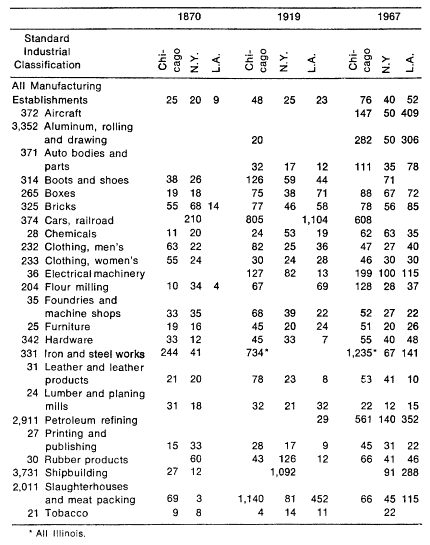 |
[13] . The purpose of Table 2 is to give illustrations of changes in manufacturing establishment size in a number of representative industries. The industries listed stand for varying degrees of removal from primary processing of resources to complex multistage products which are manufactured either for consumers or for other producers. Some industries were selected because they have a long continuous history, like clothing, flour milling, hardware, and tobacco, and others were selected because they were peculiar to an era, like railroad cars or aircraft.
The verbal descriptions of each industrial group in the table were taken from the 1919 Census of Manufactures, and an analogous 1967 Standard Industrial Classification group was sought to match. For 1870, vaguer approximations had to be tolerated. The 1870 equivalents for the 1920 descriptions were: boxes, cigar, paper, wooden and fancy (1870) for boxes, paper (1920); drugs and chemicals for chemicals; machinery not specified, engines and boilers for foundries and machine shops; iron forged and rolled for iron and steel works; lumber planed and sawed and sashes, doors, and blinds for lumber and planing mills; shipbuilding and repairing for shipbuilding, steel. The killing of animals for shipment as dressed fresh meat was not an industry in 1870, so the packing of salt pork and beef had to be taken as the equivalent of the entire meat-packing industry of 1919.
The city boundaries are in 1870 Cook County, Kings and New York County, Los Angeles County; in 1920 the cities themselves; in 1967 the Chicago Consolidated Statistical Area, the New York Consolidated Statistical Area, and the Los Angeles-Long Beach Standard Metropolitan Statistical Area and the Anaheim-Santa Ana-Garden Grove Standard Metropolitan Statistical Area.
Ninth Census: 1870 , III, Statistics of Wealth and Industry in the United States , Washington, 1872, pp. 639, 649, 701-704; Fourteenth Census , IX, Manufactures , pp. 122-26, 358-64, 1058-66; Census of Manufactures, 1967 , III, Area Statistics, Parts I & II , Table 6.
canals, turnpikes, and railroads, to establish banks, and to engage in some manufacturing.[14] These firms had a common need to raise large amounts of capital. The corporate form, with its legal devices of stock and bonds and limited liability of stockholders for the debts of the business, facilitated a wide canvass for capital. Under the contemporary partnership form of business, every partner was personally liable for the debts of the entire firm, and many a nineteenth-century businessman lost his savings and his home upon failure or from a partner's incompetence or fraud. Under the corporate form, large merchants and small investors, total strangers to each other, could club together in the confidence that each risked only his investment, not his fortune, his home, or his farm.
Although the corporate charters required a governing board elected by the stockholders, the early corporations were so small that they were not in fact managed by committees but by one or two men. The success of these firms depended on the ability of the managers to stay in contact with all aspects of the business in order to coordinate diverse activities and to direct the firm into new undertakings. As the size and complexity of American enterprises increased, however, business management passed beyond the reach of any one man's personal supervision. First with the trunk-line railroads of the 1850s, and then increasingly in production of food products, sewing machines, and farm machinery in the
[14] . George H. Evans, Jr., Business Incorporations in the U.S. 1800-1943 , New York, 1948, pp. 10-30.
1880s, American corporations experimented with new forms of management. By the first decades of the twentieth century a centralized, departmentalized, bureaucratic form of corporate management had been established as the norm for big companies.
No sinister force withered the strength of the personal-style managers, but the increase in the size and complexity of their responsibilities overwhelmed them. In the 1850s a textile company might employ some eight hundred men, a locomotive works six hundred, but the Erie Railroad had four thousand employees, men not confined to one yard but scattered over five hundred miles of track. No one office handled the cash; hundreds of station agents and conductors took in the company's money. By the 1880s the major trunk-line railroads like the Pennsylvania had several thousand miles of track and upwards of fifty thousand employees. Nor was mere size the extent of the manager's problems. These were times of rapid technological change in railroad construction and locomotive and car design, and times of fierce competition. The manager could not hide his head in routine but had to make quick competitive decisions, perhaps whether to merge with minor roads or to cut rates in order to capture more traffic. It was a time too when unscrupulous financiers maneuvered the stocks and bonds of the railroads to found individual empires, so that many a firm was harassed to the point of destruction by external and internal security manipulation.[15]
The absolute necessity for dependable coordination of the management of daily business and the simultaneous need to meet the competition transformed the early trunk-line railroad into a modern centralized corporation. The Erie, the Baltimore and Ohio, and the Pennsylvania were all pioneers in bureaucratic innovation; between 1850 and 1880 they established the fundamental structure of the American corporation. Railroad management divided naturally into three departments—finance, operations, and traffic—each with distinct responsibilities and chains of command. Finance concerned itself with the collection and dispersal of revenues as well as with the issuance of stocks and bonds; operations controlled the movement of trains and their maintenance; while traffic was essentially a sales department, finding customers and following the course of their goods and freight
[15] . Alfred D. Chandler, Jr., Railroads, the Nation's First Big Business , New York, 1965, pp. 97-100; and Chandler, Strategy and Structure, Chapters in the History of the Industrial Enterprise , Cambridge, 1962, p. 38.
cars, as well as watching the costs of passenger and freight movement. Throughout this first stage of corporate development the emphasis was on centralized control, because the highest profits were found to accrue through consolidating unrelated commitments into one comprehensive undertaking.
Therefore each department and each section within it had both line and staff officers. The line officer managed day-to-day operations within his section and might deal with the movement of cars, the routine repair of a segment of a trunk line, or the disbursement and collection of funds in a given geographical area. The staff officers reported directly to the central office. They were charged with the responsibility for long-range decisions, such as whether or not to purchase new rolling stock or to establish new traffic patterns. This departmental management of a centralized bureaucracy made possible the successful operation of the great railroad complexes of the period. It also made possible the coordination of hundreds of small lines, originally built by the cities and towns, into far-flung, high-speed routes traveled by thousands of cars, which were unscrambled and rerouted in a thousand different ways on their trips into the city terminals.
The same opportunities and challenges that had organized the railroads manifested themselves a few years later in industries attempting to reach and hold a national market for their products: meat, cigarettes, flour, bananas, harvesters, sewing machines, and typewriters.[16] Problems might arise in sales, production, or supply, but since they had their origin in the grandiose scale of the enterprise, the solution was everywhere the same—toward rationalized departments in management, toward centralization of control. Gustavus Swift (1839-1903), a cattle buyer and shipper, who financed the development of the railroad refrigerator in order to sell meat butchered in Chicago in Eastern cities, found his business requirements driving him from a partnership to a modern corporation. Once he had perfected his car, he needed sales offices and refrigerated warehouses at his major-destinations; he had to finance his fleet of refrigerator cars and struggle with the railroads to obtain fast service for them; and finally he had somehow to connect the purchasing and slaughtering of animals in Chicago to his sales in the East. Aided by a centralized departmental structure and by staff and line control over his operations, Swift was able to build a national business.
[16] . Alfred D. Chandler, Jr., "The Beginnings of 'Big Business' in American Industry," Business History Review , 33 (Spring 1959), 6.
He overcame consumer reluctance by national advertising and expanded into related lines of pork, veal, lamb, butter, oleomargarine, soap, glue, and fertilizer. He was eventually able even to shift to multiple plant locations (Fort Worth, Omaha, St. Joseph, St. Louis) that brought processing closer to the sources of his supplies.[17]
The necessity for management to control sales throughout many cities and possibly also throughout a number of supply locations spread the new bureaucratic corporate structure to cigarettes, flour, bananas, sewing machines, harvesters, and lighting and power utilities.
Corporate centralization also appeared in the rubber companies and in many metalworking industries during the late nineteenth century. To take full advantage of the new technology required heavy investments in machinery housed in factories capable of a tremendous volume of steady production. The consolidated plants were of course immensely more efficient than the previous small factories, but they did require a new approach to sales; the sales force had henceforth to be under the control of management as well as subservient to production. The independent salesman who worked on a commission had dominated American marketing during the nineteenth century, and his success depended on selling a few products at a high commission rather than on selling a great many at a low commission. The route to harnessing the market to the output of the giant factory henceforth lay in the adoption of national advertising to arouse consumer demand and of salaried salesmen and sales managers to close the deals, and this route proved to be the way around the old independent salesman.
Still other industries, like steel and oil, expanded in the direction of controlling their sources of supply so that production would not be at the mercy of outside forces. In almost every industry the forces for centralization, for the integration of sales, supply, and production, pressed upon owners and managers of American business, and everywhere the response took the same general direction toward vertical integration, departmental structure, staff and line responsibilities, and centralized control. The progression was always an uneven one, and some giants like U.S. Steel remained a muddle of centralized operations and semiautonomous subsidiary corporations until the 1930s. The notorious Standard Oil Corporation never attained in these years the rationalization achieved by American Tobacco or General Electric.
[17] . Oscar E. Anderson, Jr., Refrigeration in America , Princeton, 1953, pp. 50-52, 142-50; Chandler, "Beginnings of 'Big Business,'" 6-8.
Whatever the degree of formal rationalization, however, the impersonal centralized private corporation was an outstanding social fact of the era, and from it spread the ever-widening bureaucratization of American work and society.[18]
The reorganization of business institutions to suit the demands and possibilities of large-scale enterprise brought about a chain of adaptations within the cities themselves. Immense factories became normal manufacturing elements. There arose the rubber plants of Akron, the glassworks of Toledo, the cotton mills of Manchester in New Hampshire, the cash-register factory at Dayton, and together they overwhelmed the specialized minor cities of the manufacturing belts. Such factories with their ferocious rationalization were apt metaphors for the new metropolis itself, which experienced a similar heartless rationalization of its jobs and its land use. Exploitation and segregation were the dominant trends within the cities of this era. The similarities between the mechanized centralized enterprise and the industrial metropolis of the half century after 1870 were entirely apparent to their contemporaries. As the science and engineering of the time had supplied the expertise for developing products and processes, so the emerging social science uncovered the framework of the economy and the city and suggested sensible guidelines for their humanization. Indeed, the two most typical cities of the period, Pittsburgh and Chicago, were the ones in which investigators carried on the most advanced research and reached the most perceptive conclusions concerning the interconnections of the national economy, corporate enterprise, urban jobs, and urban land-use structure.
The Industrial Metropolis: 1870-1920
In Pittsburgh a team of investigators spent most of a year in 1907-1908 probing into every aspect of the city. Their goal was to relate the systematic knowledge of census and survey to the reportage of individual lives and experiences. Their hope was to arouse local action directed toward the improvement of living conditions. The reports were masterpieces in social science and journalism. The six volumes ultimately published served as the foundation for urban social science during the next twenty or thirty years, and they are still the richest
[18] . Chandler, Strategy and Structure , pp. 24-41.
available source of concrete information on the urban life of these times.[19]
The repetitive theme of the Pittsburgh Survey emphasizes the driving force of the age. It explored the centralized, rationalized, carefully planned engineering controlled by vast enterprises; the furnaces and rolling mills, railroads, mines, and ovens all interlocked in a wonderfully productive unity supported by armies of men and thousands of machines and fully able to move mountains of material over half a continent. From 1880 to 1910 an industrial metropolis based on steel, glass, and electrical machinery had sprung up from the conjunction of almost unlimited high-grade coking coal, natural gas, and the talent of a fine inventor-industrialist, George Westinghouse (1846-1914). Yet over this triumph of human energy hung a dark pall—a literal blanket of smoke that shut out the sun and seared the soil, as well as a metaphorical pall of exploitation, neglect, disorganization, and helplessness. The personnel of the giant mills was rigidly divided into classes, with college graduates at the top of the pyramid, followed by the skilled workers and finally by the mass of unskilled laborers. Corporations rewarded each class appropriately in their own view, with steady salaries and hierarchical promotions for the educated elite, high wages and fringe benefits in housing for the skilled, bitter poverty and unremitting toil for the unskilled.[20] The gulf between respectability and poverty in the corporations established the major segregation of the city, but this class separation was subdivided by further segregation within the neighborhoods of the city by race, national origin, and church affiliation.
Everywhere in the city, production was the focus of attention. Every day, men were killed and maimed by machinery; every trade injured its help without compunction. The pace was too fast, the hours were too long, and in this era it was not the cellar sweatshops or upstairs factory but the mighty enterprise that stood in the front ranks of the callous. The steel mills and railroad yards ran on a twelve-hour day, seven days a week. Yet managers ruthlessly and systematically used their power to block any counterorganization of the men. The Homestead strike of 1892 and the steel strike of 1919 were both crushed by troops and by
[19] . The survey first appeared in summary form in one volume, "The Pittsburgh Survey," Charities and the Commons , 21 (January 1909), 515-1194; the complete edition, Paul U. Kellogg, ed., The Pittsburgh Survey , New York, 1909-1914, 6 volumes.
[20] . David Brody, Steelworkers in America: The Nonunion Era , Cambridge, 1960, pp. 80-95, 112-24.
the illegal use of police and criminal charges, as well as by spies and scabs and the whole military, economic, and civic machinery of repression.
As the corporations sowed, so the city reaped. Old forms of poverty, fostered by neglect, persisted on and on. One of the worst of the U.S. Steel slums was Painter's Row, a district inherited from a small mill-owner forty years before and never either abandoned or repaired. Self-help was not unknown, but it frequently failed; homeowners dug wells to escape dependence on polluted water only to have their wells polluted in turn by runoff from nearby privies. Ignorant and corrupt public officials in a civic government under the thumb of political bosses and business executives fragmented political boundaries so that big companies escaped taxes, and the workman was left without community resources with which to protect his family or educate his children.[21] Pittsburgh was the perfect prototype of centralized private economic power. Its enormous productivity was based on an insane rationality that consumed men, women, and children in order to create personal ascendancy and a multiplicity of mere things.
Pittsburgh, the heavy-industry metropolis, was the cartoon for Chicago, the total urban industrial landscape. This giant new metropolis (299,000 inhabitants in 1870; 2,702,000 in 1920) was subjected to piecemeal investigation by a generation of social workers and university investigators, with the result that in time a Chicago school of social science could present a reasonably complete analysis of the workings of the economy from 1870 to 1920 and trace its effects upon the city. Whereas the Pittsburgh group had confined themselves to accurate reporting of the existing situation, the Chicago team was able to relate the growth of business in Chicago to national growth factors. They could therefore indicate how the patterns of job location and the wages of workers and office employees determined the location of housing. Finally they discovered that this placement defined much of the social and political structure of the city.
Like all the major cities of the world, Chicago owed its importance to its situation at a point where cheap long-distance water transportation met the more expensive land transport. Even more significant was the fact that at the very moment the inventions in farm machinery, the
[21] . F. Elisabeth Crowell, "Painter's Row," Charities and the Commons , 21 (January 1909), 899-910; Roy Lubove, Twentieth Century Pittsburgh: Government, Business, and Environmental Change , New York, 1969, pp. 1-19.
Illustrations
Industrial Metropolis
42. Pittsburgh Mill District, 1940. Timeless report from the industrial metropolis: highly articulated science and technology in the mills, leftover spaces, shoddy housing, inconvenience, hazard, and neglect for the people. Library of Congress
43. New Downtown Office Street, Michigan Avenue, Chicago, 1933. Five times as large as Pittsburgh, Chicago reflected the same economic organization and social priorities. Extreme rationalization and concentration of metropolitan commerce, a row of skyscraper office buildings, erected during the twenties, lines new double-decked street with freight deliveries separated from pedestrian and automobile access. Chicago Historical Society
44. Near 12th and Jefferson Streets, Chicago, 1906. Slum use of typical working-class wooden housing in industrial sector along south branch of Chicago River. Overcrowding of structures by poor immigrants, with one and two additional houses in rear yards, nullified any margin of health and safety inherent to a free-standing home. Chicago Historical Society
45. Working-Class Chicago, from Damen Avenue and 18th Street, 1934. "Chicago's great southwest side has views as beautiful as any in the world." Daily News, June 30, 1934. Chicago Historical Society
The Downtown
46. South Water Street and the Chicago River, ca. 1920. Downtown from rear, with ring of food dealers, loft manufacturers, wholesale houses next to office towers and public buildings of the commercial core. A City Beautiful project soon replaced these old buildings with the two-level Wacker Drive, Merchandise Mart, and other skyscrapers. Chicago Historical Society
47. Michigan Avenue and Grant Park, Looking North from the Blackstone Hotel, Chicago, ca. 1910. With landscaped park and boulevards between the lake and downtown, the wall of new commercial towers emerged as the visual symbol of Chicago. Old (ca. 1860-80) houses (left) measure the break from the past. Library of Congress
48. Wabash Avenue, Chicago, 1907. New masonry and steel canyons of shopping crowds, white-collar work, novelists' wonder, and sociologists' atomization and alienation. Library of Congress
River Industrial Sectors
49. Chicago River, Looking East Toward Lake Michigan, 1875. Where lake schooners and canal boats (lower right) met, the city's earliest manufacturing districts began. Air-Line Elevator (left) was on the site of present Merchandise Mart. Chicago Historical Society
50. South Branch of the Chicago River, 1883. Chicago perfected mass processing of raw materials, animals, grain, and lumber as no city had before. Here, a two-mile wholesale lumber district. Library of Congress
Rail Industrial Sectors
51. Track Elevation at 23rd Street, Chicago, ca. 1907. View of work on Chicago, Burlington and Quincy Railroad shows that the railroad and industrial neighbors often formed a continuous lineal city within the metropolis. Library of Congress
52. Calumet Harbor-Gary Industrial Strip, 1908. Six railroads and artificial harbors for ore boats nourished a sixteen-mile strip of heavy industry, since the late nineteenth century a basic element in Chicago's economy. Here, the new Universal Portland Cement Company plant, next to the Gary steel mills (out of picture, at right), with Calumet Harbor plants of South Chicago down the tracks (upper left). Library of Congress
53. Western Electric, Hawthorne Works, Cicero, ca. 1910. In 1903 this manufacturing subsidiary of American Telephone and Telegraph moved its giant plant out to the fringe of the city, where land was plentiful and its operations could be served by the circumferential belt railroads that tied together all the lines of the metropolis. Chicago Historical Society
54. Casting Pig Iron, Iroquois Smelter, Calumet Harbor, South Chicago, 1906. A few workers in the army of hand laborers required by large-scale industry during the early and middle stages of its mechanization. Library of Congress
Residential Infill
55. Standard Housing, State Street near 15th, Chicago, 1868-69 (above, left). Narrow wooden buildings were one-to-a-lot in good neighborhoods, crammed one behind the other in poor sections; the unpaved street and wooden sidewalk were typical. Chicago Historical Society
56. Standard Housing in Brick, 1848 Bloomingdale Avenue, Chicago, ca. 1912 (center, left). After the 1871 fire, a city ordinance, only laxly enforced, required that the core city be rebuilt in brick. Half-cellar rental units ("up and down" housing) were created out of a single-family house design. Chicago Historical Society
57. The New Environment, 1749-59 North Whipple Street, Chicago, ca. 1912 (below, left). About five miles west of downtown, streetcars and elevated railroads opened up Humboldt Park section to the middle class and upper working class. It provided running water, public sewers, electricity, gas, paved streets and sidewalks, lawn strips and street trees, and closely set single- and two-family wooden houses. Chicago Historical Society
58. Rear Yards, 1754-58 North Whipple Street, Chicago, ca. 1912 (above). Urban houses are intended to make their best impression on the front street, and this plan was carried to the suburbs until the ranch house and attached garage of our time brought cars, children's bicycles, trash barrels, and impressive front entrances all to face the street. Here, an alley carries electricity, gives access for trash and service, with small businesses occupying sheds in rear yards before zoning prevented such mixed land uses. Chicago Historical Society
59. Nineteenth-Century Housing, 44th and Wood Streets, Chicago, 1959 (below). Industrial metropolis housing survives in working-class sections of all American cities. Here, with asphalt siding, encroached upon by cars, a "Back of the Yards" neighborhood of the 1880 standard land and housing plan. Chicago Historical Society, Clarence W. Hines
60. Lake Shore Drive, Chicago, 1905. The absence of railroad tracks and easy commuting to downtown shifted the focus of fashion from South Side to the Near North Side Lake Shore. The public parkway system enhanced the private amenities of the rich. Library of Congress
61. Going to a Band Concert, Lincoln Park, Chicago, 1907. The well-to-do always have gotten the best municipal socialism in America. Lincoln Park is the nicest and most continuously maintained and improved of all the Chicago parks. It serves the fashionable North Side. Library of Congress
62. Kenilworth Avenue, near Chicago Avenue, Oak Park, 1925. Seven miles west of the Loop, just outside city limits, shaded lawns and planted streets of railroad commuters, the apogee of bourgeois propriety. Chicago Historical Society
63. Maxwell Street near Jefferson Street, Chicago, ca. 1904-06. Effective street cleaning was one of the important goals of the Progressive Era. "Perhaps our greatest achievement was the discovery of a pavement eighteen inches under the surface of a narrow street, although after it was found we triumphantly discovered a record of its existence in the city archives." Jane Addams, Twenty Years at Hull House , 1910. Chicago Historical Society
64. Women with Market Baskets, Stock Yards District, Chicago, 1904. Chicago Historical Society, Daily News
65. Children on Wooden Sidewalk, Stock Yards District, Chicago, 1904. The standard of living among the poor has now risen sufficiently that, in contrast with this, today's poverty pictures show children with sneakers or shoes. Chicago Historical Society, Daily News
66. Family Waiting for Strikers' Parade, Stock Yards District, Chicago, 1904. Chicago Historical Society, Daily News
67. Packing House Workers' Strike Parade, 4600 Block, Ashland Avenue, Chicago, 1904. Chicago Historical Society, Daily News
68. Mob Hunting a Black Man, Chicago Race Riots, July 1919. Lacking the racial covenants, housing price barriers, and real-estate associations of the prosperous, poor white neighborhoods enforced their apartheid by violence. Chicago Historical Society
69. Black Victim Stoned to Death, Chicago Race Riots, July 1919. The fleeing man was cornered and killed by the mob. Chicago Historical Society
70. Blacks Evicted from Their Houses in the Wake of the Riots, Chicago, July 1919. With the old South Side ghetto jammed by blacks drawn to Chicago for wartime jobs, many sought houses on margins of their neighborhoods. A leader of nearby Kenilworth Improvement Association testified, "We want to do what is right. . . . But these people will have to be more or less pacified. At a conference where their representatives were present, I told them we might as well be frank about it, 'You people are not admitted to our society,' I said. Personally, I have no prejudice against them. They have been clean-in every way, and always prompt in their payments. But, you know, improvements are coming along the lake shore, the Illinois Central, and all that; we can't have these people coming over here." Carl Sand-burg, The Chicago Race Riots, July, 1919. Chicago Historical Society
71. Under the El at 63rd Street and Cottage Grove Avenue, Chicago, 1924. Despite bombings, riots, and intimidation, the Negro ghetto could not be denied. Here is its more prosperous, growing edge, having advanced fifteen blocks south since the riots. Chicago Historical Society
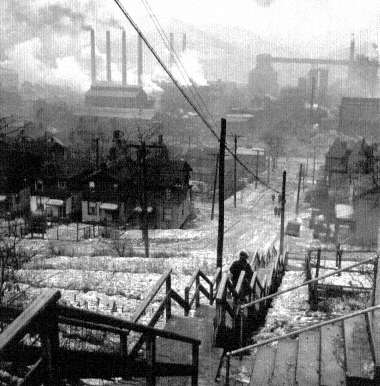
42.
Pittsburgh Mill District, 1940
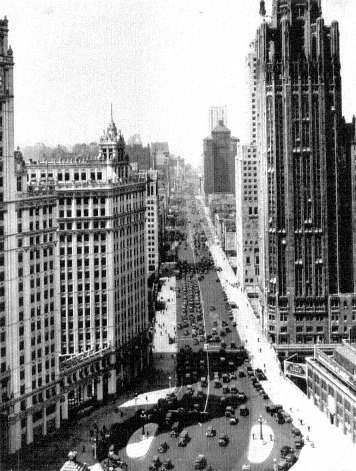
43.
Michigan Avenue, Chicago, 1933
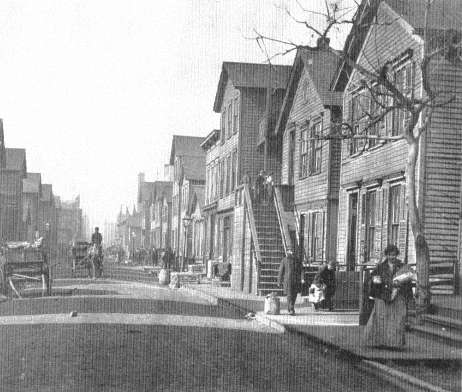
44.
Near 12th and Jefferson Streets, Chicago, 1906
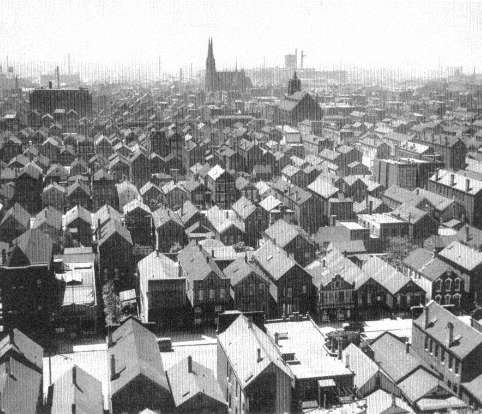
45.
Working-Class Chicago, 1934
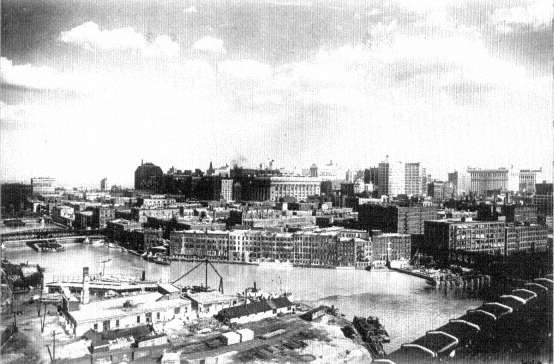
46.
South Water Street and the Chicago River, ca. 1920
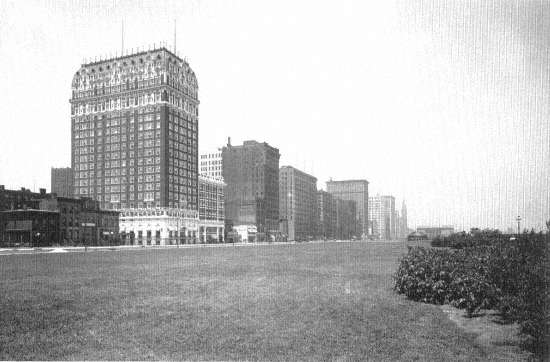
47.
Michigan Avenue and Grant Park, ca. 1910
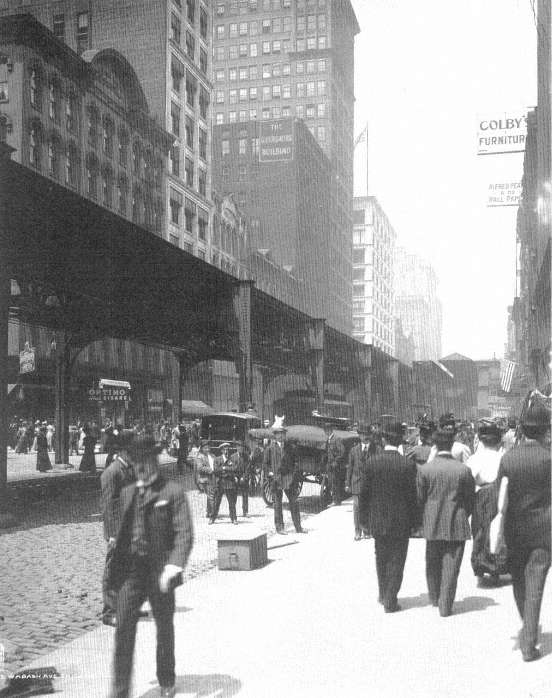
48.
Wabash Avenue, Chicago, 1907
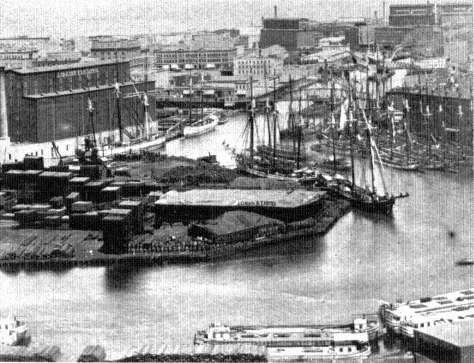
49.
Chicago River, Looking East Toward Lake Michigan, 1875
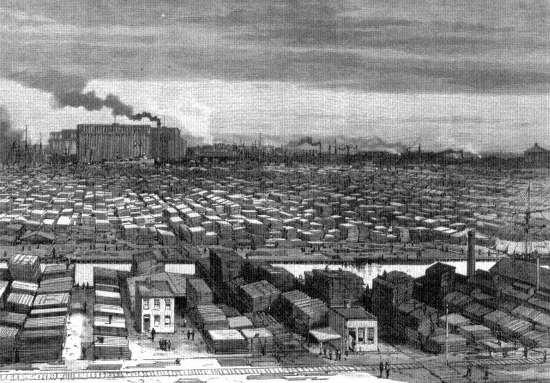
50.
South Branch of the Chicago River, 1883
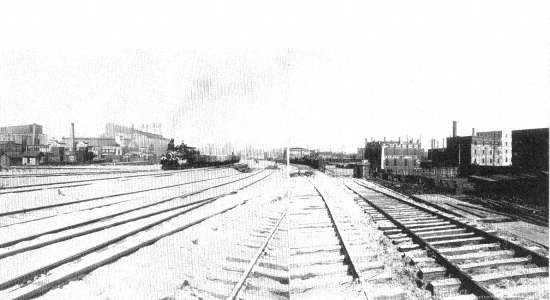
51.
Track Elevation at 23rd Street, Chicago, ca. 1907
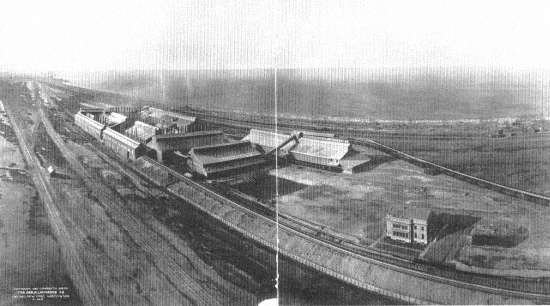
52.
Calumet Harbor—Gary Industrial Strip, 1908
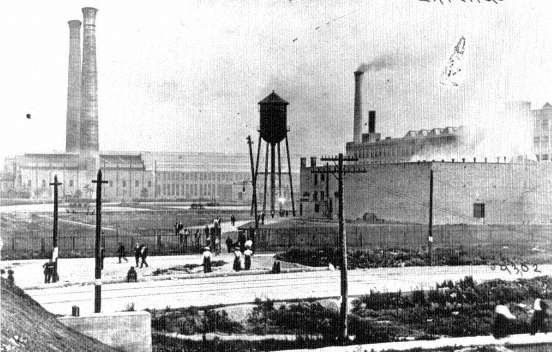
53.
Western Electric, Hawthorne Works, Cicero, ca. 1910
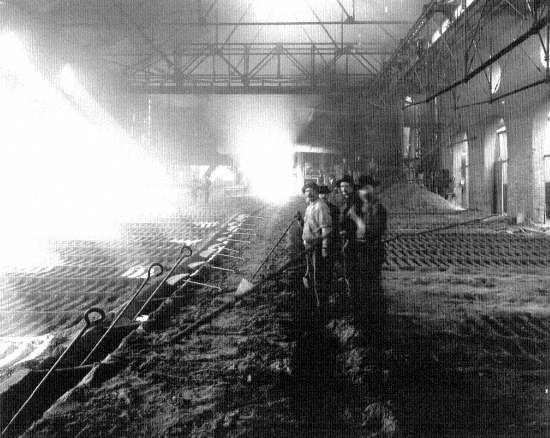
54.
Iroquois Smelter, Calumet Harbor, South Chlcago, 1906
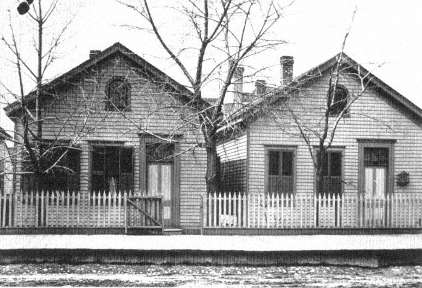
55.
Standard Housing, State Street, Chicago, 1868-69

56.
Standard Housing in Brick, Chicago, ca. 1912
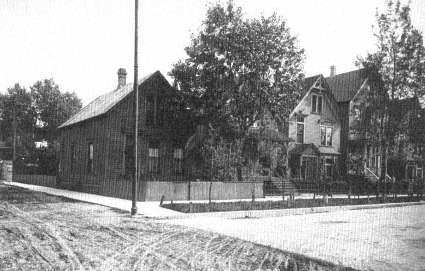
57.
The New Environment, Chicago, ca. 1912
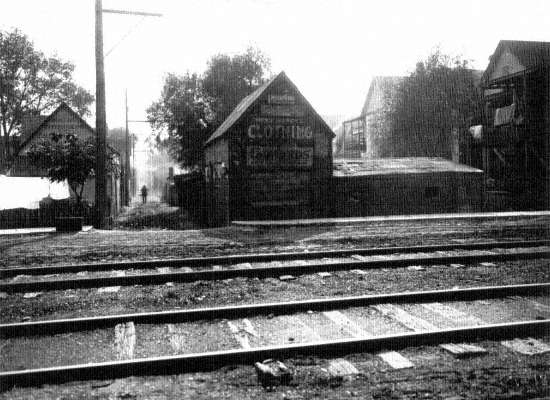
58.
Rear Yards, Chicago, ca. 1912
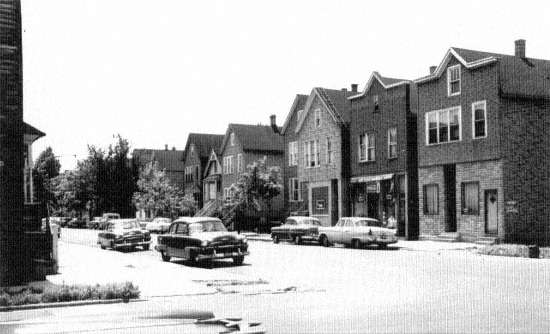
59.
Nineteenth-Century Housing, Chicago, 1959
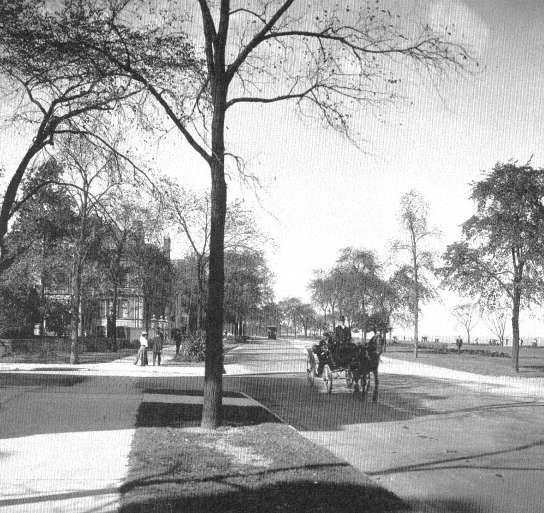
60.
Lake Shore Drive, Chicago, 1905
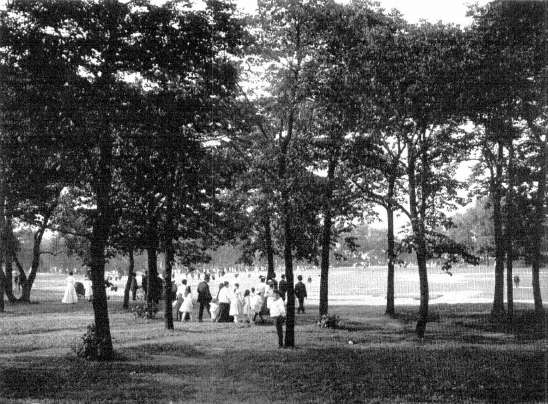
61.
Band Concert, Lincoln Park, Chicago, 1907
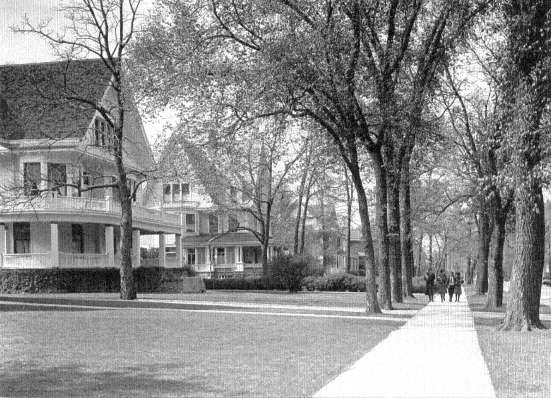
62.
Kenilworth Avenue, near Chicago Avenue, Oak Park, 1925
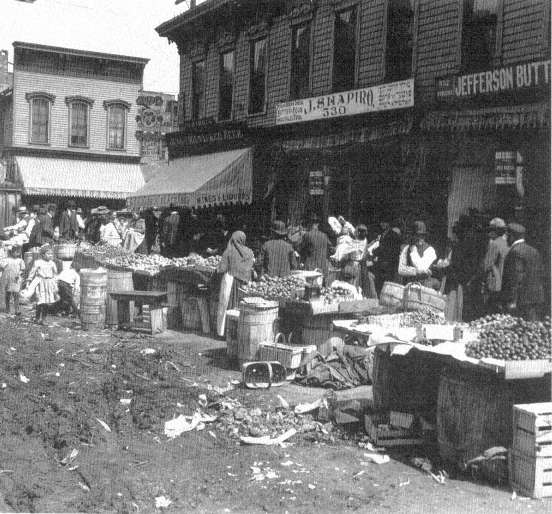
63.
Maxwell Street near Jefferson Street, ca. 1904-06
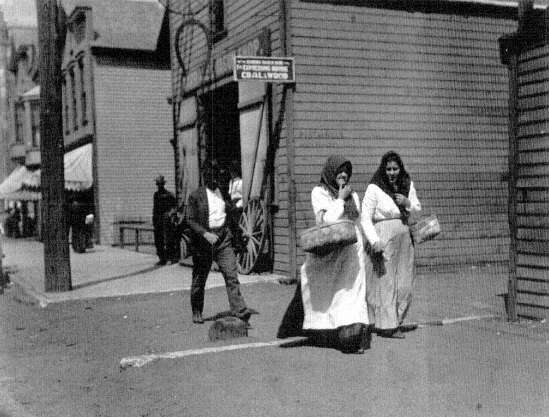
64.
Stock Yards District, Chicago, 1904

65.
Stock Yards District, Chicago, 1904
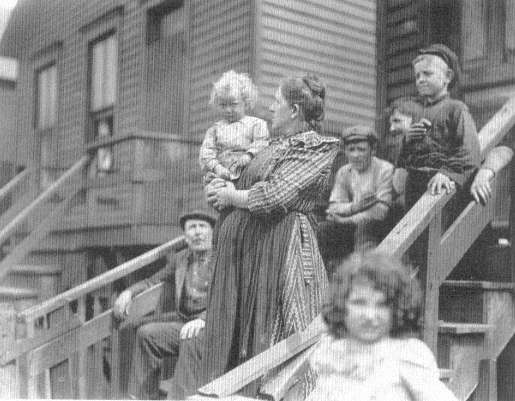
66.
Strikers Parade, Stock Yards District, Chicago, 1904
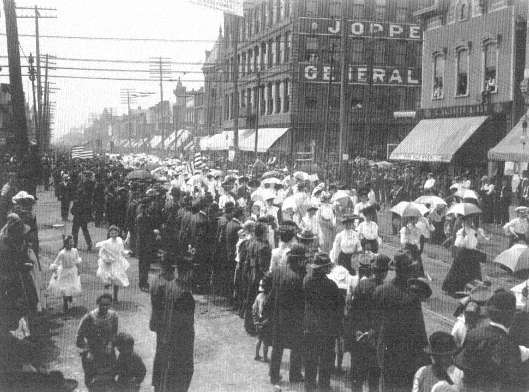
67.
Packing House Workers Strike Parade, Chicago, 1904
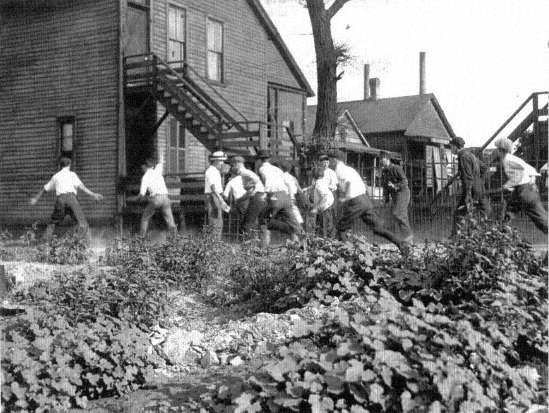
68.
Mob Hunting a Black Man, Chicago Race Riots, July 1919
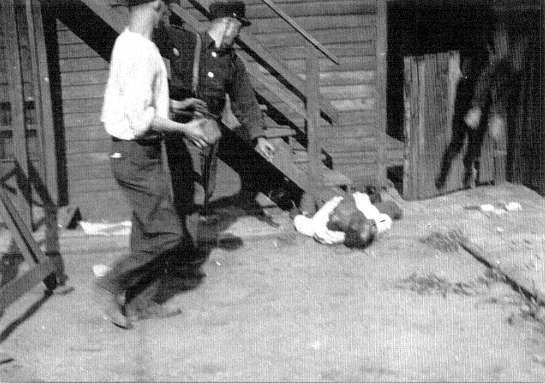
69.
Black Victim Stoned to Death, Chicago Race Riots, July 1919
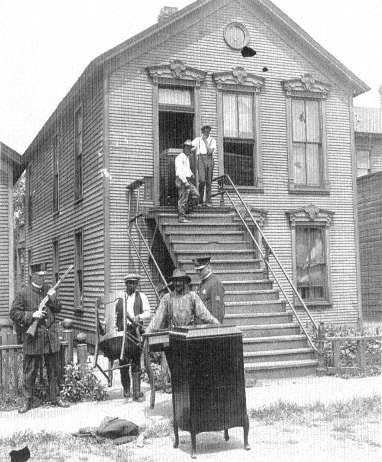
70.
Blacks Evicted from Their Houses, Chicago, July 1919
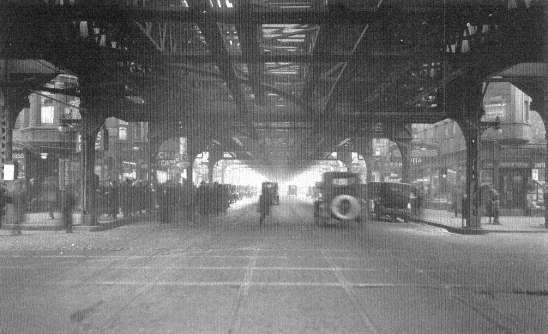
71.
Under the El, Chicago, 1924
perfecting of the railroad, and the unmistakable westward flow of the American population made the occupation of the Midwest profitable, Chicago rose to service this giant hinterland. By 1856, with the completion of the Illinois and Michigan Canal and ten trunk-line railroads, Chicago began its role as a major regional center. At first it functioned simply enough. Commercially it marketed the grain and animals of the new farms while managing the flow of capital out to the farms and towns of the newly settled West, and industrially it manufactured almost every item needed to run a railroad or start a farm, to build a town, to furnish a home, or to clothe a family. The geography of Chicago thus assured its future as a world metropolis. In addition, it was placed in the most rapidly rising sector of the national economy by the functions it performed in mechanized manufacturing, transportation, finance, and servicing of business[22]
The rapid growth of all the elements that composed the city's economy in this era—factories, railroad shops and yards, banks and exchanges, warehouses, offices, department stores, and so on—forced Chicago, and indeed all contemporary American cities, into a new spatial structure: the sector-and-ring pattern of settlement. The strictness of the segregation of this urban organization and the suddenness with which it swept over American cities holds much meaning for today. On the one hand the residential segregation patterns of this era, its core of poverty and rings of rising affluence, still prevail in many cities. On the other hand the swiftness and completeness with which Americans in this era overturned their former habits suggest that in the future strong changes in transportation, job location, and housing prices could easily revolutionize what now seem to be obdurate habits of city dwellers. If we really wished to abandon our current pattern of an inner ring of poverty and black segregation, we could probably do so as quickly as we suddenly assumed it during the late nineteenth century.
In Chicago in the years from 1870 to 1920, the location of jobs was governed by the concentration of economic activity in sectors: narrow pie-shaped wedges of commercial and industrial property stretching out from the downtown business center toward farmland yet to be developed beyond the city. Between the long corridors of the industrial wedges lay vast tracts of empty land, into which settled the major part of the population in three highly segregated great rings: an inner one of
[22] . Homer Hoyt, One Hundred Years of Land Values in Chicago , Chicago, 1933, pp. 53-59.
poverty and low income marked by cheap divided houses and old apartments, a middle ring of secondhand working-class houses and cottages, and an outer ring of better-quality apartments and homes (Figure V, page 106). In addition, the wealthy and their followers, the downtown white-collar workers, occupied a long wedge of their own, cutting across the rings and running from the fashionable shops and downtown offices outward along the lines of good transportation and attractive sites. By 1920 the axis of this corridor lay along Michigan Avenue and the north shore on Lake Michigan. This generalized sketch of the spatial configuration of Chicago in this era—the radial city with a single center—can be applied to the other industrial metropolises of the time. It was a pattern to which all of them roughly conformed,[23] and it was the very same pattern which the highway engineers rediscovered for themselves in their traffic studies of the 1930s.
The central point from which the industrial sectors of Chicago fanned out lay at the meeting of lake and land traffic at the mouth of the Chicago River. The two sectors that were occupied first ran along the north and south branches of the river, which divided a few blocks inland from Lake Michigan just north of the central downtown area that was to become the Loop. City commerce and settlement commenced at this center. It burgeoned with the opening of the Illinois and Michigan Canal in 1848 and was thereafter continually re-formed and rebuilt by unremitting industrial pressure. Ever since, the river has served as an inner harbor for the handling of grain and lumber and coal, and manufacturers have been attracted by the accessibility of transport. The river banks became the industrial sinews of the city. Here Cyrus H. McCormick (1809-84) built his reaper factory, originally on the North Branch; later on the South Branch when he rebuilt after the Chicago fire of 1871.[24] As the city grew, competition for central space drove the price of inner-city land up and up, and industry edged ever outward from the center along the branches of the river, paralleled by the lines of the railroad. Other businesses not immediately dependent on the complementary cluster of small firms and support from the downtown services followed them out—Montgomery Ward to the North Branch,
[23] . Robert E. Park, Ernest W. Burgess, and Roderick D. McKenzie, The City , Chicago, 1925, pp. 47-58; U.S. Federal Housing Administration, The Structure and Growth of Residential Neighborhoods in American Cities , Homer Hoyt, ed., Washington, 1939, pp. 72-78, 86-104; Harlan Bartholomew, Urban Land Uses , Cambridge, 1932, pp. 97-102.
[24] . Hoyt, Land Values in Chicago , p. 104.
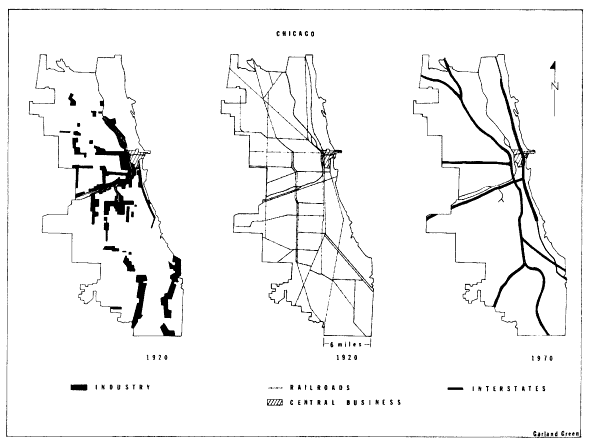
Figure IV.
Industrial and Transportation Structure of Chicago, 1920, 1970
SOURCE: Homer Hoyt, One Hundred Years o/ Land Values in Chicago,
Chicago, 1933; Center for Urban Studies, University of Chicago,
Mid-Chicago Economic Development Study, Chicago, February, 1966.
machinery factories to the South Branch, while others joined Sears, Roebuck in a due-west migration from the city center.[25]
The city core itself assumed a mature form in the early years of the twentieth century. At the center, land mounted in value until it was prohibitive to manufacturing and wholesaling on any considerable scale; instead the innermost streets blossomed with skyscrapers and theaters and stores, all the full flowering of an old-fashioned metropolitan downtown. Around this center, factories and commerce threw up an immense wall of structures. The wall was composed of factories that needed minimal space and so could remain near the center by occupying multi-story buildings and of wholesale houses that were dependent on downtown passenger stations, hotels, and customer entertainment.
It is clear that this era had spawned industrial sectors and a downtown far removed from the urbanism of New York in the preceding period, with its mixed commercial and residential center and informal fringes. Rather, every part of the industrial metropolis now became more rigidly compartmentalized with each year of growth. After about 1890, no neighborhood in the city of Chicago sheltered industry, commerce, and homes of all classes of citizens; segregation of industrial, commercial, and residential land became the hallmark of the metropolis.
Rail lines coming in from the West and South added two more manufacturing sectors to those created by the Chicago River and the tracks that ran parallel to it. The transportation activity itself tending the yards, repairing cars and locomotives, building all sorts of equipment from fishplates to Pullman cars—generated an enormous volume of employment. Chicago was the nation's foremost rail-terminal city, and the prosperity of its railroads did much to build its employment base. By complementarity and the sheer expansion of urban business, these new rail sectors attracted industry. Most famous were the stockyards and meat-packing houses of the southern sector, a development of 1865 at Thirty-ninth and Halsted Streets that comprised a hundred acres of cattle pens and two hundred and seventy-five additional acres devoted to slaughterhouses and packing plants. The dependence of this gigantic operation on cattle cars and refrigerator cars forbade any but a rail location.
The stockyards forecast a special urban characteristic of the industry
[25] . Center for Urban Studies, University of Chicago, Mid-Chicago Economic Development Study , Chicago, February 1966, pp. 16-37; Hoyt, Land Values in Chicago , pp. 82-85.
of the 1870-1920 period—the movement of mammoth enterprises completely outside the confines of the core city. Steel mills, electrical machinery plants, car factories, all industries that needed good transportation for great quantities of shipments as well as vast open land for future expansion, followed the meat packers' example in seeking locations at the fringes of the manufacturing sectors.[26] In 1880, George M. Pullman (1831-97) built his shops and model town south of the city, and he was soon followed by steel mills, cement plants, and the whole Calumet River heavy industrial complex. The United States Steel Corporation placed a brand-new integrated steel plant in Gary, Indiana, a city constructed for the purpose in 1905 just east of the Calumet concentration. The industrial satellite city, a mill town set within a metropolitan region where workers could live and labor in their own community instead of commuting to work, was a characteristic type of the era. All such satellites owed their appearance to the configuration of rail transportation and the scale of late nineteenth-century mechanized manufacture. As Chairman Elbert H. Gary set his new mill down outside Chicago, so Westinghouse built in East Liberty on the edge of Pittsburgh and Ford built at River Rouge outside Detroit.[27]
Finally a spatial relationship between the metropolitan railroad lines and the outer industrial locations should be mentioned, less for its impact on the structure of Chicago in this era than for its future consequences. The radial Chicago form had emerged from the railroads that served the industrial sectors, which fanned out from the core of the city. In addition, however, transfer of freight from one line to another and from one sector to another necessitated interconnections. The most inclusive of these linkages were the rectangular belt lines that crossed over the city's radial trackage to pass almost entirely around the city. A map of the railroads in this period can therefore be seen as the superimposition of a giant grid, reminiscent of the early township grid pattern, upon the older radial lines (Figure IV, page 103). Moreover, where the belt lines intersected the radials, still other centers were created. This evolving multicentered layout helped to relieve the city's inner terminals from the traffic congestion that inevitably tends to plague a strongly central-
[26] . Harold M. Mayer, "Localization of Railway Facilities in Metropolitan Centers as Typified by Chicago," Journal of Land and Public Utility Economics , 20 (November 1944), 299-315.
[27] . Graham R. Taylor, Satellite Cities, A Study of Industrial Suburbs , New York, 1915, pp. 1-67, 165-93; Glenn E. McLaughlin, Growth of American Manufacturing Areas , Pittsburgh, 1938, pp. 127-32.
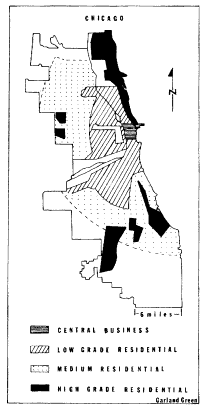
Figure V.
Class Rings and Sectors of
Residential Chicago, 1920 Source:
Federal Housing Administration,
Structure and Growth of Residential
Neighborhoods in American Cities,
Homer Hoyt, ed., Washington, 1939.
ized system with all the heaviest traffic concentrated at its center.[28] After 1900 the belt lines themselves became increasingly attractive to industrial firms. Western Electric, for example, moved its plant in 1903 to Twenty-second Street and Cicero Avenue on the outermost belt line.[29]
In the years after World War II, highway engineers began to appro-
[28] . The strong radial quality of the alignment of tracks in American cities made freight traffic jams endemic during the late nineteenth and early twentieth centuries and brought a catastrophic breakdown during the First World War. K. Austin Kerr, American Railroad Politics 1914-1920 , Pittsburgh, 1968, p. 40.
[29] . Hoyt, Land Values in Chicago , pp. 104-7, 213; Robert L. Wrigley, Jr., "Organized Industrial Districts," Journal of Law and Public Utility Economics , 23 (May 1947), 180-98.
priate the partially occupied land along the railroad corridors, and three of Chicago's four interstate highways have repeated in a rough way the radial and grid alignments attributable to the old railroads. When the next section of the interstate Crosstown Expressway is built along Cicero Avenue, the duplication of the old rail system will be complete, and Chicago will have constructed a crude grid layout of highways whose squares grow larger as one moves from the center of the city.[30] Such a pattern has proved highly efficient for the purpose of moving traffic through a multicentered network that serves multiple locations of origin and destination. It is a pattern that much resembles the one made by Los Angeles highways, a city that so fully exemplifies the era of the automobile megalopolis.
The great preponderance of urban land has always been taken up by residential lots and streets, and these miles and miles of neighborhoods filled the spaces between the industrial fingers of the metropolis. In the half century after 1870 these neighborhoods ceased to be a jumble of rich and poor, immigrant and native, black and white, as they were in the former era of the big city. Instead the neighborhoods of the industrial metropolis came to be arranged in a systematic pattern of socioeconomic segregation. The rings of residential settlement varied from inner poverty to outer affluence,[31] and this pattern of residential segregation was as characteristic of the metropolis of 1870-1920 as were its industrial sectors, its satellites, and its downtown areas.
The suddenness with which the new pattern settled upon American cities has been documented for Chicago by its social scientists. The new possibilities of cable and electric street transit worked with rapid growth and a middle-class fashion in suburban living and downtown shopping to revolutionize the social geography of the American city.
On October 9, 1871, the Chicago Fire burned out the core of the
[30] . Center for Urban Studies, Mid-Chicago Development , plates 13 and 14; Joseph R. Passonneau, "Urban Expressway Design in the United States: The Institutional Framework," Systems Analysis for Social Problems , Alfred Blumenstein et al., eds., Washington Operations Research Council, Washington, 1970, pp. 210-22.
[31] . The sector of the wealthy, occupying an attractive site and enjoying easy transportation to the downtown (Chicago's North Shore) is a significant exception to the ring arrangement of residential land. The reasons for a sector of the rich, not a ring, are twofold: the rich are not numerous enough to fill a metropolitan ring, and they can pay enough to control expensive land near the center of the city. The phenomenon of this sector in 1870-1920 cities has been shown to be general by Homer Hoyt, in his Structure and Growth of Residential Neighborhoods , pp. 112-22; and Peter G. Goheen, Victorian Toronto , pp. 201-13.
city and its North Side, leveling 2,100 acres of city land and destroying nearly a third of its structures. At first Chicagoans rebuilt their city in somewhat the same mixed central business and residential patterns with which they were familiar. With mortgage funds from the East, speculators rebuilt the downtown office buildings to a height of four and five stories instead of the previous two or three, while a few promoters hazarded six and even eight stories. But near the offices and stores, a block or two from the railroads, warehouses, and factories of the center of the city, many middle-class Chicagoans rebuilt their homes or settled into rented quarters or small hotels or boardinghouses in the core city.
During the 1870s the class pattern of Chicago homes bridged both the old and the new style of neighborhoods. The presence of some middle-class and well-to-do families near the downtown area recalled the old tradition, as did the outer location of many working-class dwellings. The new, however, was represented by a growing suburban fringe of middle-class families who were commuting to the downtown offices and stores.
During the next two decades the outmigration of Chicago's middle class completely reorganized the settlement patterns of the city. Instead of taking up vacant tracts in the partially built-up fringe where the working class were also settled, as had been the practice in the past, the middle class skipped over that ring entirely and settled itself in its own districts beyond. In Chicago the specific location of the ring of middle-class settlement had been determined by the building of a series of parks and boulevards in imitation of New York's Central Park and Baron Georges Haussmann's Paris boulevards. Finally mass suburban living was made possible by a succession of transportation improvements during the years from 1887 to 1894. Cable lines, electric surface lines, and elevated rapid transit all were introduced. Simultaneously, a uniform five-cent fare with one free transfer facilitated commuting.[32]
In this way Chicago's residential pattern by class had been fully set by 1894. The Loop was surrounded by decaying structures waiting to be taken up for commercial and industrial uses as the downtown expanded. Beyond this section, abandoned by the middle class, was the belt of working-class housing, close to jobs in the core city and close to the industrial sectors. Into the inner area poured the immigrants, native and foreign, and their poverty and consequent overcrowding of existing
[32] . Hoyt, Land Values in Chicago , pp. 104-7, 429.
homes transformed twenty-year-old middle-class houses and workers' cottages into the slums of the core city.[33]
With this new urban segregation of classes by housing, the core of poverty, and the rings of rising affluence, the working class came to assume the city-building role the middle class formerly performed. In the teens and twenties the working class, in order to find land to build upon or to rent, had to expand into those suburban areas which the middle class had already partially occupied, just as the middle class had earlier taken up vacant land in the mixed fringe of the old premetropolitan city. As their members moved outward they had to buy land that had already advanced in price in anticipation of suburban development. Often they found subdivisions of small lots which bore the charges of full city improvements, such as streets and curbs and sidewalks, city water and sewers, and gas and electricity, and which had to be built upon in conformity with modern building codes. The cheap working-class dwelling, the tiny wooden house or shack often built by the owner upon undesirable fringe land, now became a legal as well as an economic impossibility. Such housing returned only after World War II, with the trailer parks and self-help housing that occupy edges and pockets of the megalopolis. For most of the workers of the city the entrapment of the early twentieth-century housing pattern endured, and the loss of the single-family cottage which had been the staple of Chicago workers since long before the fire was never recovered.[34] From the first decades of the twentieth century dates the relentless shortage of decent detached homes for the blue-collar class and the widespread use of two-family and three-flat structures; by 1915, statistics showed that single-family homes had fallen to 10.8 percent of all new construction in Chicago.
The street railway, elevated in the Loop section, further influenced the makeup of metropolitan neighborhoods by nourishing the whole central-city retailing complex. Millions of men and women could now be carried cheaply in and out of the core to work and to shop. Although rows of stores sprang up along the streetcar lines and at the transfer points to serve the neighborhood, these stores faced intense competition from the shops of the Loop. Well-to-do women formed the habit of
[33] . For documentation of inner-ring housing conditions, see Edith Abbott and Sophonisba Breckinridge, The Tenements of Chicago 1908-1935 , Chicago, 1936, pp. 72-169.
[34] . Hoyt, Land Values in Chicago , p. 231.
shopping as a form of daily entertainment; for the women of the middle and working classes the seeking of bargains and major purchases in downtown stores became a focal point of their lives. To a degree perhaps not equaled since the 1830s and the heyday of the Broadway promenade in New York City,[35] the downtown district became the city for Chicagoans. It was the place of work for tens of thousands, a market for hundreds of thousands, a theater for thousands more. Yet for a city like Chicago, a metropolis of two million, even though its newspapers, tall buildings, and advertisements may have cried out for civic pride and unity, a downtown could not re-create the recognitions and sociability of a city of three hundred thousand like old New York. Instead the metropolitan downtown functioned as the symbol of unity and pride for a mass of individuals.
Chicago sociologists of the early twentieth century spoke of their fellow city dwellers as isolated individuals, cut off from each other by a screen of thousands of impersonal commercial contacts.[36] Surely the downtown and its crowds looked that way; so too did the Chicago novelists report it.[37] But the monumentality of the lake front and the Loop and their power as symbols misled the novelists. The sociological studies that have come down to us do not show a mass of two million discrete individuals but rather a highly fragmented society tightly structured along economic lines.
The scholars' reports gave the clue to the new social linkages: workers were tied to mills and foremen within them; immigrant laborers were tied to padrones and sweatshop bosses; office girls had been organized in clerical pools or became personal servants for the men they served; store clerks were at the mercy of buyers and merchants. The people of Chicago were systematized by work relationships and bound into a gigantic metropolitan economic web. The Chicago studies made plain how much of the city dweller's life was ordered by the sway of the boss, the foreman, and the buyer.
[35] . John A. Kouwenhoven, The Columbia Historical Portrait of New York , Garden City, 1953, p. 145.
[36] . Robert E. Park, "The City: Suggestions for the Investigation of Human Behavior in the City Environment," American Journal of Sociology , 20 (March 1915), 577-612.
[37] . For instance, Theodore Dreiser's Carrie Meeber in Sister Carrie (New York, 1900) and James T. Farrell's Studs Lonigan and his friends (New York, 1932-35) are overwhelmed by the early twentieth-century downtown environment which they experienced from the street. Inside the skyscrapers conditions were portrayed as more human, if also more vicious; cf. Henry B. Fuller, The Cliff Dwellers (1893).
In addition social investigations revealed that, despite basic economic ties and the class rings of residential settlement, no metropolitan class consciousness had emerged. In the residential districts there was further fragmentation by race, religion, and ethnicity.[38] Local politicians did their best to manipulate this configuration for their own ends, but it was a fragmentation without a uniform political direction. Harvey Zorbaugh's wonderful 1923 study of the near North Side of the city showed the cleavages. Here within a few square blocks lived the city's artists and writers and bohemians. There were streets of young people from the farms and small towns of the Midwest living in roominghouses and trying to find a place for themselves in the life of the city, as well as an enclave of Italian immigrants and a Persian colony, flanked along the lake edge by a narrow strip known as the Gold Coast and occupied by Chicago's oldest and wealthiest families. Such a district had not produced even district-wide power groupings, to say nothing of class consensus or political programs. Experiments by settlement-house workers or citizen volunteers to transform the district into a single social and political entity failed because the residents' significant ties were to their jobs, their homes, their ethnic groups.[39]
One extremely influential group, however, did live in the district and enjoyed city-wide ascendancy—the wealthy Anglo-Saxon Chicagoans of the Gold Coast. These families owned, controlled, or worked as professionals with the leading economic units of the city. For them the downtown and its towers were the effective center of the city. From the windows of their skyscraper offices they could look over the roofs of the city, and from their desks they could read the reports of the far-flung factories, shops, banks, and properties of the metropolitan region. It is no accident that the Commercial Club, whose members were the wealthy Chicago businessmen, should be the first to propose a city plan for the entire metropolis.
Zorbaugh concluded his study of social fragmentation by saying that the new industrial metropolis contained only one group who had the entire city as their focus, the men of the Gold Coast, and that therefore upon that group would depend the future of any program requiring city-
[38] . A recent study of elections in Chicago shows that, except for a few issues which particularly attracted the middle class, voting behavior was linked to ethnicity, not to class. See John M. Allswang, A House for All Peoples , Lexington, 1971, pp. 182-212.
[39] . Harvey W. Zorbaugh, The Gold Coast and the Slum , Chicago, 1929, pp. 182-220.
wide attention. Though an admirer of the generosity and wisdom of some of the Gold Coast families—indeed he thought them the city's only hope—Zorbaugh went on to point out that the structure of social relationships in the new metropolis was such that this elite could know nothing of the daily existence of the country boys and girls, the Sicilians, the Persians, and the bohemians who lived a few blocks away.[40] Remarkably, since the study was firmly rooted in the academic style of his day, Zorbaugh ends by describing the structure of the industrial metropolis in terms that parallel our modem assessment of the corporation which had made the industrial metropolis possible. He could have described his Chicago as Alfred Chandler did the early twentieth-century corporation:
Yet the dominant centralized structure had one basic weakness. A very few men were still entrusted with a great number of complex decisions. . . . Because these administrators had spent most of their business careers within a single functional activity, they had little experience or interest in understanding the needs and problems of the other departments or of the corporation as a whole. As long as an enterprise belonged in an industry whose markets, sources of raw materials, and production processes remained relatively unchanged, few entrepreneurial decisions had to be reached. In that situation such a weakness was not critical, but where technology, markets, and sources of supply were changing rapidly, the defects of such a structure became more obvious.[41]
Yet change, within the city and within the network of cities, had always been the essence of the American urban system. Even as downtown skyscrapers piled ever higher in the boom of the twenties, the breakup of the overcentralized, oversegregated industrial metropolis began.
[40] . Ibid., pp. 261-79.
[41] . Chandler, Strategy and Structure , p. 41.
5
The New Freedom
Los Angeles 1920- : bureaucracy, racism, and automobiles
Our Great Urban Conglomerations offer to the mass of people who inhabit them an illusively wide range of choices, whether of a way of life or of work among a diversity of social institutions. A high level of choice has always been a peculiar attraction of cities, and the wealthy have long flocked to them to enjoy the stimulation of variety and the satisfactions of freedom of personal expression. Even in colonial times the planters of South Carolina built town houses in Charleston, and mill owners and mining czars moved to New York and Chicago to escape the constrictions of the towns in which they had founded their fortunes. For the masses, however, whether white-collar or blue-, urban life was always severely constrained by long working hours, tight schedules of time and commutation, and the strict conformity required to hold a steady job, advance a career, or belong in a "nice" neighborhood. As a nation we have not yet traveled far from these conditions, and the blacks and the poor still struggle within this old framework to be admitted to the freedom of our cities. These are the unique qualities and terrible failures of our urban areas. Nevertheless in many basic structures of today's cities there is the potential of a range of personal choices and social freedoms for all city dwellers if we would only extend the paths of freedom that our urban system has been creating.
In brief, since 1920 the basic technology, transportation, urban markets, business institutions, and land-use structures of the growing
national network of cities have all expanded by means of successive inventions and investments until the entire elaborate modern urban complex has begun to reveal an increased potentiality for personal and social choices. The automobile did not by any means initiate the suburbanization of the American city, but it did enable suburbanization to take on a new low-density, multicentered form. Neither did the truck build the nation's manufacturing belts, but by lengthening the distance of cheap short-haul freight traffic it did enable the manufacturing belts to be reorganized into the far-flung communication regions we now identify as megalopolises. The corporation was very much a product of the nineteenth century, but its lusty growth in the soil of national urban markets brought decentralization with it, thereby placing more authority and autonomy in the hands of some of its employees. The turn of the national economy toward services from production began with the introduction of machine manufacture, but in our own time the proliferation of urban services has promoted and sustained a giant middle class without forcing it into a single role of corporate bureaucracy.
During the past half century these extensions from the past have mired our society in a series of contradictions and confusions which we must now come to understand if we are to find policies that will enable us to realize humane solutions. Every component of the forces that bear upon the American urban system, as well as the system itself, harbors twin potentials—for mass repression or for the expansion of popular freedoms. Science and technology can be directed toward war and manipulation or toward services for everyday living; the multiple ways of modern transportation can be either an escape route for the affluent or a means of expanding everyone's horizons; the service economy can be directed toward world domination or toward everyday human needs; the national network of cities can be linked only to the enrichment of local business and political elites or can become the foundation for broadened employment and equalized living standards; the reach and complexity of urban markets can be tied only to private profit or can provision a universal public; private and public corporations can be instruments for bureaucratic control or levers to release personal and group autonomy; the abundant land of the megalopolis can be restricted to the present unequal contest between the classes and races or can become the site of humane physical environments. Our history shows that the capacity of the American urban system for war production, private profit, and inequality, and for the ignoring and infliction of
deprivation and suffering is seemingly limitless and certainly enduring. What is new in our time is the enlarged potential of the system to promote the freedom of all the groups within it.
The trend toward the institutionalization of science and technology, well begun in the nineteenth century, has matured in full corporate form in the years since 1920. Private business has sponsored laboratories, universities have established science and engineering faculties, the federal government has financed and carried out massive scientific and technical investigations. This institutionalized effort, bolstered by motives of commercial profit, the conquest of diseases, and military competition, has produced an extraordinary acceleration of the preceding century's discoveries and inventions. Direct communication by telephone had been the previous era's only supplement to the indirect transmission of messages by letter, telegraph, photograph, newspaper, magazine, and book. Now mass-communication modes followed one upon the other, first movies, then radio, and finally television. Three complete transportation systems—the automobile, the airplane, and the pipeline—were added to the familiar rail and water networks. Mechanization matured into a harvest of small specialized tools from electric drills to oscilloscopes, while factory machinery grew in size and complexity to embrace complicated multistage production. Sophisticated machines capable of limited self-correction, often guided by computers, carried out automated sequences of manufacturing and processing. White-collar work, formerly geared to pens and pencils, typewriters, adding machines, and filing cabinets, was mechanized by the computer and by a host of machines for printing and sorting, copying and recording, and mailing. To serve production needs, science and technology created materials of every conceivable kind from metals and plastics to drugs and compounds. Atomic power, a whole new energy system, came into being.[1]
So overwhelming was the power and scope of the expanding knowledge and technical achievement in the United States and other advanced countries that nature itself came to be approached as a man-made artifact. Just as a building stands or falls at the whim of human decisions, so now a lake persisted or became a swamp, a plant or animal species multiplied or died out, depending upon the fiat of man. Nor did man himself escape the reach of scientific enterprise. The social sciences
[1] . Melvin Kranzberg and Harold W. Pursell, Jr., Technology in Western Civilization , II, New York, 1967, pp. 37-52, 309-34.
(especially macroeconomics, market and opinion research, and group and individual psychology) have subjected all levels of society to systematic management and have placed human life under the threat of manipulation.
Yet in the onrush of science and technology each set of tools, each product or technique, held within it recurrent possibilities for a conflict between autonomy and control, centralization and decentralization, personalization and standardization. For example, the making of an automobile required great precision and heavy investment for complicated mass production. As a result the auto worker was habitually subjected to degrading discipline and a stultifying simplification of his tasks.[2] The dignity and independence implicit in the worker's pride in his suburban home were radically contradicted by his working conditions. Similarly the freedom he experienced in his daily drives through the city, for shopping and visits to friends, found no counterpart in the exigencies of his job.
Radio has imposed a form of tyranny in its national propagation of politically manipulated news programs and commercial advertisements, but it also has been an important medium of expression and communication for special publics who make and consume classical music, rock music, black culture, and Bible evangelism. Computerized cost accounting and inventory control have served both to draw decision-making from branch sales offices and factories to the central office and to allow greater branch autonomy. The computer's ability to keep track of complex information and to monitor a multiplicity of distinct programs enables the home office to decentralize decision-making with the assurance that it can keep track of what is happening in its diversified undertakings. Finally, the new social sciences have shown that they are powerful at all levels of society. They can subdue business cycles that formerly scourged all highly developed countries, or they can provide the rationale for the grossly inequitable manipulation of economies; they can enhance the productivity of small groups of workers or mitigate the stresses of racially torn schools and housing projects; they can relieve the mental suffering of individuals. Yet the conflicts of the uses of science and technology pervade the social sciences as well. The question returns and returns of whether social science will become the servant of centralized national government and private and public corporations
[2] . Robert Blauner, Alienation and Freedom, The Factory Worker and His Industry , Chicago, 1964, pp. 89-123.
and be turned to the control of society, or will nourish the autonomy of small groups and promote individual freedom and happiness.
The elaboration of the new transportation system was the most direct instrument for the multiplication of men's choices. Automobiles allowed rural migrants seeking jobs in the city to keep in touch with the countryside and the folks back home, freed urban workers from the necessity of living next to their factories or in central city slums, and gave businessmen an unprecedented choice of locations and complementary services. Production and marketing could devise numberless combinations of diverse services and suppliers and use them within and between the metropolitan regions. Key improvements in transportation lay along two quite different paths. The first set of improvements was directed to lengthening the range of short-haul traffic; the second multiplied the modes of long-haul traffic so that long-distance shipping reflected more specific adaptations to products and passengers than had former all-purpose rail systems and hence were capable of a higher degree of efficiency.
The change in the costs of short-haul transportation was probably the single most important factor to influence the dispersal of job locations within the modem metropolis. Intracity freight movement had formerly been dependent on men and boys who carried parcels in handcarts or on horse-drawn wagons, and its slow pace and high costs had restricted business users of freight service to rail locations in the manufacturing sectors or near the central terminals of the inner city. Small firms were crowded around a downtown post office or inner-city freight yard; more expansive firms with a steady traffic in whole carloads of material could and did settle on spur tracks in the outer rail sectors.
Slowly the truck and automobile loosened and broke these constraints. In the first thirty years of the twentieth century the motor truck, with its obvious advantages in speed and cost over horse teams, was introduced.[3] Although it offered a more efficient alternative to the railroad, the truck did not as yet alter existing rail patterns, because its full realization awaited highway improvements. It is true that during the twenties streets on the periphery of the metropolises were paved and intercity roads improved by the U.S. Route system. Had not the Great Depression intervened just then, a pronounced outward industrial movement would doubtless have got under way in the thirties. As it was,
[3] . Leon Moses and Harold F. Williamson, "The Location of Economic Activities in Cities," American Economic Review , 57 (May 1967), 214-15.
dispersion awaited the building of war plants on the fringes and the postwar manufacturing and housing boom.
By 1948, when wartime shortages trod been overcome and the United States had returned briefly to a civilian economy, the truck and automobile did at last free many firms from traditional central locations. Trucks of all sizes could move up to a third of the load of a standard railroad car quickly and cheaply to any destination within a hundred and fifty miles. Overnight trucking service could serve points from two hundred and fifty to three hundred miles apart, and since the perfecting of diesel trucks in the fifties the ranges for both daytime and overnight hauls has been lengthening. Thus a location on any major highway became an excellent departure or terminal point for any except the heaviest freight users, such as lumber mills, foundries, and sugar refineries. At the same time, the widespread private ownership of automobiles released all but the lowest-paid third of the work force from dependence on the streetcar and rapid-transit lines, which were still running radially from suburbs to downtown. Like the freight, workers could now travel in their own cars in any direction through or beyond the metropolis. The result since World War II has been a steady and substantial outmigration of firms and, even more significant, the placing of new enterprises wholly outside the bounds of the central core of each metropolis.[4]
In old cities like Boston, the circumferential highway, built around the fringes of the city and designed to tie together the roads radiating out from the center, has become the axis of industrial growth. In fast-growing cities like Los Angeles, fingers of manufacturing crept out for thirty and forty miles from the old central core. The original industrial development there had taken place at a close knot of rail lines in the southeast sector of the city. As the metropolis became a major national manufacturing region, freeways paralleled the old rail network, and industry stretched farther and farther in every direction to create employment opportunities all over the city.[5]
Despite the advances in transportation, firms that required the most immediate complementary interaction remained at the core. The metropolitan center has retained the firms that depend upon transient eddies
[4] . Benjamin Chinitz, Freight and the Metropolis , Cambridge, 1960, pp. 120-27, 130-57.
[5] . Los Angeles Chamber of Commerce, Industrial Development Map, Los Angeles Five County Area , Los Angeles, 1969; Los Angeles Regional Transportation Study, Base Year Report 1 (December 1963), p. 36.
of fashion, such as the garment trade, publishers, and art dealers. The center has also been partially rebuilt with office towers to house the headquarters and regional offices of the great corporations that need the traditional cluster of bankers, lawyers, and accountants and the more recent public-relations and advertising firms. But the downtown has failed to capture even a majority of the office and commercial growth of the metropolis. Some stores have followed their customers to the suburbs; others have found that office routine, sales, and professional services can be performed as effectively in suburban shopping centers as in the urban confines.[6]
The benefits accruing from the changing patterns of work locations were obvious and substantial. With the improvement of metropolitan highways, immense tracts of industrial and residential land opened for use and the cost of urban sites fell. Employer and employee alike gained over their 1920 condition. The employer could easily purchase from and sell to firms within a radius of fifty to four hundred and fifty miles of the megalopolis, and he could furnish or obtain daily service within a fifty-mile radius of the metropolis itself. Similarly the employee found an extensive range of jobs inside the fifty-mile radius, and he could live almost anywhere within the metropolis and still take advantage of the widened job market.[7]
In terms of the physical form of the city, this freedom from spatial restrictions offered an unprecedented array of urban arrangements for all degrees of population density. The highway interchange could support areas crowded with row houses, factories, and apartment and office towers, which could yet be wholly encircled by forests or fields; suburban streets and freeways could sustain a uniform spread of houses and lawns and tree-lined streets, interspersed with shopping strips or centers and industrial parks. Unfortunately, for reasons having to do in large part with organization of the land and real-estate market, the great variations in urban design that might have been feasible under the transportation revolution have not been fully exploited in America.
The principal drawback of the evolving pattern lay in its entrance fee: private ownership of a car. Young people, old people, poor people could gain access to metropolitan jobs only by means of a private
[6] . John F. Kain, "The Distribution and Movement of Jobs and Industry," in The Metropolitan Enigma , James Q. Wilson, ed., Cambridge, 1968, pp. 1-32.
[7] . Stanley Lebergott, "Tomorrow's Workers: The Prospects for the Urban Labor Force," in Planning for a Nation of Cities , Sam Bass Warner, Jr., ed., Cambridge, 1966, pp. 124-33.
automobile or through a car pool. In the homes of low-wage and unskilled workers, a decent income can be earned only when two members of the family work. For the wife, the finding and reaching of jobs, often widely scattered in the metropolis, has proved extremely difficult. Transport networks have tended strongly to reinforce racial segregation in employment and housing by confining the poor, especially poor women, to a depressed inner-city labor market.[8] In the core of most cities the old 1870-1920 public transportation system is still maintained; at the core too are the decaying slums that still house the black and white poor. Here manufacturers can find a large reservoir of low-skilled workers. As a result a cycle of underpaying jobs, constricted transport, and ghetto living has settled upon many of our old metropolises. In New York City proper, manufacturing wages fell behind those of Birmingham, Alabama;[9] elsewhere the women and the old and the poor await the perfection of a public transportation system that, by imitating the highway patterns of today's diffused metropolis, will let them participate in the society as full-fledged members.
Advances in long-haul transportation over the past fifty years have reinforced the nationalizing accomplishments of the earlier rail lines, which the new systems supplement. In the exploitation of natural resources, oil and gas pipelines bring cheap fuel to cities thousands of miles from the Oklahoma and Texas wells in a volume that railroad freight could never have handled. Improvements in the Midwestern river system have revived barge traffic in coal, grain, cement, and other bulk commodities so that the old Ohio-Mississippi route is again functioning as a carrier of cheap resources as it did before the Civil War.
Since World War II the long-haul truck has combined with air freight to sustain the national manufacturing economy by moving small quantities of goods quickly and inexpensively. Parts for a broken machine, a tub of a particular chemical, a broken instrument being returned to its manufacturer for repair—all these can be shipped between the most important centers in the nation in a matter of hours. Long-haul truck service supplements air freight by allowing firms with less than full rail carloads to ship materials and semifinished goods directly from one factory to another within a day or two and to do it
[8] . John F. Kain, "Housing Segregation, Negro Employment, and Metropolitan Decentralization," Quarterly Journal of Economics , 82 (May 1968), 175-97.
[9] . Nathan Glazer and Daniel Patrick Moynihan, Beyond the Melting Pot , Cambridge, 1963, pp. 299-300.
more cheaply and with greater dispatch than on the railroad's old circuitous less-than-carload routing. Altogether, the addition of truck and airplane facilities and the more specialized barge and pipeline service to the old rail network has meant a burgeoning of the paths and volume of American traffic. Goods move swiftly and cheaply within the cities of the old manufacturing belts of the Northeast and Midwest and within the new southern California region. Moreover, despite the long distances involved, shipments travel easily back and forth between the manufacturing regions and the growing metropolises of the South and West. The transcontinental production of aerospace components, especially in Massachusetts, Connecticut, New York, New Jersey, Missouri, Texas, and California, has been an outstanding example of present possibilities.
The proliferation of technology and transportation has strongly influenced both the national economy and its network of cities. The continued application of science and technology to agriculture and mining has brought an increasingly dramatic decline in employment in that sector of the economy and a concomitant strong outmigration from the rural United States. The sheer productivity of mechanized manufacture, despite the multiplication of products and the vast increase in the volume of factory-made goods for producers and consumers, has allowed the ratio of the labor force engaged in that sector to fall slightly too. Trade, services, transportation, and government have become the hallmarks of today's economy because two-thirds of the labor force is engaged in these activities. Science, technology, and transportation have made possible the service and military economy that now obtains.[10]
The changing focus of the national economy has meant a corresponding adjustment in the network of cities. Urbanization in general was encouraged because the growing trade-service-transport-government activities were themselves the specialties of cities. Thus the population of the United States, North and South, East and West, grew increasingly metropolitanized. Ports and trading centers, on both coasts and along the Great Lakes and in the South, prospered in particular. If we measure the size of cities solely in terms of the inhabitants within their formal political boundaries, Houston rose to be the nation's sixth most populous city, Dallas the eighth, and San Antonio passed Boston and St. Louis, while the size of Memphis, New Orleans, Seattle, and Phoenix each exceeded that of Pittsburgh—the archetypical city of the former
[10] . Harvey S. Perloff, et al., Regions, Resources, and Economic Growth , Baltimore, 1960, pp. 234, 465.
era of the industrial metropolis.[11] The simple tabulation of the size of cities according to their political boundaries highlights the importance of the new trading cities (Table 1, page 70), since their growth countered the outmigration of population from old core cities like New York, Chicago, and Boston. By these additions to the list of cities of metropolitan size, the category was able just to maintain the same proportionate share of the nation's population from 1920 to 1970. Beyond serving as a general encouragement to urbanization, the new economy instilled vigor into the small cities and towns—places of 2,500 to 249,999 inhabitants. These were the building blocks of the new economy, and their share of the population rose to 52.4 percent (Table 1, page 70). Such cities and towns were found everywhere in the nation and made up the constituent elements of the 243 Standard Metropolitan Statistical Areas classified by the census. Some like Arlington and Richardson (Dallas), Hollywood (Miami), Mesa (Phoenix), Overland Park and Independence (Kansas City), and Bloomington (Minneapolis-St. Paul) contributed to the metropolitanization of the West, Midwest, and South. Others were beneficiaries of the continued growth of the basic manufacturing regions of the nation: Orange and Garden Grove (Los Angeles), Joliet and Oak Lawn (Chicago), Warren and Livonia (Detroit), Kettering (Dayton), Framingham (Boston), Norwalk, Piscataway, and Bay Shore (New York), Willingboro (Philadelphia), Catonsville (Baltimore), and Silver Spring (Washington).
The complexity of manufacturing in the new economy was compatible with the dispersal of urban population from old central cities, but at the same time it fostered a concentration of population within large multicity regions. Thus the old manufacturing belts of the Northeast and Midwest, and the new one in southern California, prospered as the urbanized manufacturing regions of the United States.[12] The major trend in manufacturing locations since 1920 has been to seek sites near
[11] . The rank list of cities in 1970 according to their political boundaries: New York 7,895,000; Chicago 3,367,000; Los Angeles 2,816,000; Philadelphia 1,949,000; Detroit 1,511,000; Houston 1,233,000; Baltimore 906,000; Dallas 844,000; Washington 757.000; Cleveland 751,000; Indianapolis 745,000; Milwaukee 717,000; San Francisco 716,000; San Diego 697,000; San Antonio 654,000; Boston 641,000; Memphis 624,000; St. Louis 622,000; New Orleans 593,000; Phoenix 582,000; Columbus 540,000; Seattle 531,000; Jacksonville 529,000; Pittsburgh 520,000; Denver 514,000. Nineteenth Census: 1970, Number of Inhabitants, Final Report PC(I)-A1 , Washington, 1971, Table 28.
[12] . Perloff et al., Regions, Resources and Economic Growth , p. 462; Beverly Duncan and Stanley Lieberson, Metropolis and Region in Transition , Beverly Hills, 1970, pp. 154-242.
the final markets for consumer goods and to search out effective placement in the midst of regions where producers' goods can be bought and sold easily. Both trends favored the old manufacturing belts because these were huge agglomerations of individual consumers and also buyers and sellers of producers' goods. The mass migration to southern California and the succession of wars since 1941 have transformed that region into another such belt. The diffusion of population and enterprise within these three regions has altered their former patterns of mill town and industrial metropolis established in the railroad era. The megalopolis, a gigantic continuous band of urbanized territory with towns, cities, and metropolises embedded within it, is the emergent urban manifestation of the new economy and new transportation. The Boston-New York-Washington megalopolis has functioned at least since 1950 as a regional city; the Pittsburgh-Cleveland-Detroit-Chicago megalopolis seems to be a recrudescence of the old Midwestern manufacturing belt but in a form that favors growth along the path of the region's largest metropolises; while the third, stretching from San Diego through Los Angeles to San Francisco, has become recognizable as a growing entity only in the last decade.[13] The megalopolises are of about equal length. Each of them extends 454 to 470 miles, and all of them are abundantly provided with transportation. They are in every case industrially diversified and encompass thousands of specialized firms so that the benefits of complementarity obtain for almost any economic enterprise, from steel mills to toy manufacture, throughout the regions.
The channeling of national metropolitan growth into the formation of the three megalopolises has had two effects upon the organization of urban business: first, corporate enterprise has expanded and altered its management form; second, the service economy has nurtured an enormous class of urban professionals and small businessmen—retailers, furniture dealers, doctors, lawyers, insurance agents, and every kind of home and business service establishment. Both developments contain possibilities for a more humane urban society and equally for the further concentration of power exercised for the benefit of a minority.
The large corporation, as it added more products and services and reached ever farther afield for customers, was forced to abandon its
[13] . Jean Gottmann, Megalopolis, the Urbanized Northeastern Seaboard of the United States , Cambridge, 1961, pp. 150-213; Constantine A. Doxiadis. Emergence and Growth of an Urban Region, The Developing Urban Detroit Area , Detroit, 1966-1970, I, pp. 75-113; III, pp. 25-51.
traditional centralized, departmentalized form. Instead it adopted various adjustments that resulted in a general way in a hierarchy where a central office of staff executives assessed and assisted a series of semi-autonomous divisions. This decentralized, divisional structure owed its origins to a management crisis of the 1920s. In the four cases that have been studied in detail (General Motors, Du Pont, Standard Oil of New Jersey, and Sears, Roebuck) a growing diversity of operations finally broke the centralized form. General Motors made many different models of cars—unlike Ford with its Model T—and also turned out refrigerators, electrical equipment, and an extensive line of parts and accessories. Du Pont branched out in the first years of the century from gunpowder and blasting materials into chemicals and paints. Standard Oil of New Jersey undertook international oil prospecting, oil transport, and refining, along with the domestic and foreign marketing of a full range of petroleum products from automobile gasolines to fuel oils and the old staple, kerosene. Sears, Roebuck, already a profitable mail-order house, in 1925 established a national chain of retail outlets to offset declining sales and to reach out to the growing suburban markets.[14]
In each case diversity of operations brought financial losses and crises in management. In each case the solution proved to be reorganization of management in such a way as to break up departmental structure. Before this time the vice-president of each central office had concentrated on one major phase of the business—production, sales, development, or finance—and the day-to-day decisions had originated with him and his staff in the central office. The crisis in management arose when these executives could not distribute the flow of products among the departments, when production poured out more items than the sales force had orders for, when the executives, oriented each to his own specialty, could no longer intelligently allocate staff and capital among the departments.[15]
The multidivisional structure instituted in the big diversified corporations during the 1920s assigned the central office to staff service for the entire corporation but relieved it of everyday decisions, which were now passed down to divisional heads. Each division—at Du Pont, divisions were respectively responsible for paint, dyestuffs, explosives, films, and so on—had a general manager to supervise production, sales,
[14] . Alfred D. Chandler, Jr., Strategy and Structure, Chapters in the History of the Industrial Enterprise , Cambridge, 1962, pp. 289-302.
[15] . Ibid., p. 71.
and personnel. The central office evaluated the success of each division in relation to the others, either granting increased budgets or cutting back an operation on the basis of its individual performance as it related to prospects for the entire corporation. The staff of the central office also conducted studies in market research, engineering, and design, and in its own accounting department it strove to assure the prosperity of the complete enterprise. If the performance of one division showed low profits, the central staff either closed out the operation or stepped in to reorganize it. In short, the role of the central office resembled that of an investment banking house, placing corporate capital as best it could among the divisions or using accumulated profits to purchase related independent firms and thereby to add more products or even divisions to the undertaking. For its part each division, its partial autonomy assured by an annual budget, was free to purchase materials wherever it could find them and was no longer restricted to contracts made by a central purchasing office. It could assemble its own sales force, locate plants and warehouses, and until the arrival of national industry-wide unions could make its own terms with local labor.[16]
In the United States, World War II initiated an almost uninterrupted thirty years of intensive demand for industrial products. That war and the succeeding wars in Korea and Vietnam stimulated arms production while the government policy of cold-war military rivalry with the Soviet Union and China spurred naval, air, and space research and weapons production on a scale of wartime magnitude. During the same years the elaboration of science and technology in the United States, Europe, and Japan brought forth a steady stream of consumer products, such as tape recorders, dishwashers, gasoline lawn mowers, paints, and drugs. The combination of both domestic and foreign military and consumer demand encouraged corporations to diversify by taking up additional sales regions and new products, and in time this always meant the adoption of a decentralized form of operation.
Today's business structure reflects these historical solutions. The strength of the corporate form as an institution for managing accumulated capital is attested by the sheer gigantism of American corporate enterprise. The smallest corporation on Fortune's 1971 annual list of the nation's five hundred largest had 7,850 employees, the largest were as big as nineteenth-century cities: General Motors had 696,000 em-
[16] . Peter F. Drunker, The Concept of the Corporation , New York, 1946, pp. 46-68.
ployees, Ford Motor Company 432,000, General Electric 397,000, International Business Machines 269,000, Standard Oil of New Jersey 143,000. Among the retail chains, Sears had 359,000 employees, A&P 120,000; American Telephone and Telegraph employed 773,000; Consolidated Edison, the electric monopoly for New York City and nearby New York counties, 23,726; the Southern Pacific Company had grown to 42,000, United Airlines to 66,000, the Prudential Life Insurance Company to 59,000, the Bank of America to 36,000, the First National City Bank to 37,000. Such immense institutions could be managed only by committees and decentralized forms of governance.[17]
Decentralization today takes a number of forms. The semiautonomous divisional style of the 1920s is favored by the new conglomerates, which are aggregations of capital assembled by a team of central-office executives who seek to purchase independent businesses for profitable investment. If the newly acquired business proves to be well managed, its executives continue their work as an autonomous division of the conglomerate. This is true for instance, of Litton Industries of Beverly Hills, California, a firm that began in 1954 in electronics and now deals in typewriters, calculators, office furniture and equipment, surgical instruments, X-ray machines, motion-picture cameras, and automatic revenue-collecting machines, and also operates paper mills, printing plants, and Great Lakes shipping lines. It manages its diverse affairs through fifty separate divisions, each largely autonomous.[18]
The reach to the ultimate consumer has meant market-oriented decentralization for manufacturing firms as well as for retailers. The goal of management has been to adjust production to sales as closely as possible and thereby to reduce losses sustained by the accumulation of unwanted and slow-moving inventories. Abundant long-haul transportation enabled manufacturing firms to maintain specialized production plants, each located for its specialty's best advantage, where components could be manufactured and then assembled into the final product near the final markets. Cheap intracity transportation encouraged such a strategy; one sales-warehousing-assembly plant could serve an entire metropolis or a cluster of them. Thus a famous brand of St. Louis beer no longer travels by refrigerator car from a single brewery to scattered urban markets but is brewed in Tampa, Newark, Houston, and Los
[17] . "Fortune Directory of the 500 Largest Industrial Corporations," Fortune , 83 (May 1971), 170-204.
[18] . Business Week (April 16, 1966), 175-185.
Angeles and marketed regionally from these points. Chevrolets are assembled at Arlington (Texas), Baltimore (Maryland), Doraville (Georgia), Janesville (Wisconsin), Leeds and St. Louis (Missouri), South Gate and Van Nuys (California), North Tarrytown (New York), Willow Run (Michigan), and Wilmington (Delaware).[19] Here, then, were some of the multitude of plants and offices that have sought suburban locations since World War II. Retail chains like Sears, Roebuck and Montgomery Ward have evolved a commercial style that they call metropolitan management. A metropolis like Los Angeles may have a dozen retail stores belonging to one of these chains, each store located in a regional shopping center. The sheer volume of Los Angeles sales, as well as the peculiarities of that particular market as opposed to the Chicago or New York demands, justified the establishment of a metropolitan management team responsible for operations in that area. For general merchandising, unlike the distribution and sales of a limited range of products like automobiles or beer, the metropolis has proved to be a more feasible unit than the sprawling megalopolis.[20]
In these cases of decentralization it is easy to see how a measure of public responsibility could be introduced into the national corporate structure. The special interests of the metropolis or megalopolis in employment, plant, office, and store location, and the need of workers and managers for autonomy, could be expressed in management committees of public officials and employees without disrupting the efficiency of the corporation since the current dispersal of the company mirrors the structure of the national network of cities. Other recent management forms, however, are less easy to accommodate to urban requirements.
The huge scale involved in the production of aircraft and of military needs, power plants, and the complexity of other large contracts has moved some firms toward project management, in which teams of engineers and executives are formed around a particular job. They seek the contract and coordinate the work of design and production divisions and other departments of the parent company with outside firms who become subcontractors. Sometimes called "matrix management" because the men responsible for the single contract are given budgets and authority that cut across the lines of regular organization structure in the corporation, this form reintroduces centralized power into all branches
[19] . Ward's Automotive Reports , August 10, 1970.
[20] . Fortune , 82 (May 1970), 231-45.
of industrial enterprise. Though the device is effective (indeed insisted upon by the U.S. Air Force, which wants a single group to call upon for each major contract), it creates frequent conflicts within the firms that use it.[21] It also promotes urban and regional irresponsibility. Once the contract is secured, the project is insulated from all concern for such issues as working conditions within the offices and plants either of the parent company or of its subcontractors, and these become problems solely of divisional and departmental managers. The project is freed from concern for local employment or for the ecological consequences of the aircraft, power stations, or factory complexes it builds, since the project team's task is directed only to getting the job done. A consequent social irresponsibility is spreading throughout American corporations.
On a smaller scale, makers of highly competitive mass consumer products are using product managers to take charge of a single item, like Procter and Gamble's Crest toothpaste. Also, venture teams of designers, engineers, and marketing specialists are being formed to search for and test new avenues for the investment of a corporation's accumulated capital.[22] As in the project, the venture team is not responsible to the division, the department, or a geographical area but only to the national headquarters, where the criterion is profit alone.
The outcome of five decades of these contradictory decentralized and centralized business trends is a mixture of benefit and condemnation for the urban worker and city dweller. Thanks to the sheer growth of big business, industrial work, which in the preceding century was the scene of the most unrestrained exploitation of workers, has now become bureaucratized. Planned production, market power, and manipulation even out the employment season for corporate workers so that they can be reasonably sure of an approximate yearly income. National unions, such as the United Auto Workers, represent their members as they confront the giant corporations in conflicts over wages, local plant discipline, mechanization, and working conditions. The countervailing union power, however, suffers all the problems of responsibility that confront its corporate adversary. The key issues revolve around working conditions in the individual plants, and they find their expression in the union locals. In recent years large national and international unions have proved cumbersome and inadequate to negotiate these issues for their
[21] . Franklin Moore, Management & Organization , forthcoming edition.
[22] . Mack Hanan, "Corporate Growth Through Venture Management," Harvard Business Review , 47 (January-February 1969), 43-61.
members. Strikes that have been settled to the satisfaction of the central union office and the corporate headquarters have dragged on for weeks and months in scattered plants around the country. Moreover, most unions have been reluctant to enter in a positive way into the decisions of plant location and production design and prefer to content themselves with a responsive role, approving or disapproving each individual innovative machine or job description. Yet the high level of modern technology offers many alternative paths to efficient production. The assembly line is not the only way to make cars, cut meat, or assemble TV sets.[23] Although no group or institution in the nation, the megalopolis, or the metropolis takes as its charge the establishment of more humane working conditions, the riots and strikes of the past and the boredom, absenteeism, and local union rebellions of the present repeatedly emphasize that working conditions are and always have been one of the three or four determinants of the quality of urban life.
White-collar workers, although not usually unionized, have profited most from the trends of the economy over the past half century. Opportunities abounded as white-collar jobs rapidly increased. Large-scale production and sales required more and more research, engineering, cost accounting, advertising, and promotion, and the white-collar force has accordingly advanced at a reasonably regular pace in the nation's corporate bureaucracies. Scientific management, especially for middle management, has also come to the aid of the white-collar worker. Social scientists have demonstrated that when decisions must be made in an environment of rapid change, efficiency is promoted by individual and group autonomy, open communications from those lower in status to those above, and a general climate of trust and cooperation.[24] Modern business thrives in situations of rapid change, and management jobs have accordingly multiplied, much to the pleasure and profit of the middle-class city dwellers who work in them. The problem for the city and the society as a whole has been that these benign and inherently more pleasurable working roles have not been extended more widely. Bureaucratic routine and mechanized production are the rule for most tasks in American business and government, and they are successful after their fashion. Autonomous, responsible white- and blue-collar
[23] . American Academy for the Advancement of Science, Symposium on Technology of Humanizing Work, New York Times , December 28, 1971.
[24] . Rensis Likert, The Human Organization: Its Management and Value , New York, 1967, pp. 3-44; Warren G. Bennis and Philip E. Slater, The Temporary Society , New York, 1968, pp. 53-76.
work for nonmanagers will not become generally available until the masses of office and factory workers insist upon it. In fact, so long as Americans regard their working hours as an unavoidably unpleasant period by which they purchase evening and weekend pleasures, they will not find the civility and autonomy in their jobs that they insist upon in their leisure and home environments. One need only contemplate the human impairment and cultural poverty of a large industrial city like Detroit to appreciate the enormous costs of our present methods of doing business.
The disadvantages of today's style are notorious. Although our plants, offices, and schools may be less harsh than their predecessors, more uniform and equitable in their treatment of people, less authoritarian and more temperate, a fog of boredom tinged with resentment fills the factories, salesrooms, and offices of the metropolis.[25] Much work is dull routine. Much work in sales and supervision consists of selling one's own personality and manipulating those of others. Indeed, some of the new findings in social science have been used to manipulate employees for the benefit of management. Thompson Ramo Wooldridge Systems, for instance, is currently using T-groups, a technique of social psychology, as a means of reducing payrolls.[26] In the factory, close tolerances and repetitive tasks make for ceaseless discipline without the compensating psychological release that might be provided by control over one's pace or by self-determination through one's craft. Everywhere there is an acceptance of real personal powerlessness and a dependence upon the pecking order of bureaucratically defined jobs.[27] Sociologists speak of the alienation of the modern American; radio and television trumpet the fun culture. The advertising and market manipulation that ensures the corporate worker's position seeks also to alleviate his alienation by urging him to deaden his complaints in repeated consumerism.[28]
Like the bureaucracies that have preceded our own—the Vatican, the Manchu society, and France under Louis XIV—our corporate society has come under attack for its seamless irresponsibility. By a
[25] . Survey Research Center, University of Michigan, Survey of Working Conditions, November 1970 , U.S. Department of Labor, Employment Standards Administration, Washington, 1971.
[26] . Business Week (March 20, 1971), 44-50.
[27] . C. Wright Mills, White Collar, The American Middle Classes , New York, 1951, pp. 77-111; Blauner, Alienation and Freedom , pp. 15-34.
[28] . Jules Henry, Culture Against Man , New York, 1963, pp. 220-231.
balance of internal conflicts among vice-presidents, division managers, and unions, the corporation grows and adapts to its surroundings. But, guided as it is by the profit motive, it is helpless to control itself for purposes other than its own growth. The automobile chokes the air of the cities, numerous products are dangerous to health, the very processes of modern industry and agriculture poison the rivers and seas of the world. In trying to combat the evils of such irresponsible self-serving, regulatory government agencies have mushroomed throughout the twentieth century. In the nineteenth century the development of the private railroad corporation was soon followed by the creation of state railway boards and the Interstate Commerce Commission. Yet over the years bargaining between bureaucrats and corporate lawyers, coupled with the shifting of personnel back and forth between industry and government, has softened regulation. Both industry and government have accommodated themselves to the sharing of power and to a common limitation on outside responsibility.
Just as Americans have failed to make full use of the flexibility of the dispersed metropolis, so they have failed to realize the social opportunities of the corporate society. The modern corporation has all the organized power necessary for the democratic and socially responsible organization of its enterprise. The capacity of the central staff to control accounting, planning, engineering, product design, market research, and capital allocation demonstrates that our society could manage the whole range of planned production. The successful splitting of the centralized firm into semiautonomous divisions suggests that the worst features of mindless uniformity could be overcome by giving more divisional authority to workers and regions where the corporation operates. In the last half century, while the corporations have been maturing, the missing element has been the urge on the part of citizens to make the private corporations public. Yet it seems clear that if we are to regain control of our society we must find ways to make our corporations into public enterprises.
Underlying the whole issue of the relationship between private corporations and urban life runs the unanswered question of legitimacy. What are the legitimate goals of these ubiquitous institutions and to whom should they be held responsible? Hitherto Americans have subscribed to the belief that the function of private enterprises was to make money for their managers and investors. Over the years unions and
government regulations have defined limits within which this activity should take place, yet neither unions nor government agencies deny that profit is the ultimate justification for corporate endeavor. Corporations are now too important to society to be allowed to continue in this limited direction; profit should be but one test of their effectiveness. So long as profit remains the ultimate measure of achievement, the products and services of corporations will fail to build a humane society because they will take on only those tasks in the society which are profitable and will indeed rush toward those that are most profitable to the exclusion of essential considerations. Thus in the midst of urban racism, poverty, and neglect, unemployment, housing shortages, malfunctioning education and health services, world starvation, and a host of other social ills which call out for attention, General Mills has decided that its future prosperity lies in developing a line of games and hobbies.[29] The decision may be logical enough, given the company's past organization, present talents, and the likelihood of a large middle-class market, but it hardly sets in motion an activity to which society at the moment needs to devote its managerial talent or inherited capital. So it is down through the list of corporate contributions to our consumer society. Most products are harmless, and each of them is useful and satisfying in its own way, yet the sum of all the new cosmetics, cake mixes, lawn foods, appliances, home and office furnishings, and sports cars constitutes a vast misapplication of human resources and accumulated capital. The high but extremely uneven standard of living which the corporations have helped to create represents—like the corporations themselves—an appalling default in bringing about the humane and inclusive urban society that might be appearing.
The already large class of professionals and small businessmen has expanded with the rising standard of living, and the shift of the economy into retailing and services has helped to screen private corporations from public notice. For example, in metropolitan Los Angeles in 1967 there were 801,000 proprietors and employees engaged in operating small shops and services: lumber companies, hardware stores, groceries, restaurants, gasoline stations, clothing, furniture and appliance and drug stores, motels and laundromats, dry cleaners, travel and real-estate agencies, bowling alleys, and so forth. The same year, 982,000 persons were engaged in manufacturing enterprises, but they were laboring in establishments with an average of fifty-two employees, while the re-
[29] . Hanan, "Corporate Growth," Harvard Business Review , 47.
tailers were working in establishments that averaged 7.3 and the service people five.[30] In other words, besides the highly organized manufacturing workers in the modern metropolis stands a group of workers, almost as numerous, who follow the working patterns of the early nineteenth-century city. This modern petty-bourgeois class is deeply antisocialist, and it regards all social regulation and control as a threat to its personal and economic freedom. As C. Wright Mills observed some years ago, this class of professionals and businessmen defends the managers of large plants and offices in the local chambers of commerce and before local government agencies.[31] It uncritically supports the use of public money for the assistance of business as a boon to prosperity and progress, obstructing all efforts toward local and regional planning which might deny a firm its desires. As a class it opposes national economic planning unless it takes the form of public works, tax write-offs, and subsidies. Thus today's urban business institutions present an ugly paradox—the corporate form holds a real potential for successful public ownership or public management, while the growing retail and service sector continues in the mold of the ideology of the early nineteenth century. The corporation is susceptible to dedication to public goals; but the second group, although it could be a key element in a revived localism, is opposed to every effort to make public goals the aim of successful economic enterprise.
The form of the corporation has always been and will continue to be determined by the ways in which the society and the economy are developing. We stand at a moment of unique opportunity. If strong steps are not taken now to socialize these institutions, it seems probable that the personnel of government and private management will merge into interlocking bureaucracies placed beyond the reach of democratic supervision. Such at least is the tendency today; it is the meaning of the outcry against the military-industrial complex and the reason for the frustration of consumer and ecological reforms. If we fail to socialize soon we will have lost, through foolish devotion to our cherished myth of private property, a historic opportunity to gain social responsibility for and democratic control of the building of our society and its cities.
[30] . U.S. Bureau of the Census, Census of Business, 1967, Retail Trade: California, BC 67-RA6 (Washington, 1969), Table 4; Census of Business, 1967, Selected Services; California, BC 67-SA6 (Washington, 1970), Table 4.
[31] . Mills, White Collar , pp. 44-54.
The Megalopolis: 1920-
Los Angeles, city of war material, swimming pools, and smog, wonderfully exemplifies the urban consequences stemming from the change in structure of the national economy and its institutions. It is par excellence a city of the past half century. In 1920 the city proper had grown to be the tenth largest in the nation, about the same size as Pittsburgh (Los Angeles, 577,000; Pittsburgh, 588,000), and its metropolitan population had reached almost a million. Thanks largely to the prosperity and land rush of the twenties, the metropolitan area sustained a population of 2,785,000 on the eve of World War II, and the wartime infusion of business and workers raised this figure to 9,475,000 in 1970.[32] Today Los Angeles is the second largest cluster of population and the third largest manufacturing center in the United States (Chicago Consolidated Statistical Area 7,612,000; New York CSA 16,179,000). It has now become the economic capital of the Pacific and the Southwest, the heart of the fast-growing San Diego-San Francisco megalopolis.
Like all great American cities, Los Angeles grew not by accretion of economic functions taken from other cities but by being geographically located in the center of new developments. Chicago rose with the settlement of the Midwest, Los Angeles with the waves of migration to California and the Southwest. Moreover, new resources and industries fired its growth. The railroads, the prairie farms, the forests of Michigan and Wisconsin, and Lake Superior ore had made Chicago a center for transportation, food processing, lumber, steel, and machinery. Similarly oil, a warm sunny climate, and the airlines made Los Angeles the capital of petroleum refining, of the national distribution of fruit and vegetables, and of movies, as well as the focal point of the nation's aircraft, aerospace, and war-research industries. Migrants added banks, stores, and residentiary industries of all kinds, and the local specialties encouraged complementary industries, until by the fifties the city was functioning as
[32] . Since the Los Angeles metropolis spread out so rapidly, it is impossible to represent the city by one set of boundaries. A reasonable approximation of its population comes from using Los Angeles County in 1920, population 936,000, and sticking with that definition to show the boom of the twenties, and then adopting for 1970 a definition of the Los Angeles Standard Metropolitan Statistical Area plus the Anaheim-Santa Ana-Garden Grove SMSA, plus the San Bernardino SMSA.
Illstrations
The Automobile Metropolis
72. Downtown Los Angeles Freeway Circuit, 1970. Because of the speed and ease of automobile travel, a conventional retailing, office, and manufacturing core became but one center in a network of scattered concentrations. California Division of Highways, District VII
73. Looking Toward the Downtown from the Convention Center, Los Angeles, 1971. As in all American cities, the new corporate office towers symbolize the increasing bureaucratization of the urban economy and provide the dynamic element in the refashioning of old city cores into more narrowly specialized office and government centers. Mason Dooley
74. Raymond Avenue, Los Angeles, 1971. The near-universal cultural goal of a city of private homes shaped the potential of the automobile into the reality of Los Angeles. Mason Dooley
75. Stone Canyon, Sherman Oaks, 1970. Although Los Angeles' housing styles have been widely copied, the informal garden characteristic of California modern has generally been employed to intensify the inward-turning, private-family orientation of traditional American urban housing styles. Mason Dooley
76. Japanese-Americans Awaiting Removal to Concentration Camps, Los Angeles, 1942. The special contribution of Californians to American white racism was their fear of and hostility to Orientals. Wartime panic and xenophobia climaxed decades of earlier discrimination. Today's legacy is a precedent which threatens every American's civil liberties, and the permanent loss of a lively Japanese component in the culture of the metropolis. Library of Congress
77. Boyle Heights, Los Angeles, 1971. The trickle-down housing market in the Mexican-American east side. The low density of typical twentieth-century Los Angeles building has saved the city from the worst sanitary and overcrowding effects of earlier styles of slum housing. Mason Dooley
Elements of Growth
78. Main Street, Los Angeles, ca. 1875. Los Angeles began like all American cities with a shopkeepers' street of drygoods stores, livery stables, saloons, and hotels. View from the Plaza south toward the present downtown core. The Santa Ana Freeway now crosses Main Street beyond the first intersection. History Division, Los Angeles County Museum of Natural History
79. "Parking Lot" at Long Beach, 1905. The first of Los Angeles' special assets was its climate, but the cost of a horse and carriage for a time preserved urban recreation spaces for exclusive middle-class use. History Division, Los Angeles County Museum of Natural History
80. Streetcar Beach, Long Beach, ca. 1920. Street railways brought mass commercial exploitation of the Pacific shore, partially overcome by the subsequent extensive development of public automobile access beaches. History Division, Los Angeles County Museum of Natural History
81. William Fox Studio, Western Avenue and Sunset Boulevard, Los Angeles, 1927. Continuous sunshine drew the new movie industry from its earlier metropolitan New York locations. History Division, Los Angeles County Museum of Natural History
82. Del Rey Oil Fields, Los Angeles, 1930. The oil boom of the twenties added a second impetus to the city's growth, starting it on its path to industrial diversification. History Division, Los Angeles County Museum of Natural History
83. Ford Assembly Plant, Long Beach, 1929. With the take-off of Los Angeles in the twenties, growth begat growth, and national firms began to locate regional plants in the metropolis. Historical Collections, Security Pacific National Bank
84. Union Pacific Industrial Area, Vernon, 1924. Modern zoning laws intensified the rail orientation of American urban industry by specifying such land for factories only. In Los Angeles old rail alignments continue to function as the skeleton for industrial expansion. Historical Collections, Security Pacific National Bank
85. The earlier railroad-sponsored industrial development has reached in our own time the ultimate form of a planned satellite city. Here 35 miles from the downtown, developers have laid out a 4,000-acre tract with 350 firms and multiple transportation service: the San Diego and Newport freeways, Orange County airport, and a spur of the Atchison, Topeka and Santa Fe. The Irvine Company
Centers
86. Hill and 9th Streets, Downtown Los Angeles, 1924. Far more dispersed than its predecessors, the central cluster grew until World War II in the conventional form of a multipurpose, retail, office, government, theater, hotel, wholesaling, and manufacturing center. History Division, Los Angeles County Museum of Natural History
87. Republic and New High Streets, Los Angeles, ca. 1925. As in all cities, the immigrant quarters appeared at the fringe of the downtown. Here, the Mexicans have taken over shops and houses abandoned by their Yankee predecessors. History Division, Los Angeles County Museum of Natural History
88. Beginnings of the Civic Center, Los Angeles, 1940. Since the early twentieth century, huge and expensive government buildings were deemed to foster citizenship and heightened civic pride. Los Angeles refashioned its downtown with arid malls and colossal government offices, monuments to bureaucratization. The first stage: City Hall, 1927 (left), U.S. Court House, 1937 (right). History Division, Los Angeles County Museum of Natural History
89. A Quarter of a Mile from City Hall, Los Angeles, 1936. Mexican-American slum housing at the industrial fringe of the downtown. Library of Congress
90. Brand Boulevard, Glendale, ca. 1926. Typical suburban subcenter eight miles from the downtown with the Pacific Electric Railway's "big red cars" stopped on the main street. Until left-turning automobiles clogged the streets and grade crossings, a 1,200-mile electric interurban system enabled Los Angeles to function as a single suburbanized, low-density, multicentered metropolis. History Division, Los Angeles County Museum of Natural History
91. Manchester Avenue and Santa Ana Freeway, Anaheim, 1965. Shopping centers with big stores and specialty shops, service roads, and freeways have solved automobile traffic circulation problems, but fail as social institutions because private developers cannot profitably offer low-rent space. California Division of Highways, District VII
92. Westwood Village, Wilshire Boulevard, Los Angeles, ca. 1965. Wilshire (lower left to right) connects a line of high-income settlements running from the old downtown through Hollywood and Beverly Hills to Santa Monica. A continuous downtown, it is lined with stores and parking lots and at intervals with specialized apartments and office subcenters. Here is the University of California node (upper center); note the large proportion of street and parking area. History Division, Los Angeles County Museum of Natural History, Spence Air Photo
Homes
93. Working-class Housing, 55th and Alameda Streets, Los Angeles, ca. 1930. Relative cheapening of land brought by the automobile meant a slight enlargement of the most inexpensive house lots, a bit more open than
comparable rapid-transit-and-street-railway-dominated Chicago and New York mass housing. Historical Collections, Security Pacific National Bank
94. Yards in Colon Street, Wilmington, 1945. The extra increment of land allowed working-class housing to age well. Garages could be converted into rentals and still meet minimum sanitary and fire safety standards; garden fragments could survive even in the lowest-income neighborhoods. Mason Dooley
95. Whittier Boulevard near Atlantic Boulevard, East Los Angeles, 1924. Subdividers continued to follow the standard American grid street and rectangular house lot practice used to parcel out the nation's land since the westward movement began. Historical Collections, Security Pacific National Bank
96. Whittier Boulevard, Belvedere, ca. 1924. Main street became the endless shopping strip. History Division, Los Angeles County Museum of Natural History
97. San Vicente Boulevard at Crescent Heights, Los Angeles, 1929. The prosperous middle class fared little better than the mass at the hands of private real-estate developers. Expensive houses, in English cottage, Spanish and American colonial styles, crowded the small rectangular lots. History Division, Los Angeles County Museum of Natural History
98. Sunset and Beverly Boulevards, Beverly Hills, 1924. Only the wealthy benefited from the garden potential of southern California suburbs: hill sites, large grid lots adapted to streets following contours of the land, small parks and extensive street plantings preceded the luxury-home buyer. County of Los Angeles Regional Planning Commission, Spence Air Photo
99. Court, 1st Street, Boyle Heights, Los Angeles, 1971. The only useful innovation of Los Angeles urban architecture was the mutiple-family courtyard. It began as a mean small-apartment barracks set in a U shape along a single walk, filling an entire rectangular lot. This primitive practice continues today in the cheapest motor courts. Mason Dooley
100. Court, Pinafore Street, Baldwin Hills, Los Angeles, 1971. Since World War II middle-income families have been attracted to an expanded court design, now often in a hollow square, two and three stories high, requiring several rectangular house lots. Peripheral parking, central garden and swimming pool are standard amenities, a kind of apartment design that overcomes both the social isolation and parking problems of the more land-conserving apartment blocks of Eastern cities. Mason Dooley
101. Apartment Towers, Avenue of the Stars, Century City, Los Angeles, 1971. In marked contrast to the courts, which will decay humanely, Los Angeles developers erect on expensive and fashionable land luxury apartment towers, which maximize isolation of tenant from tenant, and tenants from the surrounding city. In half a century, when today's mortgages are paid off, the city as a whole will inherit heavy social costs as these structures decay into the worst kind of slum rookeries. Mason Dooley
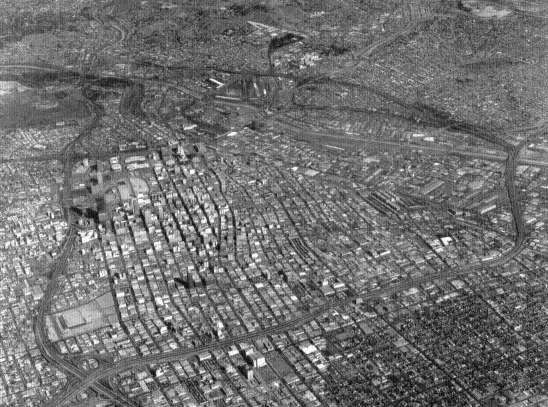
72.
Downtown Los Angeles Freeway Circuit, 1970
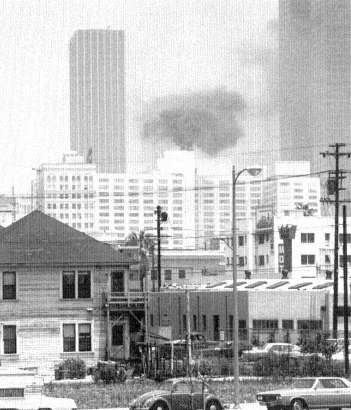
73.
Looking Downtown from the Convention Center, 1971
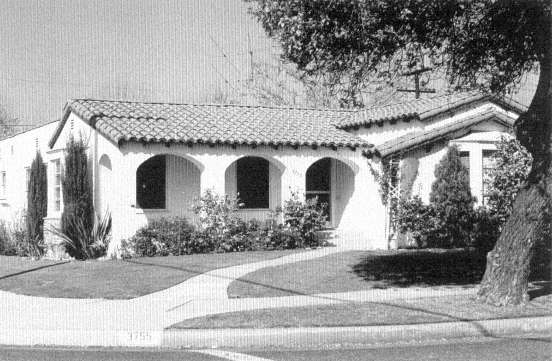
74.
Raymond Avenue, Los Angeles, 1971
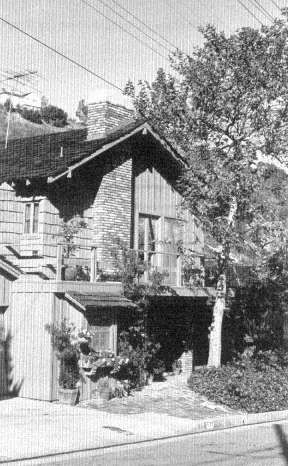
75.
Stone Canyon, Sherman Oaks, 1970
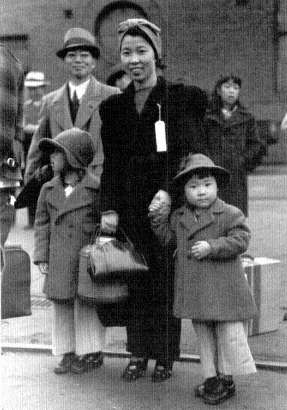
76.
Japanese-Americans Awaiting Removal to Concentration Camps, Los Angeles, 1942
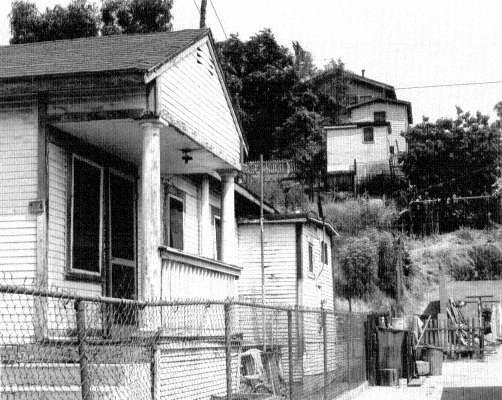
77.
Boyle Heights, Los Angeles, 1971
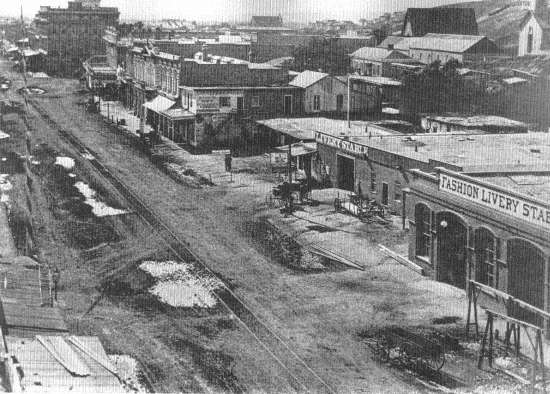
78.
Main Street, Los Angeles, ca. 1875
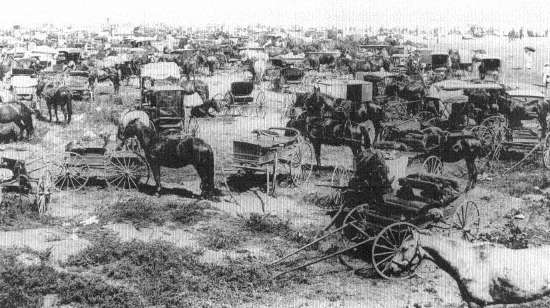
79.
"Parking Lot" at Long Beach, 1905
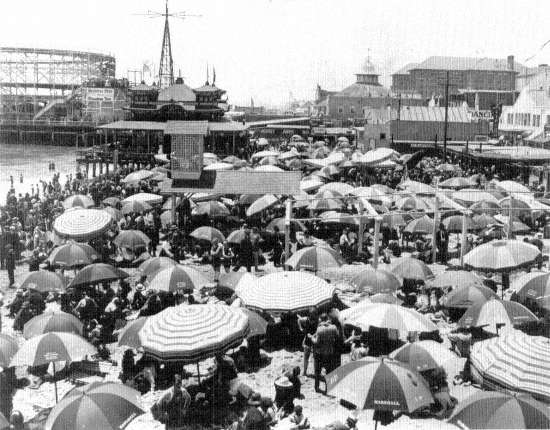
80.
Streetcar Beach, Long Beach, ca. 1920
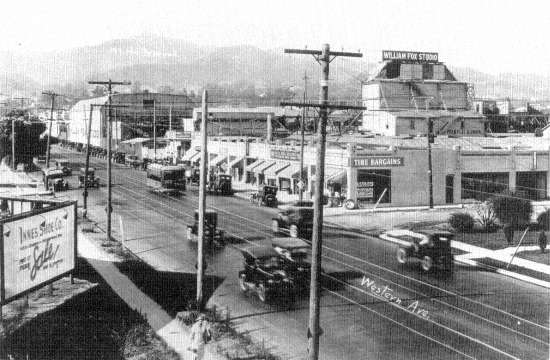
81.
William Fox Studio, Los Angeles, 1927
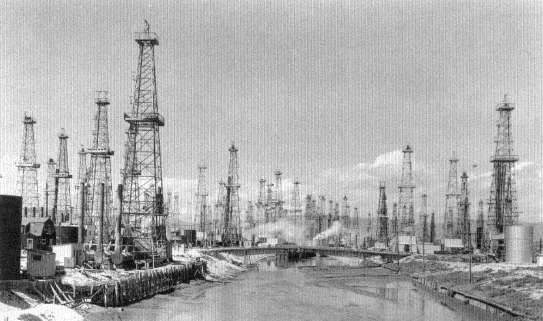
82.
Del Rey Oil Fields, Los Angeles, 1930
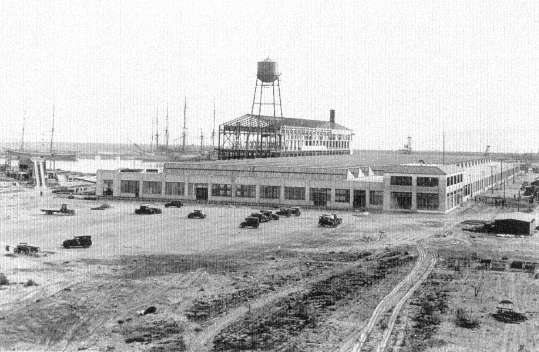
83.
Ford Assembly Plant, Long Beach, 1929
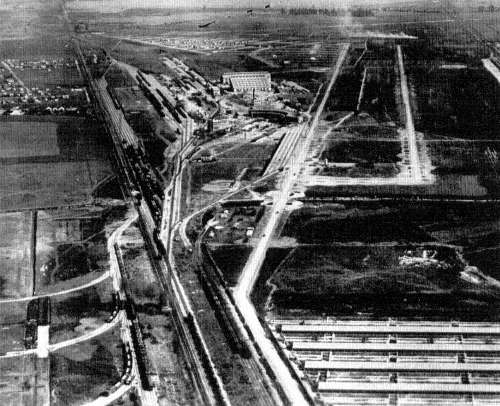
84.
Union Pacific Industrial Area, Vernon, 1924
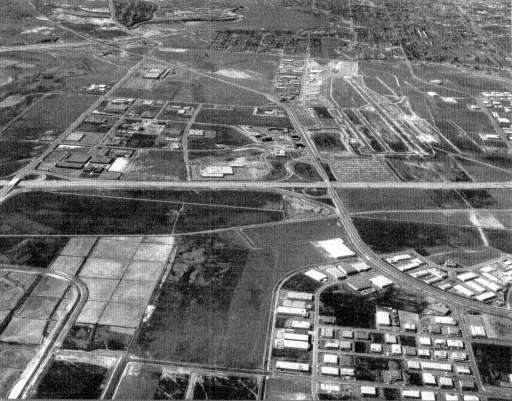
85.
Irvine Industrial Park, 1971
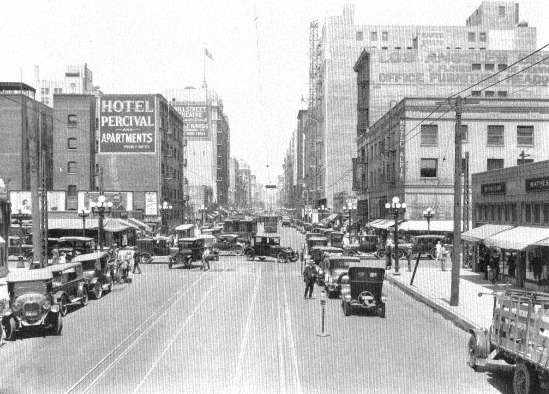
86.
Hill and 9th Streets, Downtown Los Angeles, 1924
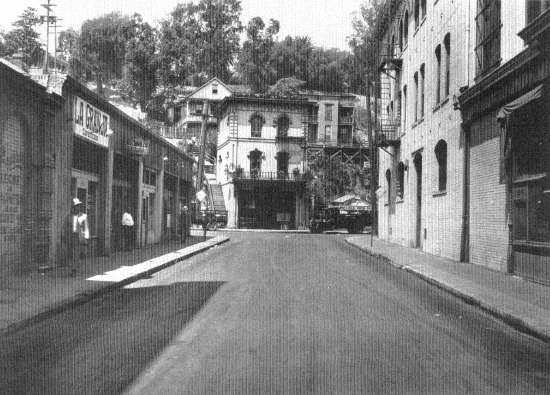
87.
Republic and New High Streets, Los Angeles, ca. 1925
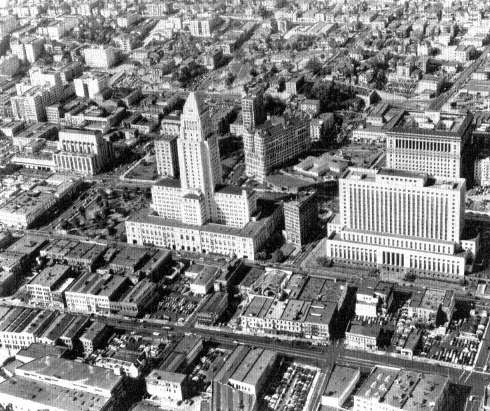
88.
Beginnings of the Civic Center, Los Angeles, 1940
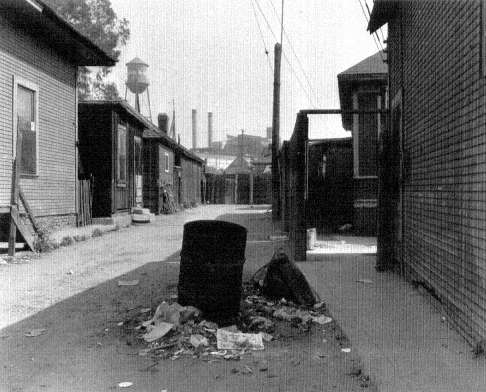
89.
A Quarter of a Mile from City Hall, Los Angeles, 1936
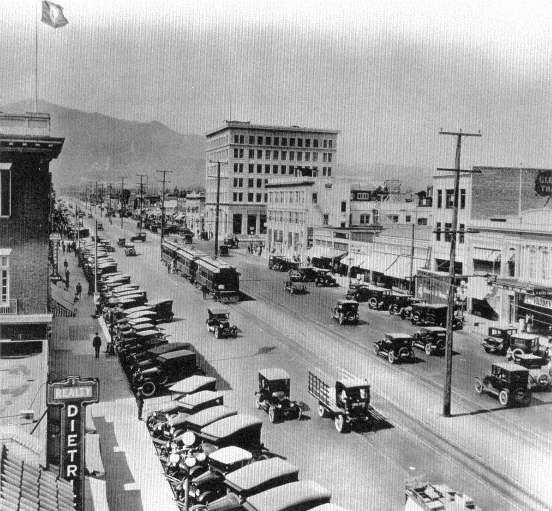
90.
Brand Boulevard, Glendale, ca. 1926
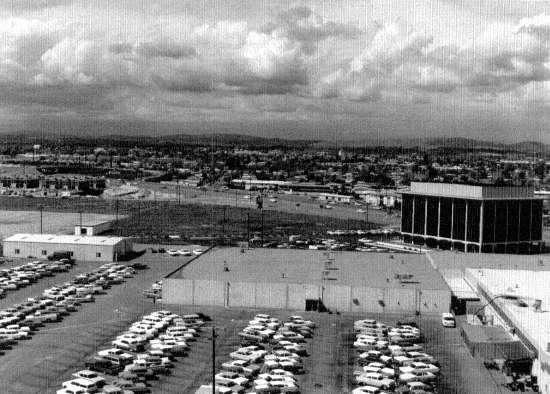
91.
Manchester Avenue and Santa Ana Freeway, Anaheim, 1965
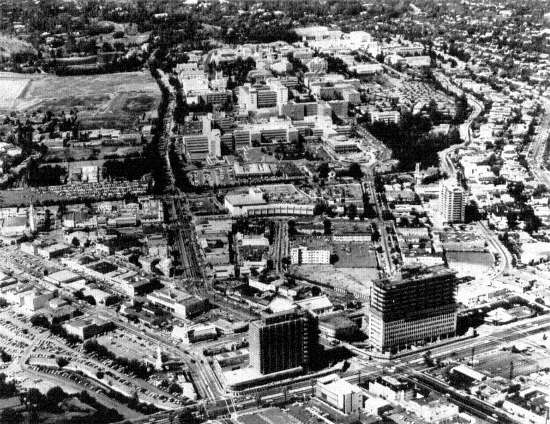
92.
Westwood Village, Los Angeles, ca. 1965
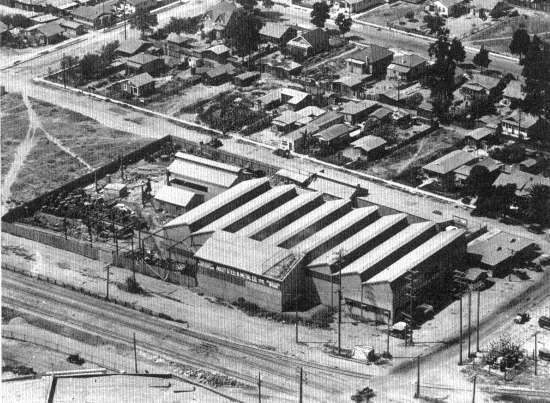
93.
Working-Class Housing, Los Angeles, ca. 1930
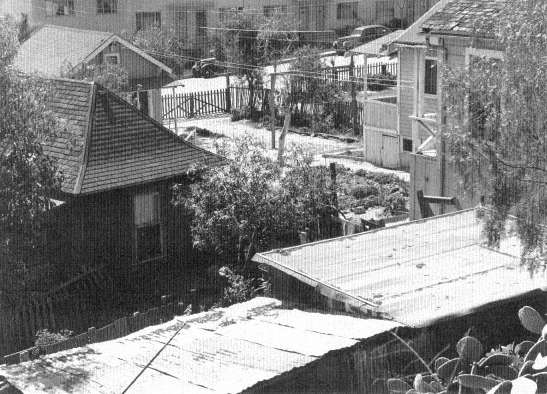
94.
Yards in Colon Street, Wilmington, 1945

95.
Whittier Boulevard, East Los Angeles, 1924
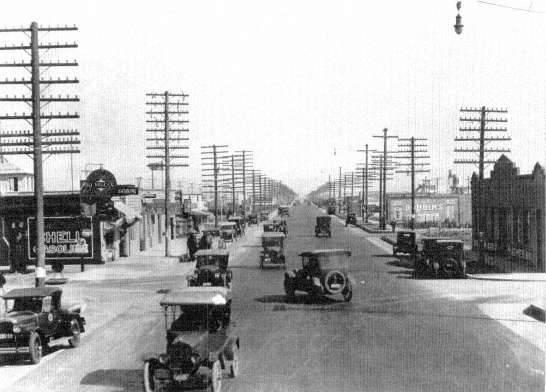
96.
Whittier Boulevard, Belvedere, ca. 1924
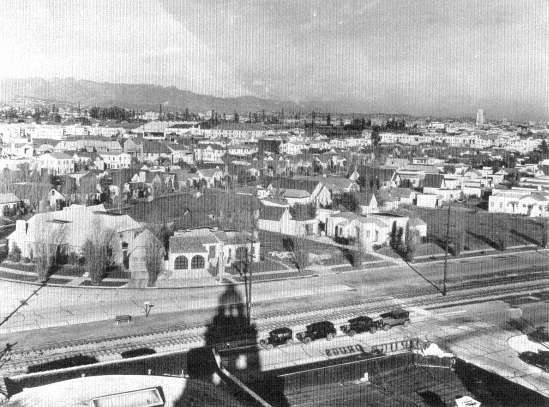
97.
San Vicente Boulevard, Los Angeles, 1929
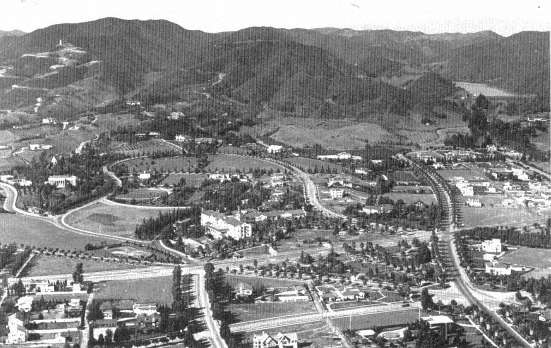
98.
Sunset and Beverly Boulevards, Beverly Hills, 1924

99.
Court, Boyle Heights, Los Angeles, 1971
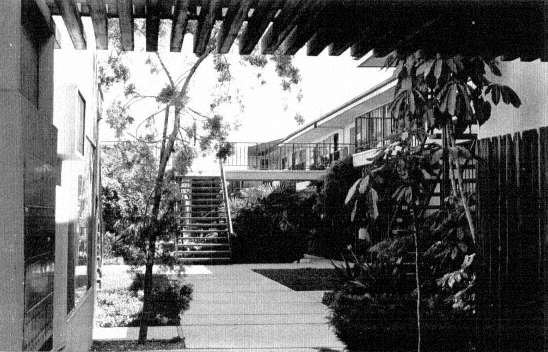
100.
Court, Baldwin Hills, Los Angeles, 1971
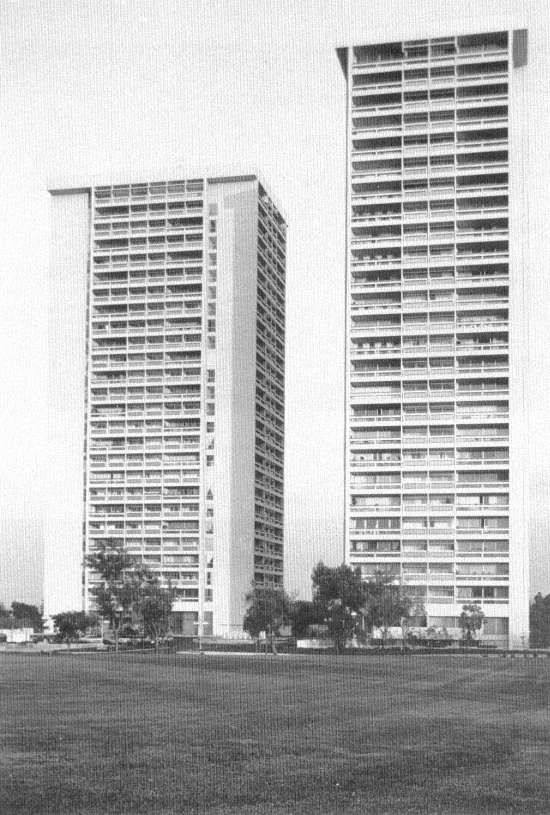
101.
Apartment Towers, Century City, Los Angeles, 1971
a widely diversified metropolis given over to manufacturing, commerce, service, and war production.[33]
During the twenties and thirties, irrigated agriculture, oil discoveries, the motion-picture boom, and waves of Midwestern and Texan migrants seeking a pleasant place to live and work swelled the city's size. Oil revenues in part financed the construction of an ocean port at Long Beach, and favorable rail connections to the Southwest and the East (the city lies a few miles closer to Chicago than San Francisco does) made Los Angeles a preferred site for warehouses and branch plants of national corporations. During the twenties, for example, both Ford and Goodyear built Pacific plants there, and many other firms followed suit. But the city was handicapped by the circumstance that its factories were some two thousand miles from the western edge of the Midwestern manufacturing belt at St. Louis. Therefore the sectors of the metropolitan economy devoted to general machinery and metalworking—sectors of vital importance to a fully elaborated industrial region—did not develop during these years. Los Angeles in 1940, for all its impressive size, was not yet committed to manufacturing.[34]
Thirty years of almost continuous hot and cold wars ended this anomaly. Tremendous aircraft orders from the federal government not only caused that particular industry to shoot ahead, but federal sponsorship of aerospace research and all sorts of war material fostered supportive manufacturing, until today the city is the only fully diversified manufacturing region outside the belts of the Northeast and Midwest. To be sure, Los Angeles still has its agricultural, aircraft, electronic, and movie specialties, just as Chicago still concentrates on steel, machinery, and printing and New York on garments, leather, printing, electrical equipment, and national offices, but since the 1950s a full range of complementarities has been available in Los Angeles to boost further expansion.[35]
Three special characteristics of the Los Angeles metropolis stand out by comparison with the earlier examples of New York and Chicago:
[33] . Perloff et al., Regions, Resources, and Economic Growth , pp. 462, 465, 471-75.
[34] . Frank L. Kidner and Philip Neff, An Economic Survey of the Los Angeles Area , Los Angeles, 1945, pp. 1-26; Robert M. Fogelson, The Fragmented Metropolis, Los Angeles 1850-1930 , Cambridge, 1967, pp. 108-34.
[35] . U.S. Bureau of the Census, Census of Manufactures, 1967, Summary Series: General Summary MC 67 (1)-1 , Washington, 1970, Table 2; Census of Manufactures, 1967, Area Series: California, Illinois, New York, MC 67 (3)-5,-14,-33 , Washington, 1970, Table 6.
its high degree of spatial freedom, its potential for a more equitable and inclusive class and racial society, and its growth in response to deliberate federal programs.
The land-use and transportation structure of Los Angeles gives glimpses of a more humane environment than we have yet enjoyed. The special factor of the city's social geography is its low density of settlement, the ease and scope of movement of the overwhelming proportion of its citizens, and its comparative lack of domination by a single downtown area. It has thus escaped the rigid core, sector, and ring structure of business and residential occupation that tyrannized the industrial metropolis and from which older cities are only now beginning to extricate themselves. Los Angeles is an amorphous metropolis, and vast tracts of it have a rather uniform low-density settlement of five to twenty-four persons per acre. Along the Pacific in the Santa Monica and Long Beach areas and in a crescent of housing from Santa Monica through Beverly Hills to the old core city there are apartment houses and multiple-dwelling neighborhoods that resemble those in Chicago or New York. Also scattered through the metropolis, especially along its shopping strips, stand many of the motel-like courts that are the contemporary slum-tenement style of the American city; but the single-family dwelling has long been the glory of Los Angeles and the expression of its design for living. Sixty-four percent of all its occupied housing in 1967 was given over to single-family dwelling units.[36]
The plan for a metropolis composed of single-family houses did not emerge from the drawing boards of freeway engineers; their constructions followed an already entrenched preference of the Angelenos. During the twenties three social factors had converged to establish the Los Angeles plan: the cultural preference of Americans for detached private homes, the need to supply water for burgeoning land development, and the sheer pleasure and freedom bestowed by the automobile.
Three out of four of the army of migrants who came into southern California during the early part of the twentieth century were white native-born Americans from the cities to the east and from the farms and small towns of the Midwest.[37] City dwellers and farmers alike brought with them an ingrained tradition of the single-family house as
[36] . Los Angeles Regional Transportation Study, "1967 Origin-Destination Survey, Summary of Findings," Draft, November 18, 1970, p. 31.
[37] . Stephan Thernstrom, The Growth of Los Angeles in Historical Perspective: Myth and Reality , Institute of Government and Public Affairs, University of California, Los Angeles, 1970, pp. 8-11.
the measure of a home and of Main Street or suburbia as the measure of satisfactory living. The American has often had to share his housing with others—in rented rooms, in two-family houses, in tenements of three, six, or more flats—but given the opportunity he has customarily sought a house of his own. Moreover, just as in the case of Chicago's middle class, in the Los Angeles region no thirst for the big-city life of skyscrapers, restaurants, and theaters has tempted him to sacrifice the privacy of a tree-shaded lawn and garden for apartment luxury or for the urban habits of the nineteenth-century inhabitants of European or American industrial cities. In sum, people came to southern California seeking a warm, sunlit, home-town city.
To provide these amenities in the first decades of the twentieth century in the face of the aridity of Los Angeles, residential property carried high land-preparation costs and so had to be developed in tracts of considerable size. An expensive water supply had to be meshed with public transportation to a degree unheard-of in the modest subdivisions common in Eastern cities. Speculators capitalized on the situation by building a wide-range complex of electric interurban streetcars. They hoped that their initial investment in lines that stretched from twenty to thirty-five miles out from the downtown area would be justified by massive profits from future land development and ensuing heavy traffic on their routes. Los Angeles in 1920, compared to other cities of the period, was extraordinarily extended into large-scale suburban development.[38]
The automotive boom of the twenties carried these trends toward diffusion to modern proportions. The general ownership of automobiles and their use in commuting allowed developers to open up smaller tracts beyond walking distance from the interurbans. When these lines began to lose money from competition with automobiles and when traffic jams in downtown Los Angeles became intolerable, the municipality called for the construction of a rapid-transit system to alleviate traffic, revitalize the street railways, and save the downtown. Other cities had voted for subways in the twenties, but Los Angeles did not follow the precedents; its citizens voted down the proposals. Their city was so new and open that they had no image before them of a desirable downtown, and they had no habit of listening to the appeals of downtown business leaders.
[38] . Fogelson, Fragmented Metropolis , pp. 85-107; Kelker, De Leuw & Co., Report and Recommendations on a Comprehensive Transit Plan for the City and County of Los Angeles , Chicago, 1925, plates 12, 18.
Then, too, their tradition told them that happiness lay in another style of life.[39]
During the Great Depression the public transportation system cut back its service, and after World War II the interurban lines closed down; today the public bus lines handle a small volume of passengers—400,000 fewer than in 1939. Without the discipline of street railways, commerce drained from the core city to spread out along strips of land like Wilshire Boulevard. Suburban towns like Glendale and Pasadena established their own downtowns, and suburban shopping centers and office clusters have sprung up to form a multicentered metropolis.[40]
The key decision in the determination of the spatial freedom of its residents came in 1939, when the Los Angeles Freeway plans were settled into a multicentered pattern. A failing public transit, serious traffic jams, and a new state statute that permitted construction of limited-access highways had prompted the City of Los Angeles to commission still another study of its transportation problems. The Works Progress Administration of the federal government carried out a traffic census, and on the basis of these findings the City of Los Angeles Transportation and Engineering Board made its recommendations; freeways would be the solution to the region's traffic difficulties. The unusual multicity and multicounty membership of the advisory board may have accounted for its metropolitan orientation. Besides Los Angeles officials, representatives from such scattered places as Glendale, Beverly Hills, Redondo Beach, Huntington Beach, Whittier, Pasadena, and the San Fernando and San Gabriel valleys sat on the board. The 1939 plan called for limited-access express highways to be laid out in the form of a giant grid, which would be capable of carrying automobile traffic both into and out of the overcrowded Los Angeles central business district and would guide it across the city without the necessity of its going through the downtown area. The principal justification for this plan was the board's recognition of the already highly dispersed character of the region. Many of its alignments were to follow the much-traveled state highways that crisscrossed the area. The report may well have reflected too the politics of the Transportation Board itself. Although no record survives of its discussions, it seems highly probable that the members
[39] . Reyner Banham, Los Angeles: The Architecture of Four Ecologies , New York, 1972.
[40] . Fogelson, Fragmented Metropolis , pp. 164-85; Pacific Southwest Academy of Political and Social Science, Los Angeles, Preface to a Master Plan, Publication 19 , Los Angeles, 1941, pp. 47-53, 161-68, 173-88.
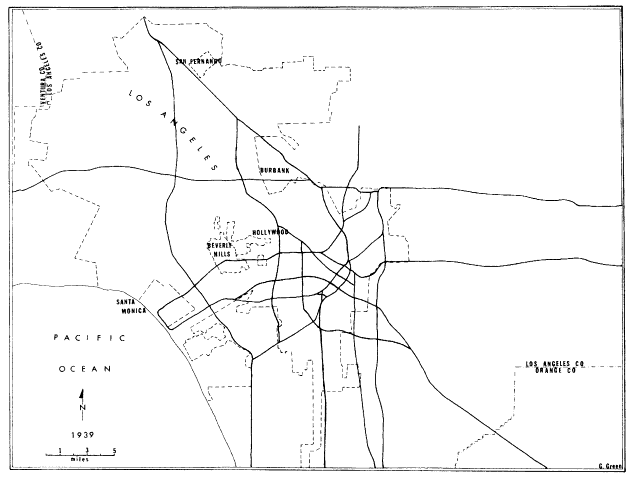
Figure VI.
Los Angeles Freeway Plan of 1939
SOURCE: City of LOS Angeles, Transportation and Engineering Board,
A Transit Program for the Los Angeles Metropolitan Area , Los Angeles, December, 1939.
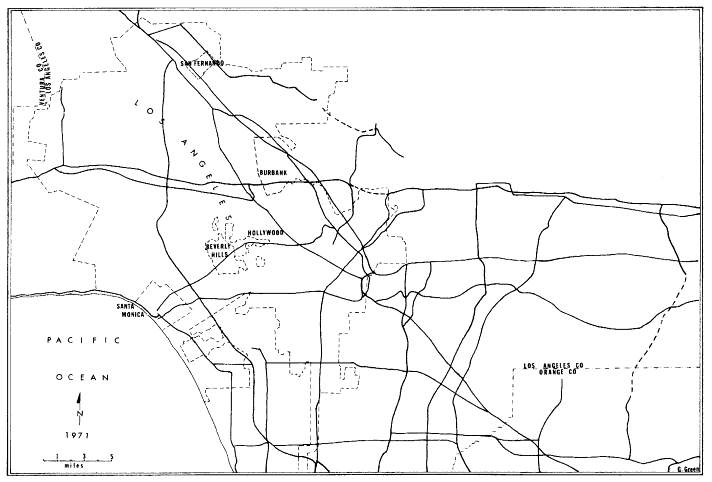
Figure VII.
Los Angeles Freeways in Operation, 1971
SOURCE: California Department of Public Works, Division of Highways,
District VII Freeway and Expressway System Map , Los Angeles, January, 1971.
from the more distant areas would not have accepted the conventional hub-and-wheel design that was at this time being proposed for old American single-core cities, since such a plan would have drawn business away from their own centers. The board did expect, however, that Los Angeles would eventually grow to be a conventional single-centered city and that in time commuter railroads and subways would be required.[41]
The 1939 proposal for freeways derives its historical importance from the fact that it was subsequently adopted and adapted in a succession of plans and projects. The first undertakings, begun in 1940 with the Pasadena Freeway, all converged on the downtown (the Hollywood, San Bernardino, Santa Aria, and Harbor Freeways), thereby beginning a radial scheme for serving the downtown, but wartime and postwar planning studies continued to repeat the basic grid strategy of the 1939 report. Then in 1956, when the federal government passed its Interstate Highway law, the California legislature set up a committee to establish routes for the state. The routes that were then adopted incorporated the 1939 proposal for a grid system of metropolitan freeways, and many such highways have been built in the ensuing years.[42] The grid is still being extended at its outer margins in order to keep up with the spread of the metropolis, and it is being added to at the center to relieve traffic congestion further, but for many years now Los Angeles has enjoyed a transportation system that permits its residents to move swiftly from subcenter to subcenter over the entire region without having to go through the downtown or any lesser center.[43]
The social consequences of the multicentered, low-density metropolitan region are manifold and are important to our urban future. First and foremost was the increase in the job choices offered the urban resi-
[41] . City of Los Angeles, Transportation and Engineering Board, A Transit Program for the Los Angeles Metropolitan Area , Los Angeles, December 1939; "California Highways . . . 1964," California Highways and Public Works , 43 (November-December 1964), 5-12.
[42] . Los Angeles Metropolitan Parkway Engineering Committee, Interregional, Regional, Metropolitan Parkways , Mimeographed March 30, 1946, Los Angeles Regional Transportation Study Library, pp. 1, 5; "Freeway Development on Highways of California," California Highways and Public Works , 24 (January-February 1946), 30-34; "Report from District VII," California Highways and Public Works , 37 (January-February 1958), 2-16; California Department of Public Works, Division of Highways, The California Freeway System, Report to the Joint Interim Committee on Highway Problems , Sacramento, September 1958, p. 18.
[43] . California Department of Public Works, Division of Highways, District 7 Freeway and Expressway System Map , Los Angeles, January 1971.
dent. In 1967 there were three automobiles for every seven persons in the Los Angeles region; 41 percent of the households had access to one vehicle, 44 percent had access to two or more vehicles, and only 15 percent of the households lacked a car.[44] Such a distribution of automobiles and freeways gives the Los Angeles employee the widest choice of job opportunities ever possible in an American city. An hour's drive from any point in the region makes hundreds of possible employers accessible. A man can live in the San Fernando Valley and work in the old industrial sector of southeast Los Angeles, or he can commute from the old core-city neighborhoods to the new steel mills at Fontana. These are extreme commuting distances, to be sure, but recent studies show that blue-collar workers in particular are crisscrossing the whole area in search of the best jobs.[45] In the past urban workers were pinned down to living next to their mills, or they purchased their economic freedom by commuting from crowded core-city working-class and slum districts along the radial lines of the streetcar system. These journeys were long, the cars crowded and slow, and transfers and waits in the cold and wet often necessary. Such trials cannot be compared with the ease of an hour's run today in a private car or car pool. In Los Angeles most commuters go directly from their home to the company parking lot, and the majority travel alone; more than 70 percent of all weekday automobile trips are taken by a single driver.[46]
To this economic freedom must be added the social advantages that have accrued to the Los Angeles public. The greater number of car trips are not work-related at all but are undertaken for social or recreational purposes or for shopping. Thus scattered friends and relatives, long shopping strips and outlying shopping centers, the Pacific beaches, and national parks are all within easy reach of most families. At the same time the city is able to grow by continuing to build in its low-density popular single-family or low-rise apartment-court style.
Like all American cities, the Los Angeles automobile metropolis does not extend its amenities equally to all its residents but reinforces sharp differences governed by class and race. Boyle Heights, an early twentieth-century neighborhood in East Los Angeles, offers some of the attractions of small-town life to its Mexican-American residents. Watts
[44] . LARTS, "1967 Origin-Destination Survey," p. 33.
[45] . Lawrence E. Maxwell, "Residential Distribution of Occupations in Los Angeles," unpublished M.A. thesis, University of California at Los Angeles, 1966, pp. 60-64, 70, Map 5.
[46] . LARTS, "1967 Origin-Destination Survey," pp. 39-41.
and the black ghetto have many of the same features. Yet the poor, lacking cars and perhaps also fearful of their reception in other parts of the metropolis, do not travel over large sections of the region as residents of the San Fernando Valley might do.[47] Women and old people especially suffer from a dearth of cars. The women thus lack access to jobs that would boost family income, and to essential shopping and health services. For the men, transportation doesn't seem to be the problem. Once they find employment they seem to be able to purchase cars on time.[48]
The solution to the disadvantaged position of those without cars is neither difficult nor expensive, but like all our cities Los Angeles remains heedless of the needs and suffering of its poor, its blacks, its Mexican Americans, and its old people. After the Watts riot the transportation problems of the poor were made plain, and the state of California, with federal funding, set up a demonstration project in southeast Los Angeles to attempt to deal with the problem. A social science team intervened in behalf of the poor in several ways. They became the spokesmen of the neighborhoods before the bus companies; they waged campaigns to have route maps printed and distributed and to persuade the companies to post the schedules at the bus stops. They discovered that the last bus might leave a factory's gates a few minutes before the men finished their daily shifts; they discovered routes that could be instituted or altered to reflect the commuting habits of the residents. It seems clear from the findings of this team that the cost cutting of private and public bus companies should be monitored in every city by a political agency representing the transportation interests of those outside the circle of the automobile world. The altering of existing public transportation, however, was not sufficient. The women needed short runs along shopping strips and to shopping centers and they needed long trips in every direction to reach scattered job sites. To this end the experiment rented buses for some new regular routes and also used station wagons and cars for a kind of metropolitan taxi service
[47] . City of Los Angeles, Department of City Planning, The Visual Environment of Los Angeles , Los Angeles, April 1971, pp. 9-11; this seems to be a worldwide phenomenon in modern cities accounted for largely by the failure of old rapid-transit systems to keep pace with the growth of cities. "Cars or Busses?" The Economist , 240 (August 14, 1971), 48-51.
[48] . State of California, Business and Transportation Agency, Transportation-Employment Project, Interim Final Report , Los Angeles, January, 1970, pp. 15, 27-30, 98; U.S. Department of Labor Statistics, Employment and Unemployment in East and South Los Angeles, Regional Report No. 14 , San Francisco, 1971, p. 21.
to jobs at such widely dispersed destinations as Lockheed in Burbank, Douglas Aircraft at Long Beach, Torrence, and Santa Monica, American Electric at La Mirada, and Sergent-Fletcher in El Monte. The cost of these services was high, but could have been much reduced if established permanently. The demonstration project was a success, but in 1971, when the funds were gone, predictably the grant by the federal government was not renewed and the service closed down.[49]
Judging from this experience, a few millions of dollars a year spent in maintaining an agency to represent the carless and offer its own flexible small-bus service would redress the worst of the access problems attendant on Los Angeles' unequal distribution of family income. To be sure, those without cars are the ones who suffer most from low wages, from job discrimination against women, old people, blacks, and the ill-educated, and from regional and national callousness toward the unemployed and the underemployed, but even a modest effort would be far more useful to the poor than the currently fashionable enthusiasm for rail lines. Railroads by their very nature offer high-volume service only along their own narrow strip. Los Angeles is neither a linear nor a radial city; it is a multicentered city that calls for multidestination public transportation.
Finally, although Los Angeles does not have the problem of choking traffic jams and hard-to-reach areas like those of New York, it does have a serious air-pollution problem. In view of the enormous investment and great social success of the freeways, it seems foolish not to try to eliminate the smog in similar terms. Surely the technology of the moon era is capable of manufacturing low-emission engines as an alternative to the present disgraceful pollution created by Los Angeles' 4.5 million automobiles.
Since all of the metropolises and the three megalopolises of the United States are growing into the form of Los Angeles, it is important that we understand the social potential of this diffuse layout of building. The open character of Los Angeles has resulted in a land-use structure more favorable for the achievement of racial and class justice than any that has so far existed in any large American city. This structure is only a potential for justice, however, and remains far from realization.
Los Angeles is no better than most cities when it comes to racial discrimination, segregation, and disadvantages for its poor. The county
[49] . California Business and Transportation Agency, Interim Final Report , pp. 85-90.
population is 10.8 percent black, 13.5 percent of Spanish surname. The isolation of blacks is almost as extreme as in Chicago. The Mexican Americans are less rigidly segregated from the Anglo Americans than are the blacks, but nonetheless they are highly segregated.[50] When the frustration of the black community exploded with the Watts riots of 1965, a national chain reaction was set in motion, and since that time there have been a number of Mexican-American riots expressing the conflicts of another disadvantaged community. All the hostility and failings of our society, so fully documented in 1968 by the Kerner Commission and in other reports, are part of Los Angeles as well. But if it wishes to build a more inclusive society, it has a special advantage in the availability of land for redevelopment and in abundant fringe land for new construction. The prerequisite for making good use of the land in terms of its society is a commitment by the national government and the Los Angeles public and its officials to make a decent house and neighborhood open to every resident. With such a commitment, new housing can become the framework for an inclusive urban society, rejecting the city's present mechanism for class, racial, and ethnic segregation.
The original low density of Los Angeles' construction has saved it from mortgaging its future. Its built-up areas are not so crammed with structures that new construction in old areas brings serious dislocation of present residents, as is the case in Chicago or New York. There is vacant land all over the Los Angeles region. This land is in the form of weedy lots and unused spaces, some large enough for development in their own right, some requiring some demolition of adjacent houses. If public agencies were to build on five-acre tracts they would find land, either vacant or sparsely occupied, by the hundreds of parcels all over the city. Such land is ideal for the design and construction of low-rise apartments, two-family housing, and town houses. In other words, existing styles of housing could become the basis for a massive public housing program that would not disrupt the physical fabric of the city. Federal programs for land clearance, housing, and rent subsidies allow such housing to be offered today to the fourth of the Los Angeles population who cannot afford decent housing at present prices. Such
[50] . Los Angeles County, Human Relations Commission, "Population by Major Ethnic Grouping, Los Angeles County, 1950, 1960, 1970, Projection for 1980," HRC Research , June 1971; Leo Grebler, Joan W. Moore, and Ralph C. Guzman, The Mexican-American People , New York, 1970, pp. 274-78; City of Los Angeles, Community Analysis Bureau, State of the City, Conditions of Blight and Obsolescence , Los Angeles, 1970, pp. 72-73.
federal programs, however, would have to be so funded as to allow for a large-scale and sustained undertaking.[51]
At least three important social consequences would be derived from such a small-parcel program. First, the chronic shortage of low-income housing would be relieved. Second, the abundance of scattered sites would enable blacks, Mexican Americans, and the poor to choose to settle either near their present neighborhoods or in new distant sections of the city. The degree of social pioneering undertaken by any family would be according to their own choice and would not depend on the decision of public authorities. Third, the five-acre tracts would have to be designed to fit into the styles prevailing in their environs or else face strong local opposition. Perhaps this requirement that design attain at least the levels of popular taste would save the projects from the degradation of some of the philanthropic architectural styles that now stigmatize public housing.
At its fringes the Los Angeles freeway brings large tracts of vacant land within the reach of commuters. This same situation prevails in the Eastern and Midwestern megalopolis and all metropolises. Here publicly sponsored or managed new towns of 50,000 to 200,000 residents could be used as a device for increasing the residential options of black and low-income families. The key advantage of the new-town concept, or entire-city building scheme, over the conventional suburban subdivision lies in its coordination of public facilities with employment and housing. The new town can be built around industries to provide jobs for a range of skills and classes. The schools and health services can be built in the beginning so that the residents do not create unnecessary conflict by overloading small local community services. Finally, because these would be large projects, the social engineering of building at all class levels would become feasible. Los Angeles is currently building a beautiful new town at Irvine. Its extent is 53,000 acres, and it will ultimately hold 430,000 inhabitants.[52] It has jobs, recreation, an airport, and community facilities laid out in such a way that the native California land form is undisturbed. It is a brilliant example of the advantage of large-scale new-town development over the spread of subdivisions. Despite all this, Irvine is a social scandal—an all-white, upper-middle-class enclave. It is exactly the sort of project that at once shows the high
[51] . Regional Planning Commission, County of Los Angeles, Environmental Development Guide , Revised Draft, Los Angeles, September 1, 1970, pp. 64—75.
[52] . Irvine World News , April, 1970.
potential of the new metropolis and its bigoted, class-bound failure to realize that potential.
Finally, Los Angeles should be understood as an outstanding example of regional and national planning. Its port at Long Beach, its interstate water-supply system, and its national parks and forests are excellent examples of well-designed and coordinated large-scale planning. Its war-stimulated growth is of interest precisely because it demonstrates an important but as yet little exercised capability of the federal government to influence the prosperity of a metropolitan region. The Los Angeles experience shows that we have depressed cities and depressed regions only because we have chosen to let them go unattended.
Several principles governing a successful national urban policy can be derived from the federal sponsorship in Los Angeles. First, federal orders for products and services, direct intervention in the construction of plants, and long-term aid in the building of water and electric facilities encouraged and sustained its growth.[53] In the case of huge aircraft orders and the subsequent erection of aircraft plants with federal funds, the investment helped an industry that had already taken root to settle in more firmly. The additional contracts in the fields of aerospace and war material were instrumental in bringing the blossoming electronics industry into the city from the East.
Second, the magnitude of orders and assistance exceeded any later federal attempts to foster business in depressed areas through favored purchasing, small-business loans, and Office of Economic Opportunity programs. Aside from the money spent for war material, tools were being forged here for a national policy directed to urban growth and regional employment guidance, but our low-key use of these tools and our compulsion to tie them to the Congressional pork barrel have rendered them ineffective.[54]
Third, the federal infusion of capital into the area continued over a long period—at least thirty years—without serious interruption, so that the war specialties of Los Angeles have been consistently nourished.
Fourth, the Los Angeles case showed that special institutions could be used to upgrade a regional labor force that had been neither particularly skilled nor outstandingly intelligent. The government sponsored here the foundation of nonprofit research and development corpora-
[53] . Kidner and Neff, Survey of the Los Angeles Area , pp. 101-3.
[54] . Lloyd Rodwin, Nations and Cities, A Comparison of Strategies for Urban Growth , Boston, 1970, pp. 222-35.
tions, such as RAND and the Systems Development Corporation, to supplement the educational and research capabilities of the California Institute of Technology, the University of Southern California, and the University of California. These additional institutions, by attracting scientists and engineers to the region, did much to accelerate the city's movement into higher levels of technology, and at a pace more rapid than would have prevailed if the city had depended only upon its universities and the technical staffs of resident aircraft and electronic concerns.[55] In the Boston metropolitan region, similar paramilitary institutions helped raise the level of a management and labor force formerly connected to the dragging textile industry, and it seems probable that the Houston Manned Spacecraft Center will have the same effect in Texas. These instances suggest that the federal government could create research and service institutions for civilians as a device to upgrade the industries and labor forces of such places as Atlanta, Chicago, Detroit, and New York.
Fifth and finally, the federal investment in Los Angeles, moved by an unconscious planning wisdom, supplemented and stimulated an existing trend. There was no effort to reverse the path of popular migration or to go against the locational trends of the economy as might have been the case in such places as Appalachia or East St. Louis, Illinois. It is obvious that to roll with the economy, to relieve temporary distress, and to help people to move is a prerequisite for national urban programs.
What the federal effort in Los Angeles lacked was self-conscious dedication. The United States has the tools to plan its regional and national urban growth through the twin job-awarding devices of the giant corporation and the federal budget. Since World War II the magnitude of the corporate and federal effort has in large measure determined the national location of jobs;[56] it has designated the industries and places where jobs would be plentiful and where they would be sparse. The depressed condition of the core of New York City is a casualty of the federal and corporate concentration on war just as surely as the prosperity of Los Angeles is its hero. If we are to mitigate the appalling human waste and suffering of our cities, both institutions must be made
[55] . Christopher Rand, Los Angeles, The Ultimate City , New York, 1967, pp. 72-100.
[56] . Murray L. Weidenbaum, Federal Budgeting, The Choice of Government Programs , Washington, 1964, pp. 4-22; Douglass B. Lee, Jr., and John W. Dyckman, "Economic Impacts of the Vietnam War: A Primer," Journal of the American Institute of Planners , 36 (September 1970), 298-309.
to act as self-conscious agents of urban reordering. The federal government must follow European examples by adopting a carefully considered, politically viable policy for urban growth so that the modernization of our cities and our economy can go forward more humanely; the corporations must be socialized to the point at which they can be held accountable for the public consequences of their behavior. Like the legitimate demands for decent work, comfortable housing, and an open inclusive society, the promise of today's economy and its cities will not be realized unless the American public demands that government and business serve the goals of a humane society.